
allaboutpai.com → Introduction
Introduction to Pai
Last Update: February 2019| Support This Site | If you have enjoyed this site, here are a few ways that you can help me get time to expand it further: |
 | Use your credit card or PayPal to donate in support of the site. |
 | Use this link to Amazon—you pay the same, I get 4%. |
 | Learn Thai with my Talking Thai-English-Thai Dictionary app: iOS, Android, Windows. |
 | Experience Thailand richly with my Talking Thai-English-Thai Phrasebook app. |
 | Visit China easily with my Talking Chinese-English-Chinese Phrasebook app. |
 | I co-authored this bilingual cultural guide to Thai-Western romantic relationships. |
If you have enjoyed this site, here are a few ways that you can help me get time to expand it further:
Table of Contents
- What's Pai?
- Nature
- The Ride to Pai
- Guesthouses in Pai—Bamboo Hut Variety
- Random Bamboo Art
- Guesthouses in Pai—Concrete
- Scenes in Downtown Pai
- Scenes in Vieng Neuea Village
- Music and Nightlife
- Moon Village
- Follow the Bird (Bird's Eye View)
- Mae Yen Temple
- Mae Yen Waterfall
- Bpang Dtong Karen Village
- The Police of People—Really?
- "Development"
- Special 2008-2012 Update: Pai Is Over
- 2012-2015 Update: The Chinese Invasion
- My House in Vieng Neuea Village
- Living in Pai
- The Future of Pai
- Pai Floods of 2005
- Projects from Other Pai Citizens
What's Pai?
In 2003 I embarked on my sixth trip to Thailand with a goal to find a place where I could stay comfortably for a long time (including the hot season, which has smoked me out of Thailand 3 years running), relax a lot, and also continue to develop my tiny software businesses (Word in the Hand, which makes Thai<->English software dictionaries, Lurkertech, and a few other projects) over the Internet in order to fund my cost of living. On December 21st, 2003, I board the ancient, solid-steel, fume-spewing third-class bus which plies its way through the steep, windy mountain roads of northern Thailand from Chiang Mai to Pai. I switch out of tourist mode and stay in Pai for months years, renting a house long-term and taking only occasional trips out of town.
Pai is pronounced exactly like the word 'spy' without the 's': more of a popping 'b' than a 'p' (you can learn about Thai sounds here).
Pai is located about at the green star on this map, stolen from the Lonely Planet website:
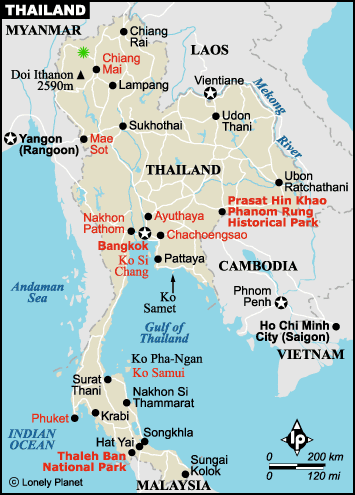
Pai in Thailand
Thailand or Not?
As described in a previous journal entry, most which I will repeat and elaborate on here, Pai is a small, rural mountain town with an interesting mix of Thais, short-term Thai and farang (non-asian foreign) tourists, and long-term expatriate foreigners. The many cultures blend together here in an interesting way, as opposed to most places in Thailand, where large numbers of farangs just bring forth more scamming tuk-tuk drivers, McDonald's restaurants and go-go bars. In fact, there are no tuk-tuks at all, not even the ubiquitous KFC or Lotus/TESCO chains have an outpost here (though 7-11 invaded in August 2004), and if there is any prostitution here, it is well-hidden.Pai has a reputation for music and other forms of art, and many folks come with their instruments or their work and share it with others. Pai has plenty of hippie culture, yoga, reiki, cleansings, shiatsu, acupuncture, other forms of mysticism, cultish behavior, and soft drugs. It would be easy to dismiss the place as a white hippie haven and look no further. However once you get here, the place begins to challenge your assumptions. You find Thais and farangs wailing out blues music nightly in a bar straight out of New Orleans, fifty-something farangs living in hill tribes building export businesses to support their village, Thai street vendors eagerly learning how to make the country's best falafel, hummus, and tahini from hordes of Israeli travellers, war-torn military veterans looking for a peaceful and quiet place to live out the rest of their life, young Bangkok Thais who rejected their metropolitan hell to come live in bamboo huts in remote villages, and even some computer nerds trying to find a comfortable place in which to follow their dreams. Pai is a mix of eccentric but interesting folks with stories, scandals, and adventures that often remind me of the old TV series "Northern Exposure," or "frontier" towns like Telluride, Colorado, USA before its mass development in the 1990s.
Living in Pai is not "going native" by any stretch of the imagination. There's a local bakery/grocery store that sells baguettes, banana bread, butter, and Crisco. Sometimes, during the tourist high seasons of 2003-2008, it seemed that there are more farangs in the center of town than Thais. However, Pai is surrounded by small rural farming villages where the farang population varies between 0% and 2%. In these villages you will find a huge variety of cultures and languages including Thai, Thai Yai (Shan), Lisu, Lahu, Akha, and Karen. Expats like myself can move into these cultural scenes when we want, occasionally surfacing for air as we commiserate with our fellow farangs. I am quite happy with this balance between Thai cultures and those with which I am more familiar. In March and April 2003 I spent nearly a month in hot north-east Thailand pretty much immersed in Thai culture and language. While it was fascinating and educational, I learned that it is also trying and exhausting: beyond the simple difficulty of trying to make sentences in Thai, I found it is a constant source of stress to understand and tolerate the very common Thai views on telling the truth, saving face, and independence described in an earlier journal entry.
Nature
Pai is a beautiful place. It is located in a large valley at about 650m (about 2000 ft) elevation, surrounded by mountains that go up to 1500m (about 4500 ft). Most of Pai valley consists of fruit orchards or garlic, green onion, or rice fields. From many spots you can catch views like this:
View from Nah Chalong Hill
The shallow Pai river, along with 6 or 7 other rivers originating in the hills around, winds through Pai and the neighboring villages, waters the fields, and provides life for thousands of residents:
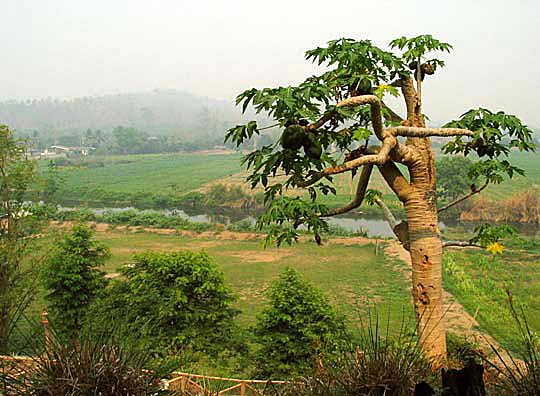
View from Cafe Del Doi (Source: David Giacolone)

Pai river view of former Rimtaling Guesthouse

Rainbow over field in Vieng Neuea, 2005

Rainbow over field in Vieng Neuea, 2005
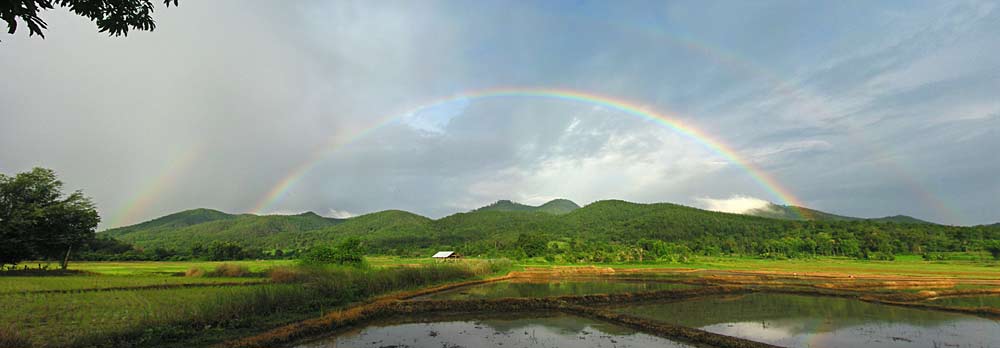
Double Rainbow, 2006
There are many natural features to visit. There are lots of waterfalls of various heights, some accessible by road and some by long, beautiful jungle hikes. You can go floating down the river in an inner tube, white water rafting, hiking in a canyon, or take very long, hellish motorbike rides or multi-day treks to remote hill tribe villages (most of which are much less commercial than the common treks available outside Chiang Mai). Someone has also built a swimming pool near town and charges 40B entry; it's an interesting mix of scantily clad farangs and teenage Thai boys trying to make it seem as if they didn't come to stare at the scantily clad farangs.
Here is a time lapse video showing a typical Pai skyscape in the rainy season (this one is from June 2011). The video compresses about 1.5 hours of footage into 1 minute and 2 seconds (sped up about 85x):
Time Lapse of Pai Sky
Pai is especially beautiful (and wonderfully quiet) in the rainy season around June-September, when the tropical heat is kept in check by torrential rains that last only a few hours a day, creating green, living landscapes that never cease to make you stop and appreciate them:
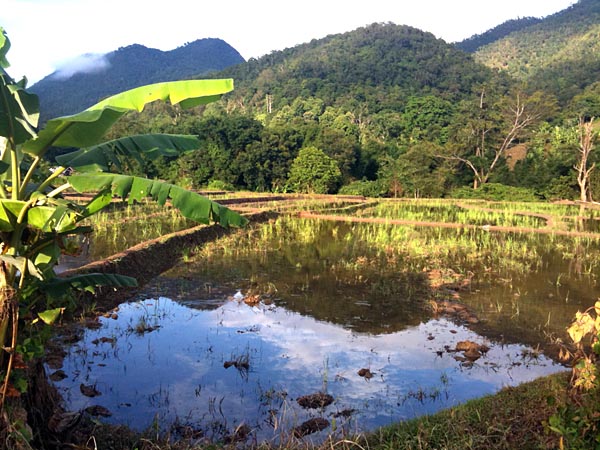
Typical Rainy Season View, 2011
Hot Springs: Help Save Pai Hot Springs from the Bangkok Bureaucrats!

There is a special website on this subject at: http://allaboutpai.com/hotsprings
Tha Pai Hot Springs
There is a wonderful natural hot spring (official name: Tha Pai Hot Springs, not to be confused with the privately-run Tha Pai Spa Camping or Tha Pai Spa Exotic Home) about 8km south of Pai where a cold river and boiling hot source meet inThis local treasure has been run by locals and available for free to all locals for centuries. It has even been free over the last 12 or so years, when it has been under the local Forestry officials' care.
40B for Thais and 200B for Foreigners?
Sadly, in July 2006, for the first time ever in the history of Pai, the Thai Forestry Department in Bangkok wrested control of the hot springs from locals and started charging for entry. Worse yet, the fee rapidly went toThese outrageous prices, and this outrageous price discrimination, which are not just limited to Pai, have been alienating tourists and tour operators for years, spawning a flood of complaints about park fees all across the country.
On 22 November 2007, the Department of National Parks finally began to acknowledge the problem when they introduced a new pricing scheme which reduced fees for some parks. Tha Pai Hot Springs, which is part of Huay Nam Dang National Park, went to 200B for foreigners and 40B for Thais.
200B is still completely, utterly, totally ridiculous. For christ's sake, it's a little muddy hot creek with one little bathroom they have to clean! Give me 200B per person and I will clean the bathroom myself! Even if you believe the nationwide 200-400B "national park fee" is justified for the high costs of maintaining large national parks, 200B is completely out of line for Tha Pai hot springs and can only be ascribed to greed and corruption. For some perspective on 200B, it costs 400B (8.50 Euros) for all-day admission to the Louvre in Paris! Even if you believe farangs should pay more, 5x more is not reasonable by any stretch of the imagination.
The order to charge came from Bangkok and I'm willing to bet the vast majority of the cash goes straight there.
Perhaps the real problem is that Tha Pai Hot Springs is priced along with the rest of Huay Nam Dang National Park. In reality, Tha Pai Hot springs is nowhere near the entrances to Huay Nam Dang, and cannot even compare with the facilities of Huay Nam Dang, which include luxury rental bungalows, a visitor center, restaurants, fancy baths, interpretive trails, miles and miles of hiking trails, etc. Tha Pai Hot Springs is just a little creek with no trails connecting to the rest of the park.
You Can Help
If you feel as annoyed by this as I do, please help by spending a few minutes to do the following.You can do this when you are in Pai visiting the nearby private hot springs, or you can even help via mail or email. Here's all you need to do:
Print and sign the following bilingual note (for email, just cut and paste it!):
Click here for an easy-to-print PDF file
Click here for an easy-to-print Microsoft Word file
เรียน
The Tha Pai natural hot springs is one of the main reasons I visited Pai.
พวก
I am surprised and shocked that you are charging 200B for entrance. This is far too much.
เมื่อ
I will now be leaving instead of paying you. I want to visit the hot springs, but I can not. I feel sad, but your price is simply not reasonable.
เพราะฉะนั้น พวกเรา
I would be willing to pay 40B per person and 30B per motorbike, as Thais do.
พวกเรา
Your price and your two-tier price structure for Thais and foreigners makes me feel very unwelcome as a tourist, as if Tha Pai doesn't want us here.
ในเมื่อ
I am certain that this policy of chasing short-term profits will backfire in the long term, because it stains the reputation of Pai and Thailand for all tourists.
พวก
Respectfully yours,
ด้วย
______________________________________
Now deliver the note in as many ways as you can:
- Email the note to:
Huay Nam Dang National Park
h.namdang_np@hotmail.com - Mail the note to these destinations:
National Park Wildlife and Plant Conservation Department
61 Thanon Pahonyotin
Kwaeng Lat Yao
Khet Chatuchak
Bangkok
10900
ThailandNational Park Conservation Area 16
153 Thanon Charoen Prathet
Tambon Chang Klan
Amphoe Muang Jangwat Chiang Mai
50100
ThailandHuay Nam Dang National Park
Moo 5
Tambon Kit Chang
Amphoe Mae Taeng
Jangwat Chiang Mai
50150
Thailand - For maximum impact, bring the note directly to the hot springs entrance (you can do this while you're visiting the nearby private hot springs) so the staff can actually see a real person refusing to pay the exorbitant fee, and feel the money slip out of their hands!
In order for this to help, we have to do protest Thai-style, which is very different from farang-style. Here's how it works:
- Go to the natural hot springs entrance.
- When/if the official asks you for 200B, politely and calmly offer to pay the Thai price (40B per person plus 30B per motorbike, or whatever is posted). Please remember that yelling and waving your hands does no good in Thailand, makes you look like a complete idiot, and will not help us in our quest to regain control of our hot springs from the bumbling central government. You can disagree and show your disappointment without raising your voice, and this will be much more effective in Thai culture. Even more effective: you can laugh and make it fun!
- Assuming the official still insists on 200B, gently but firmly assure him that this not acceptable (with hand signals: he will likely speak only a little English), and hand him the note.
Very Important: The note must be sealed and addressed to the management!
Why is this? It's because of a surprising facet of Thai culture. Remember, the gate guard is just a grunt with no ability to change the policy. Our goal is to get him to hand this note up the chain of command instead of throwing it away. While our note is very polite, it has a confrontational subject matter. In Thai culture, those who are subordinate (including junior forestry officials!) feel a strong desire not to confront their superiors or even be the bearer of confrontation. If the letter were not sealed, the gate officer would read it and throw it away so as to "shield" his boss from confrontation. A sealed letter, on the other hand, is a completely different matter. The gate officer can claim he doesn't know what's in the letter (and even if he does, and even if his boss knows he knows, it still counts!). Plus, he is duty-bound not to open his boss's letters and to deliver them! Weird, I know, but that's how it is in Thai culture.
In the PDF and Microsoft Word files above, I have made it easy for you to seal your letter by simply folding it as shown:

Folding the LetterOr if you have staples or tape you can get all high-tech :)
- Leave. This is the #1, most important part. This is the part where you are exercising the only two kinds of power that you have as a farang in Thailand: buying power and referral power. Now the gate officer, and eventually his superiors, will understand just how many farang baht they will not be seeing because of this outrageous price, and how this policy adversely affects tourism and Thailand's reputation.
Private Hot Springs
After making this brief stop, you can now go visit one of the nearby, private places that have big concrete hot spring pools or private rooms with hot spring water, such as:- Pai Hotsprings Spa Resort (formerly Tha Pai Spa Camping)
- Joy's Elephant Camp (and several of the other elephant camps too)
- Spa Exotic Home
- probably more places, by the time you read this.
Unfortunately, these places are not natural like Tha Pai hot springs, but at least they don't gouge foreigners. They charge between 40-100B for use of pools.
This will be your reward for helping to take back the natural hot springs from the Bangkok bureaucrats!
Thanks!
Help Keep Foreigners Welcome
It's very important not to give the Bangkok Bureaucrats (or anyone else) any excuse to exclude foreigners from the hot springs. To that end, remember that you are in Thailand and Thai customs in hot springs are quite different than those in the west:- Don't Bathe Naked! Yes, I know, back in _______ (fill in "California," "Burning Man," "The Rainbow Gathering", "My Back Yard"), naked bathing is a joyous expression of your primal connection with nature. Sorry, but this is Pai. No local Thai wants to see your bare breasts or genitalia at the public hot springs. They find it disgusting and it makes them want to kick you out. Notice how many locals bathe daily in the hot springs, but they always keep themselves discreetly covered with a sarong. You should do the same.
- Nature is Quiet: Keep It That Way Tempting though it is to make a huge drum circle, don't. It does in fact annoy the people who run the hot springs. Notice that there is even a "no drum" sign there. It's not worth the risk of further antagonzing the management.
Tell a Friend
Forward this hot springs news to your friend by sending him or her the following URL:http://allaboutpai.com/hotsprings
Weather
At this higher elevation (about 600m or 1800ft on the valley floor), it is drier than Chiang Mai and the rest of the country, and you get hotter days and cooler nights. There are three seasons.The Cold Season
During the cold season of November-February, it's around 70-80 F (21-26 C) in the daytime and very cold at night. You can see your breath almost every night and you definitely need thick blankets on the bed. One night it went down to 37 F (3 C). The main benefits of this are that you can sleep well at night, there are no mosquitos at all except for a 10-minute window at dusk, and the day is very comfortable compared with the rest of Thailand.This is the time of year with the best/easiest weather for most Western travelers. However, of late it has been taken over by the Horrific Bangkok Thai Swarm and a subsequent Chinese wave, and so you really need to come in early November or mid-to-late February to avoid the unpleasant crowds.
The Hot (Smoky) Season
In the February-April hot season, it's more like 90-100 F (32-38 C) during the day. You definitely need a fan all day if you work inside, or you can just remain perfectly still in a hammock :) But the air is not intolerably sticky as it is in Chiang Mai or Bangkok.In 2003, very few places in Pai were air-conditioned, though this changed a lot as Pai "developed" into a major tourist destination.
One of the most noticeable weather features from February until April is man-made: for some reason, the locals completely incinerate the surrounding mountains every year, one gigantic fire at a time, and this fills the whole Pai valley with thick smoke that dampens colors, makes the mountains disappear, and sometimes irritates the lungs and eyes.
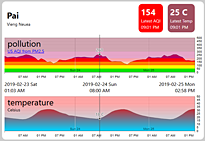
Every night you can see several ferocious, out-of-control blazes slithering up the hill like fire-serpents out of some ancient legend. Theories abound:
- Some people say they burn the forests to "protect" us from forest fires, but this is much more than a fire break: every visible hilltop is left completely brown.
- Some people say they burn the forests and then stand nearby as animals run out, killing the animals for food. This also seems unlikely as nearly all the animals are gone from the forests surrounding Pai.
- Some people say they burn the forests because this kills everything except the teak trees, which they wish to cultivate eventually.
- Some people say they burn the forests to stimulate growth of mushrooms that they can sell.
- Some people say they burn the forests to eliminate underbrush that could one day burn out of control (and some of those people say they simply do not trust their own district's fire-fighting infrastructure to put out a big forest fire, so they take matters into their own hands).
- Some people say they burn the forests for fun.
Who knows. It is best to come to Pai before this madness begins, which is typically in late February, or come in the rainy season (be sure to check our weather and smoke page for current pollution and temperature conditions). It ends with the first few rainstorms, typically in April, which instantly wash all the smoke out of the air and stimulate an amazing burst of growth which makes the hills green again within days.
The burning problem exists all over Thailand, especially Northern Thailand, but it's much much worse in Pai because the valley forms a bowl that gathers the smoke. Same goes for Mae Hong Son. Some of the smoke that settles here may come from nearby valleys as well, or perhaps even from Lao and China. I have yet to find any decent analysis or satellite images.
You can't really go yell at the people doing the burning, because the burning points are located a one- or two-hour hike up the mountains, and they simply leave the fires unattended, so by the time you get there, the arsonist is already gone.
You also can't really expect any real government enforcement without a major change of local consciousness about the dangers of pollution, because the people doing the burning are the life-long friends of the mayors and other local governors, and they honestly believe they are doing the right thing. After all, when they were growing up (with a much smaller population) there was never any problem with smoke, so how could it be their fault?
In 2007, this problem reached critical levels all over northern Thailand. Levels of dangerous PM10 particulates reached more than 300 μg/m3 in nearby Mae Hong Son, three times even the Thai safety level. Hundreds of cases of lung and eye irritation streamed through Pai hospital, with older people suffering disproportionately. Things were a bit better in 2008 and only just "bad" in 2009.
March 18th, 2010 broke all records with a PM10 level of 513 μg/m3 in Mae Hong Son. Here's the chart of shame from December 5th, 2007 until June 8th, 2011:
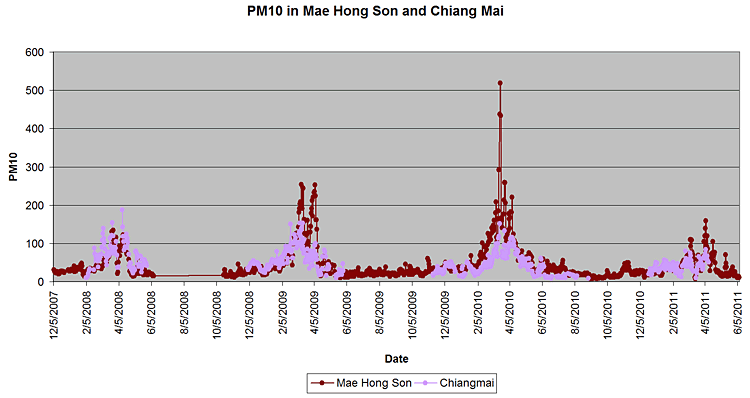
PM10 Pollution in Mae Hong Son and Chiang Mai
This chart is based on all available historical data from the Thai Pollution Control Department (historical data here), but you need to be aware that the PCD has apparently censored out the worst of the data, perhaps to "protect" you from any information that might alarm you. During the absolute worst time of the year in Mar-Apr 2008 when people were getting sick and paying extreme attention to the PM10 every day, and the PM10 was being reported daily in the newspapers so it was clearly being collected, the PM10 data is simply "missing" from the PCD's historical charts. The Chiang Mai PM10 data from the record-bad period of March 18th-20th 2010 is similarly "omitted." Saving face for nature! I'll bet the officers of the PCD got some "green" funding for removing that data.
Each year, the Thai government passes out free masks (flimsy paper masks with tie strings) to give people a good feeling. Unfortunately, these masks have no effect whatsoever on PM10 particulates: they pass right through this type of mask and lodge in the lungs just the same.
Nowadays, many, if not most, of the long-term expats living in Pai go on trips to escape Pai (and all of Northern Thailand) during the "smoky season," returning when the first major rain washes it all away. The pollution has a major effect on Northern Thailand's tourism economy, so perhaps there is some hope the government will do something other than fudge the statistics.
A 2010 Glimmer of Hope: In 2010 in Pai, there did seem to be a new, concerted effort at slowing down the burning. This effort was probably helped by the fact that the air was so utterly toxic, and we might see some results next year. For the first time ever, the district office handed out a detailed list of problems caused by burning the hills, fields, and garbage, and beseeched farmers to stop burning their fields and use the old crops as mulch or compost instead. This list was read out to the locals on Pai's multiple community radio stations, and read out by the village heads on the aging public address speaker systems in each village. For the first time I have ever seen, when certain villagers started enormous brush-clearing fires by the Pai river in both Vieng Neua and Mae Hee villages, citizens reported the fire to the authorities, they actually called out the fire trucks to put the fires out, and the villagers were scolded (nothing more than that is really possible, since the villagers have no money whatsoever: peer pressure is likely to work 10x better than monetary fines anyway). So maybe there is hope for a long-term change in consciousness.
2011 gave us somewhat of a respite due to several strange, unseasonable rains in February, March, and April.
In 2012-2017 the burning and smoke was as awful as ever, coupled with ever-increasing average temperatures as we are seeing all over the world.
It is probably true that Pai needs some long-term plan to avert massive, out-of-control forest fires as we continue to see in California. However, posioning the entire population with PM10 particulates is not a viable solution.
2016 UPDATE: here is a cool documentary-in-progress about the burning issue from Thai-Italian filmmaker Marisa Marchitelli, with many interviews with Thai and foreign professors at Chiang Mai university, and other local researchers. They go into some detail about the problem and suggest part of a solution. It's the first documentary I've ever seen that tries to give some technical background and analysis of the problem:
2019 UPDATE: The problem is very much still here, though with the advent of do-it-yourself pollution monitoring from companies like AirVisual, we are getting better data. The Thai government measures both PM2.5 (the smaller, more dangerous particles that cause us more harm) and PM10 but still only releases the PM10 data, and as mentioned above, that data is often full of holes and even "greenwashed" from time to time. But all over Thailand there is a growing network of home-made stations measuring PM2.5, including a network called Chiang Mai Air with stations in Pai, Chiang Mai, Mae Rim, and other places. You can check out a cool presentation by Craig Houston about Chiang Mai Air (slides here) which explains more about the problem and graphs some long-term trends.
Thanks to the efforts of the pollution monitoring volunteers and some coding on our site starting February 2019, you can check out good (current and historical) pollution data for Pai and nearby big cities on this page:

The burning has even inspired artwork, including Stop Burning Our World by awesome local artist Sa-ard Nilkong of Pittalew Art Gallery (other works):
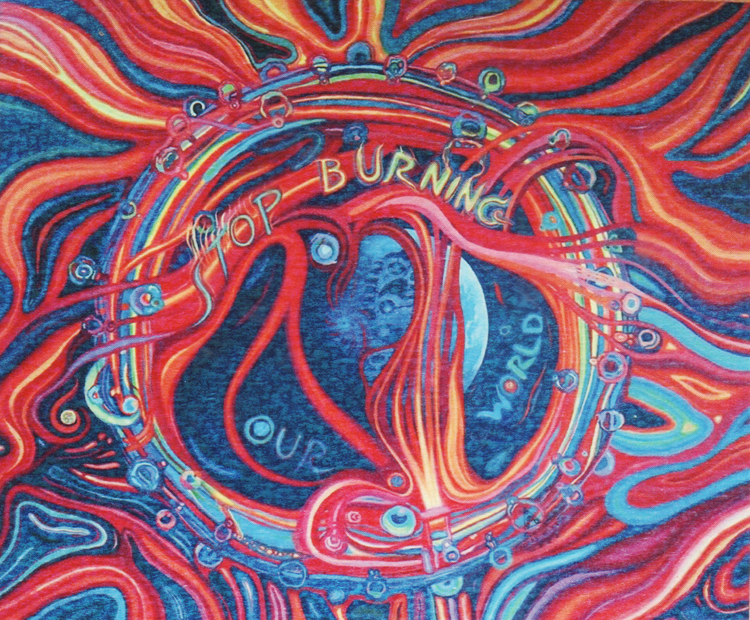
Stop Burning Our World by Sa-ard Nilkong of Pittalew Art Gallery
The Rainy Season
The hot-to-rainy transitional period in May-June tends to be incredibly hot and humid, with an insufficient amount of rain to cool things down, so this is not one of the more comfortable times of year.With the full rainy season (best during July-October) come torrential rains, and typically mild flooding. Except in 2005, when there were massive floods rivaling anything seen in many decades. I have created a separate page devoted entirely to that subject.
The rainy season is now one of the best times to visit Pai. It is amazingly beautiful, with shades of green ranging from neon rice sprouts to dark green forests, and it is completely free of the Horrific Bangkok Thai Swarm and subsequent Chinese horde that invades in December-January, as well as the toxic smoke mentioned above. It does rain hard, but only for a few hours a day, and this is a perfect time to relax in your hut or at a local restaurant. It is certainly hotter and more humid than in the cold season, but at least there's no crowds.
Pai Time
Everything moves very, very slowly here: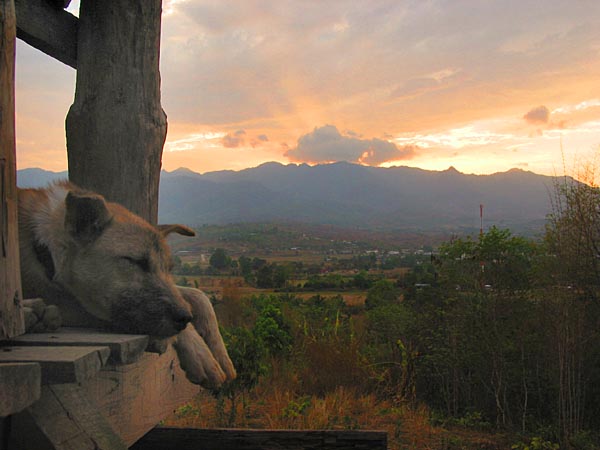
View from Follow the Bird
Pai is a place which teaches people how to slow down and relax. If you try to do anything quickly, like book a flight or solve a business problem at home or, oh say, leave, then some combination of the weather, the infrastructure, or coincidence will reach out its great hands and force you to chill out and ask yourself if it's really that important. When I started writing these pages about Pai, I stopped using the day-by-day format of my journal because days are almost meaningless here.

Sunset and Palm Leaf
The Ride to Pai
There's a long, windy road leading to Pai from Chiang Mai, and until recently, the best public transportation choice was the 4-hour trip in the extremely painful, hot, overcrowded 3rd class ordinary bus: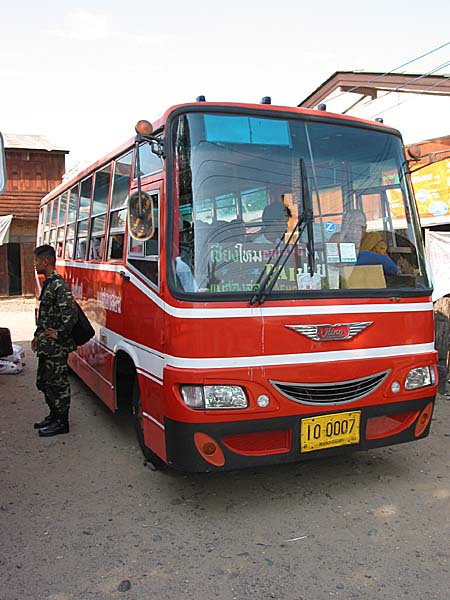
The Pai bus (Chiang Mai to Mae Hong Son)
Inside this grinding, bellowing, steel and glass monster, there were hard bench seats wide enough for 2 small Thais or 1.5 normal farangs:
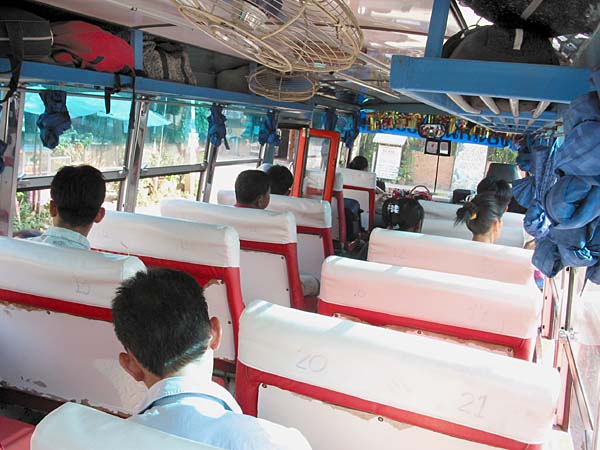
Inside the Pai Bus
The fans were provided mostly for looks and worked less than half the time. Sometimes, the driver had to shut off the fans when making the tortuous, slow ascent of the mountains, otherwise the bus's electrical system would fail. There was a so-called "aircon bus" which apparently meant that it doesn't have fans at all, and the windows didn't open either. Fortuanately, the "aircon bus" fleet was decommissioned quickly.
I have only once in my life seen the Thais turn away a bus passenger anywhere in Thailand. Typically, during the tourist season, they will fill up the Pai bus completely, with 2 people or 3 kids in each bench, a line of people standing in the aisle amidst the stuck-out legs of the lucky seated passengers, and a full crowd in the front and back door areas. Often, the bus conductor will have to hang out the side of the bus, or climb up on top of the bus, because there is no room for him inside.
The Thai word for 3rd class buses like these is rot may, which comes from the fact that decades ago these buses were used to transport the mail. That tradition has ended everywhere I've been in Thailand—except Pai. So, for example, these mostly farang passengers who have crammed 5 in the back and await departure in the 90 degree heat:
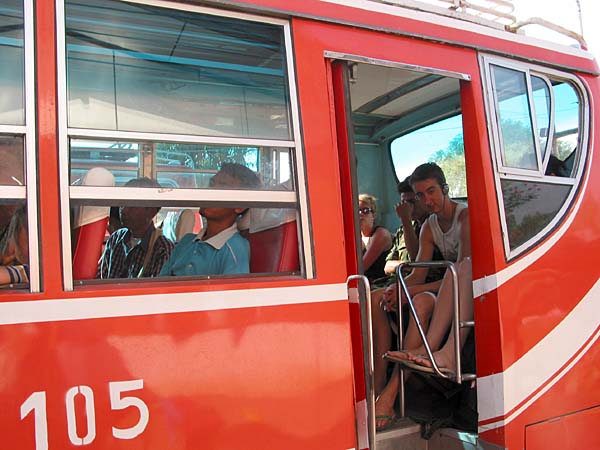
Happy campers inside the Pai bus...not
are blissfully unaware that the space currently occupied by their legs is going to be used to transport cargo:
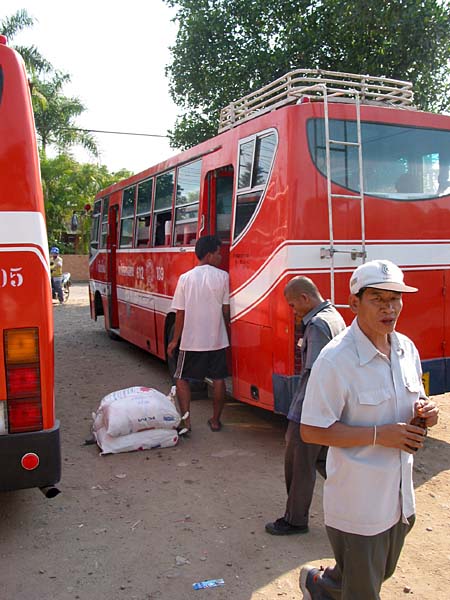
Hmm, it's for cargo too
For better or worse, the last of these iconic metal beasts passed away in 2016, and so now everyone gets to climb the hills of Pai in different transport options. The buses can now be seen as props sitting in front of some of our cutsie cafes, sometimes with weeds growing up through the undercarriage.
As early as 2003 there were also private minivans that did the same route in 2-3 hours, but without getting into a multi-page minivan rant I will just say that they managed to make the bus look like a pretty swell option. Sadly, now they are one of our only options, though speeds have improved (meaning, they have decreased)..
For an up-to-date summary of all the transportation options along with prices and schedules, see the transport page.
But don't let my review of the transportation options leave you with a bad taste. It really is a good thing. I really believe that if it were easy to get to Pai, it would attract a whole different set of folks, ones who are interested in air conditioning, go-go bars, and concrete hotels, and not at all interested in music, art, long stays, or anything else that makes Pai so compelling.
This could all change with the opening of a new road and the airport, as I explain below.
Guesthouses in Pai—Bamboo Hut Variety
There are a ton of guesthouses, and until 2008, most of them consisted of a few simple one-room thatch huts held up on stilts over former rice fields. Here are some shots of the excellent (but, alas, now destroyed) Yawning Field guesthouse where I spent quite a lot of time:
Pano of Yawning Field

Yawning Field hut
The rooms contain mattresses, skeeter nets, and sometimes a light or candle:

Inside a Yawning Field hut
Most guesthouses feature a large, central shade structure with hammocks and comfortable bamboo and pillow couches (angled just right for slouching) next to tables filled with games and other time-wasters:

Pano of Yawning Field slouching area
There's usually a restaurant and the proprietor is often some kind of Thai hippie or other dropout who is just as interested in slouching, playing music, and chatting as the guests.
Life at the guesthouse goes slowly, on Pai Time. In Pai the mornings are cool and nice and occasionally people go out to explore the natural sights, readying them for a long nap. In the afternoon it gets extremely hot and this further reinforces the desire to rest. In a major display of good taste, most of the bamboo guesthouses in Pai do not have TVs or radios so it is actually possible, and quite easy, to chill out. In the evening it is nice again and everyone goes out to see music. At night during the cold season it is extremely cold (a welcome change from other parts of Thailand) and everyone sits around by campfires or wraps up in blankets and/or sleeping bags in their huts.
Another interesting feature is the bathrooms. Far from the smelly, insect-ridden concrete squat cell one would normally expect at such establishments, the proprietors of many of the guesthouses have constructed huge (

Yawning Field waterfall shower in jungle bathroom
In general these bamboo guesthouses blend in with the scenery of Pai and it is not possible to figure out if you are looking at a guesthouse or some huts for the locals.
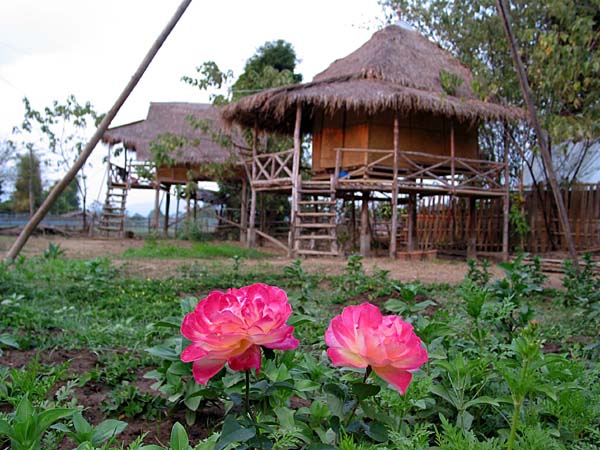
Yawning Field hut

Yawning Field cat
The Yawning Field guesthouse was started by a 20-something transplanted Bangkok city slicker named Jay and a jovial and gregarious Thai woman named Mink. Their shade structure has the best hammocks. Their setup is so rigged for relaxation that I managed to spend an entire day in a hammock, something I've never done in my life.

Yawning Field owner beside sign
The Yawning Field, and several other guesthouses, are located in an interesting area of Pai town, across a rickety bamboo bridge over the Pai river:
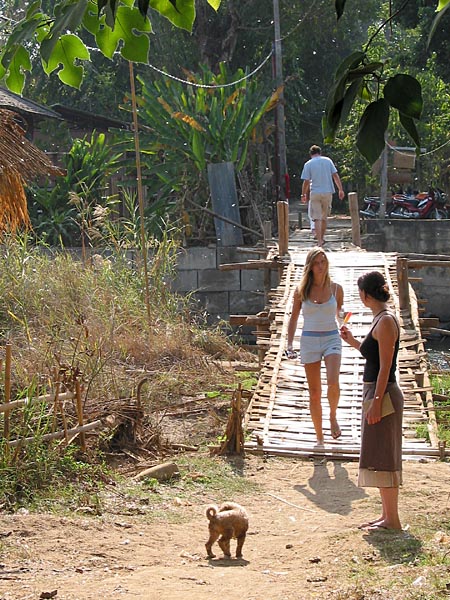
Bamboo bridge and snow
In December and January, huge trees in the area start letting go of dandelion-like feathery floating pods and when the wind blows it literally snows in 90 degree weather, as seen above. Very beautiful.
The entire area floods up to one meter underwater for a few days during every rainy season! The exact month of flood and ebb varies from year to year and nobody can predict it. The onset is often very fast: on very rare occasions, people have woken up in the middle of the night with water in their hut and all their belongings floating down the river. Occasionally, the floods carry away some of the huts too.
Because of the floods, the local Thais do not build any houses or businesses in this area, and this has the wonderful and unintended side effect that the whole area is much quieter than almost any other guesthouse place in the whole of Thailand.
Unfortunately, in the rainy season of 2005, these guesthouses' luck ran out. Massive floods, rivaling anything seen in many decades, obliterated the entire area of the Yawning Field and its neighbors and several other riverside areas of town as well, including both bamboo huts and "durable" concrete structures. I have created a separate page devoted entirely to that subject.
After her guesthouse floated away, Mink was successfully scared away from the guesthouse business for the 2005-6 season, so instead she set up Mink's Restaurant/Hiccup Bar in town.
Fortunately, Mink is persistent, and out of the ashes rose a great new guesthouse, on higher ground (over the big bridge next to Pai school and up the hill a bit, next door to the new Paddy Fields and near Countryside Bungalows), known as both Yawning Fields and Ing Doi House (for the new wave of Thai visitors). This time, it consists of fancier wooden bungalows, though still with the teak leaf rooves and natural surroundings:

Ing Doi House / Yawning Fields
Interestingly, in 2005, the owners of the neighboring Rimtaling guesthouse moved their entire guesthouse up to the same hill about one month before the floods, renaming it to Paddy Fields. The Rimtaling / Paddy Fields owners will be applying for the position of town psychics.
Random Bamboo Art
A surprising amount of the decor and even some of the architecture of these bamboo guesthouses comes from the (possibly bored?) guests themselves. Amongst the peaceful, clinking mobiles hanging from the roof edge and ceiling of the Yawning Field are intricate, nested, multi-pointed geometric polyhedra made out of plastic straws. A guest who arrived in February 2003 was a major math nerd and he spent several days calculating the angles and building them. He also calculated the lengths and angles for a geodesic dome, and another guest who's particularly handy with bamboo built a 2-3m tall geodesic half-sphere frame out amongst the bungalows. By the time I left he was planning on making it into a shade structure by thatching each of the faces!If, anytime in 2003, you wandered around PS Riverside guesthouse, you would notice a giant, 4-story, open-walled bamboo structure with dramatic thatch fan patterns, stairs between each level, and roof sections at odd, exaggerated angles. It was sort of like a bamboo version of the SGI (now Google) headquarter buildings:
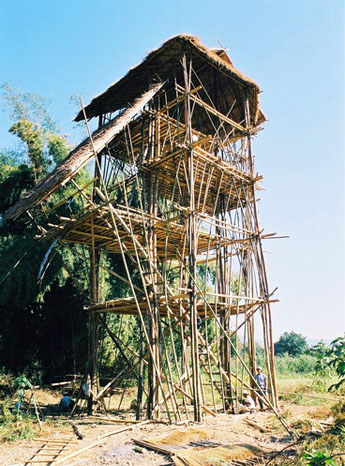 Kalo's Bamboo Entertainment Tower, 2003 Note Person at Bottom! |  Kalo's Bamboo Entertainment Tower, 2003 Completed |
Turns out this is the art/architecture project of another guest named Kalo who just decided one day that he wanted to build a giant hut. He had attended Burning Man on many previous years and was known for building large-format bamboo art. Why not do it here in Pai too? He hired a bunch of local Thais to help him and built it in a month or two, and left it to the guesthouse to use as they please. He also built a giant pentagram surrounding a stone mound nearby, I suppose for those spur-of-the-moment times when you've just got to have a Pagan ritual. I believe The structure was taken down in 2004 (if not, the flood got it in 2005).
In 2009, Kalo built a cool indoor/outdoor bamboo cinema around the same location at PS Riverside. He shows movies on a big projection screen hanging off a bamboo wall, and people can lounge on mattresses or dangle their legs off a second story ledge to watch the movie, with a campfire in the middle of the building to keep folks warm in the chilly Pai winters! An interesting combination of old and new as the projection beam shoots through the smoke rising off a warm bamboo fire.

Seating of Kalo's Cinema, 2009
Kalo also built a floating bamboo raft and has many more projects in the works. At his continuing projects, he welcomes volunteers to come learn all about bamboo construction as they help him build the next cool thing. If you are coming to Pai, you can contact him at FootPrintkalo@gmail.com or call 089-855-6947 (international +66 89 855 6947).
Kalo's eventual dream is to build a bamboo academy in nearby Soppong as a way to keep alive the art and knowledge of bamboo construction techniques.
In Pai you see random, intense acts of creativity like this all the time. It's one of the things that makes the place interesting.
Guesthouses in Pai—Concrete
In the downtown area, Pai also has a selection of concrete guesthouses with small, very clean tile rooms, flush toilets, hot water heaters, and all the amenities. Most of these are in very loud areas near restaurants or bars. Pai in the Sky and Tonsa are the only ones I know which are in relatively quiet areas near a river bed, though they have thin walls between rooms, so try to rent a pair of rooms if you stay here. Here's the entrance to Pai in the Sky, confusingly mixed in (as is typical) with one of the many small wats in town, Wat Klang:
Wat Klang next to Pai in the Sky
Scenes in Downtown Pai
Map
Pai is a small town. There's basically 4 criss-crossed paved, two-lane roads, each less than 1km long, and a series of one lane paved alleys:
Downtown Pai
Note: I stole this map from Mae Hong Son Travel. You can check out their site to get the legend of guesthouse/restaurant names but be aware that there are many errors! Also, note that a large number of these establishments were destroyed in the floods of 2005.
July 2006 Update: You can find more maps, and links to yet more maps, on the maps page of allaboutpai.com.
The roads have names but everyone just says "the bus station road," "the Chiang Mai road," etc. You used to be able to say "the bank road" but now every road has multiple banks. The "7-11 road" worked for a while, until the second and third 7-11 went in. Sigh.
Most of town looks like this:

Seng Tong market area in Pai
Day Market
The busy afternoon market, where everyone buys their fresh food supplies for that night's cooking, takes over the sidewalk along a 200 meter long section of road near the municipal offices (this picture is from the old location on the Krung Thai bank street):
Day market in Pai
There's a whole spectrum of foods from raw ingredients (fresh cut greens like kale or morning glory, garlic, tomatoes, tofu chunks, endless fruit varieties, thai peppers, and other supplies) to ready-to-eat snacks catering towards the gawking farang tourists. Akha, Lisu, and other minority hill tribe women also sell their clothing and jewelry on the sidewalk along with the food vendors.
Vendors in Pai make delicious north-eastern style barbecued chicken (gai yaang) and northern-style pork sausages. There's even a shop in town specializing in "som tam," the famous north-eastern papaya salad. At rolling stands like this, you can pay 30B (78 cents) for a complete meal of chicken and sticky rice:
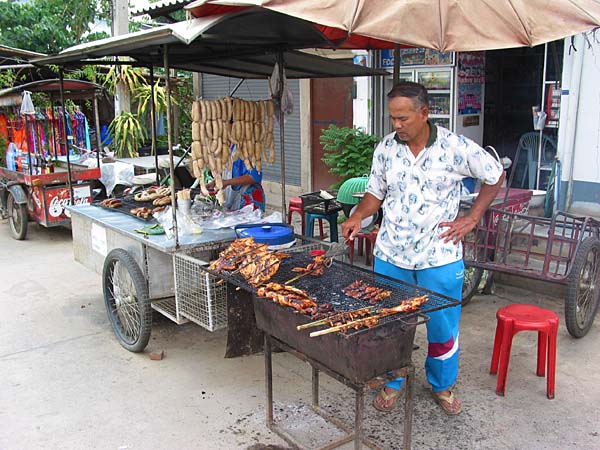
Wednesday market area: BBQed chicken
Tastes of Home
In downtown Pai you can also find a few little grocery store/bakeries with a collection of farang staples that rivals many grocery stores in Chiang Mai and Bangkok. The owners, like many business people in Pai, are very good at listening to what the farangs want and then finding the items somewhere in Thailand: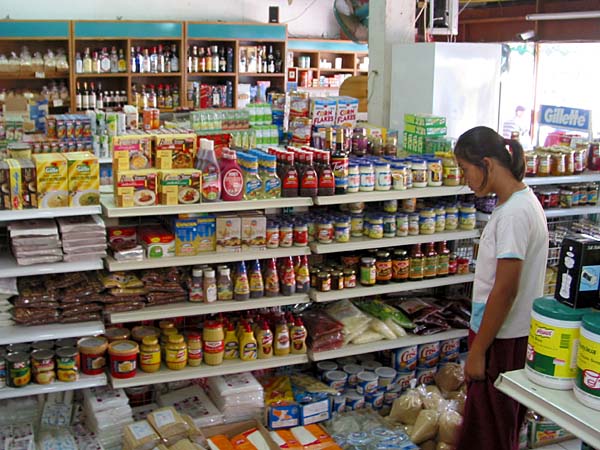
Aoy Bakery
Here we see a shelf with ketchup, barbecue sauce, mayonnaise, cocoa powder, 3 brands of mustard, corn flakes, muesli, flour, and, of all things, Crisco. Most Thais have never even heard of Crisco let alone know what to do with it. In the refrigerator cabinets you can find yogurt, milk, cheeses imported from Europe including blue cheese and mozzarella, small but fairly tasty frozen beef steaks (beef is generally tough and hard to find in Thailand but these little ribeyes are pretty good), and frozen, ready-to-prepare french fries! The prices are predictably high: ingredients to prepare a Thai meal for a family of 4 might cost you 20B (50 cents) out on the sidewalk, but inside Aoy Bakery you might pay 50 baht for a single stick of butter, 50 baht for a small loaf of rye bread, 100 baht for a small frozen steak, 100 baht for a quart-size chunk of cheese, or 200 or more baht for a bottle of cheap-ish Austrailian or New Zealand wine.
One day I shopped here for supplies and taught my grandma's recipe for apple pie to the owners of Rimtaling and Yawning Field guesthouse! We cooked the pie in their little portable glass convection oven and it came out pretty well.
March 2010 Update: the picture above was taken at Aoy Bakery (Oy as in Oy Vey) around 2004. In 2009, Aoy, like many local businesses, decided to adapt itself to the new tourist demographic of the Horrific Bangkok Thai Swarm, reducing their farang offerings to almost nothing and expanding their bakery section into a large, modern, brightly-colored Bangkok-style concrete air-con storefront. Unfortunately, it doesn't seem to be working out, since Aoy was not able to get themselves on the Thai tourists' pre-planned package "program." Fortunately, there are still several other places in town, such as the "9-7 minimart" (across from #30 on the map above), that still have a fair supply of farang staples.
June 2011 Update: Well, my prediction was right. Aoy Bakery packed up their bags and left town in early 2011. The building was razed and instantly replaced with more small chinese-style concrete shophouses featuring trendy Thai-tourist oriented bars and a noodle shop.
Back in 2003, many business folks here made most or all of their living off of providing farang tourists with the tastes of home, and as of 2010 it is still true for many businesses.
In most cases the vendors learn to prepare the food from the very same tourists! The most colorful example of this is Mama Falafel:

Mama Falafel
Pai has a huge contingent of demanding but faithful short-term Israeli tourists. Mama Falafel (aka Pii Sii) set up a tiny food stand serving pitas filled with falafel, hummus, and lettuce from the evening until late at night. When she immediately started attracting the attention and criticism of the Israeli set, she knew she was on to something. In just a few days she had a menu translated into Hebrew. Over a few short weeks, the menu expanded to include tahini and other items, and based on the continuing feedback she refined her preparation to such an extent that it seems no Israeli can possibly resist purchasing her falafel every night! Later she was joined by an enterprising, Thai ex-guesthouse-owner who calls himself Johnny Possible, who sells barbecued corn, potatoes, and other items at an adjacent stand called "Potato Possible."
Update: in eary 2005, Pii Sii upgraded from her cart to a full-on restaurant in town!
2011 Update: Sadly, in 2011 Pii Sii passed away after a sudden illness, and we will all miss her. Her family continues the excellent food tradition at Mama Falafel. RIP. And, if you ever come down with a major or unknown condition, do not go to Pai Hospital: head straight for Chiang Mai.

RIP Pii Sii
Strangely, in early January 2007, I happened across another upstart cart in exactly the same location as the above photograph:

KFG (Kentucky Fried gai)
It's called KFG, which (though it could be denied to any lawyer if necessary) stands for Kentucky Fried gai, a taunt using the Thai word for chicken. Thell sell fried chicken and fries. Who knows, could take off in the same way...
Wednesday Market
You can buy your housewares and long-lasting food supplies at a collection of 5-6 minimarts and bedware shops in town, or you can wait for the giant "Wednesday Market," where caravans of vendors from Chiang Mai arrive with their overstuffed pickup trucks of goods for a weekly tented cornucopia in a large dirt area of town (behind the police statiion on the map above):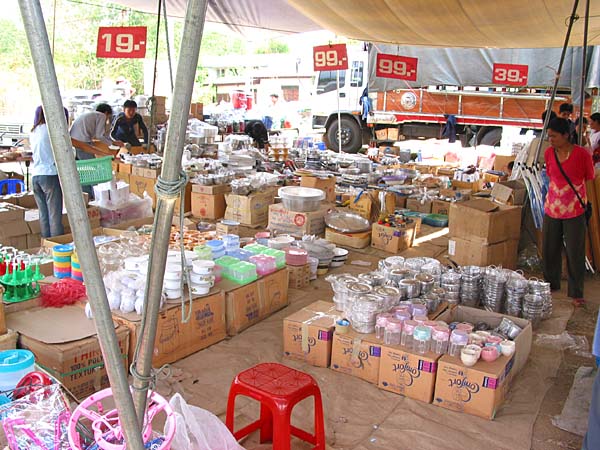
Wednesday Market
Goods are amazingly cheap, so cheap that you wonder how anyone could make a profit off them. Above you see the "99" store, where giant signs sort the whole area into 5 (13 cent), 10 (26 cent), 19 (50 cent), 29 (76 cent), 39 ($1.02), and 99 baht ($2.60) items. All the goods are splayed out in plastic bins sitting on the ground, on cardboard on the ground, or occasionally on low tables:

Wednesday Market: bins
The goods are basically anything and everything a Thai might need to set up and maintain a house in Pai. The vendors hover around their bins with chicken-feather dusters valiantly trying to keep the ever-present dust off of their wares.
Some of the goods are so cheap it's entertaining. Spoons and forks stamped out of almost-foil-thin aluminum, snazzy looking knives so dull they can't even cut butter, and piles and piles of used, bent, worn out hand tools (needle nose pliers that don't come together anymore, chipped-up wire cutters, worn down philips screwdrivers, etc.). But some of the goods, like bungy cords, a certain brand of knife, and about half the tupperware, are amazingly sturdy and are an amazing deal for the price. For the Thais here it is like a national sport figuring out which is which and getting the best price possible.
Here's a whole table with 19B (50 cent) sandals of every size, shape, and color:

Wednesday Market: sandals
...except any sizes that I can wear. One little problem with living here is that there is no profit in selling farang-sized items, whether it be shoes, sandals, underwear, motorcycle helmets, or anything. For many items I have had to go to Chiang Mai, and shop at incredibly hard-to-find freak stores like "XL For Men" at the Chiang Mai Airport Plaza shopping mall. For some particularly important items I have had to order from the web or bother my mom to go to her local department store and send a care package to Thailand!
One thing that definitely sells well in a dusty rural area is soap. Ironically these tend to be some of the dustiest items at the market:
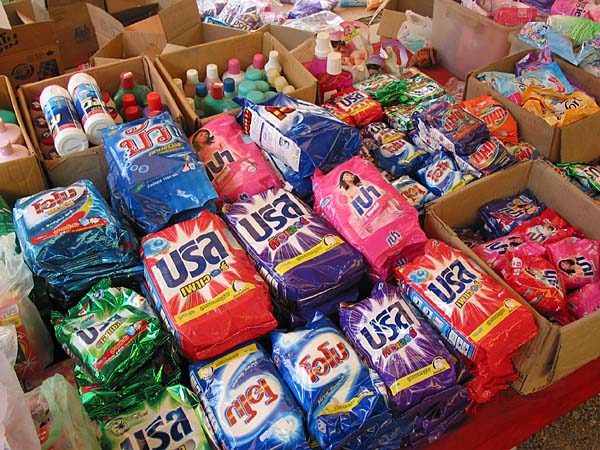
Wednesday Market: soap
Anyone who has a house in Pai, even a completely clueless indoor-bound farang like me, will eventually have to buy a machete:
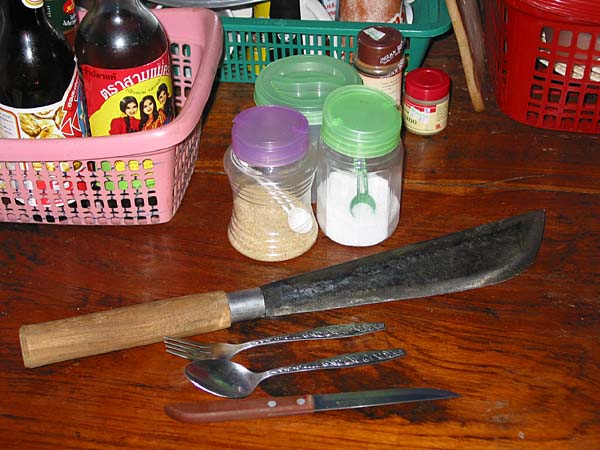
Machete
The locals use these machetes for everything from trimming the weeds to cutting and shaping bamboo for construction to cutting small planks of wood to (most importantly) cutting bananas and other fruits off of trees when they are ripe. Although I haven't a clue what I am doing, I must say it is fun to swing a big evil looking 12-inch blade through a 6-inch thick banana tree trunk and slice through the whole thing in one go without feeling any resistance from the tree.
They are available in large quantities for 70-100B ($1.82-$2.63) each:
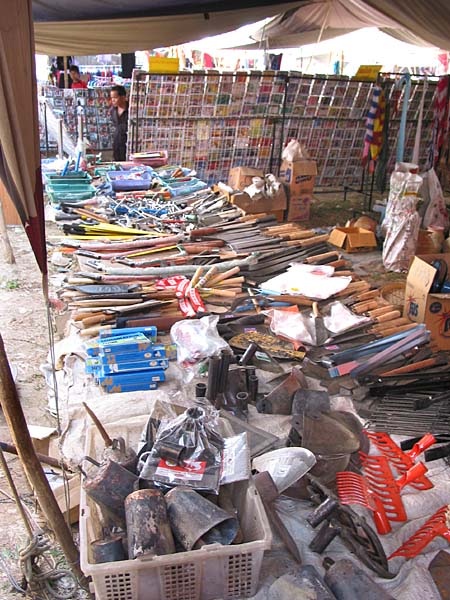
Wednesday Market: machetes and VCDs
and you will see little kids who can barely reach the pedals on their bicycles come up and buy them! Those kids not only can use the knife without hurting themselves (the ones who didn't figure that out on their own are dead), they also know how and when to cut each kind of fruit off the tree and a lot of other stuff I will never know at any age.
In the village of Mo Paeng, near a popular waterfall, there is a man who makes amazing, high-quality custom knives (with any shape you specify) with tough bamboo handles and beautiful teak sheathes. He cuts the blades out of used car springs, grinds them down and sharpens them to perfection using equipment on-site, stamping on his own symbol with great pride. When you see him work you become acutely aware that you in the presence of a dedicated expert. Most amazingly, he charges only about 350B for a finished knife.
In the background of the picture above you can see the huge VCD store selling pirated Thai music, movies, and music videos.
At the market you can find lots of cool spices:

Wednesday Market: spices
And it's easy to tell when you are within 50 feet of the stinky, dried, preserved fish (blaa kem) that Thais (and perhaps all Asians) like so much but which I find thoroughly vile:
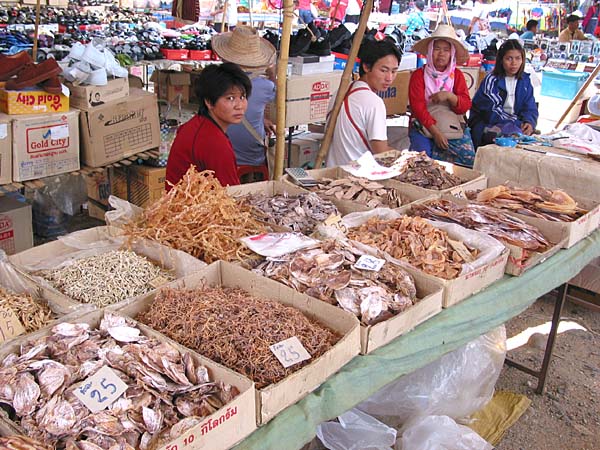
Wednesday Market: stinky preserved fish
As in almost everywhere in Thailand, meat is sold by plopping the cuts and guts right out on a piece of newspaper or a rotten wooden cutting board. Here's two customers gleefully running their fingers through the merchandise:
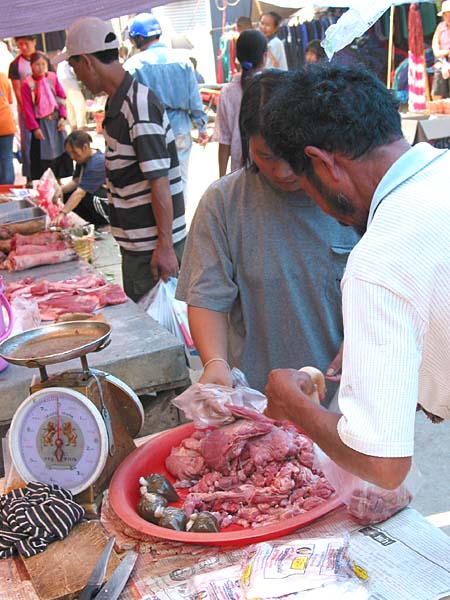
Wednesday Market: yummy meat
The meat sits there all morning and afternoon in the warm air and flies gather by the hundreds. Some vendors, for a reason I have never understood, make a token gesture to hygiene by shooing the flies away for 1 second with a handkerchief tied to the end of a 3 foot bamboo stick. The flies come back in the next second but the vendors only flick the stick when a customer approaches ("oh, let me push away this swarm of vermin for a second so you can decide which of my fine filets of meat is most delicious!") and they are feeling energetic. One very clever vendor tore apart his electric desk fan, ripped off the wings of the fan, and replaced them with little bamboo sticks with little hankies at the end. Voila! He had an automatic fly shooer. A few places in the country, mostly in big cities, now sell plastic-wrapped meat out of refrigerated cabinets. There is one such place in Pai and that is where I buy my chicken meat.
At the Wednesday market they also sell fresh foods cheap. Today when I took the picture, lychees and rambutans (a Dr. Seuss like round fruit with bright red, spiraly, curly hair and lychee-like sweet flesh inside) had just hit the market at 15-20 baht per kilo so everyone was excited, including the man in the skirt:
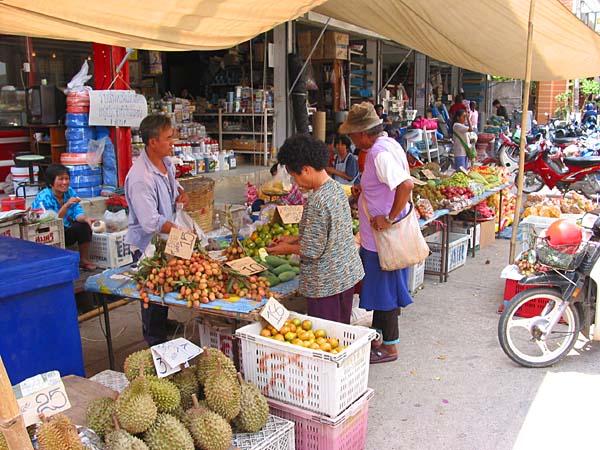
Wednesday Market: get fruit
Tourist Town
Pai has lots of quaint stores to attract tourists who actually like shopping (unlike me):
Tourist shop
There's postcards, antiques, tribal handicrafts, and there's even a few art gallery coffee shops where local painters display and sell their work. Sadly, as I mention in my 2008-2012 update above, there is a general trend of these shops selling less and less authentic and creative stuff and more and more plastic junk, but there's still some good stuff out there.
Nearly everyone who comes to Pai rents a motorbike, even if they have never driven one before. Actually it's a little scary. Fortunately Pai inspires people to take it slow, and the rental places are used to bikes being returned with broken-off side mirrors, so it all works out somehow. One motorbike place stands out from the rest:
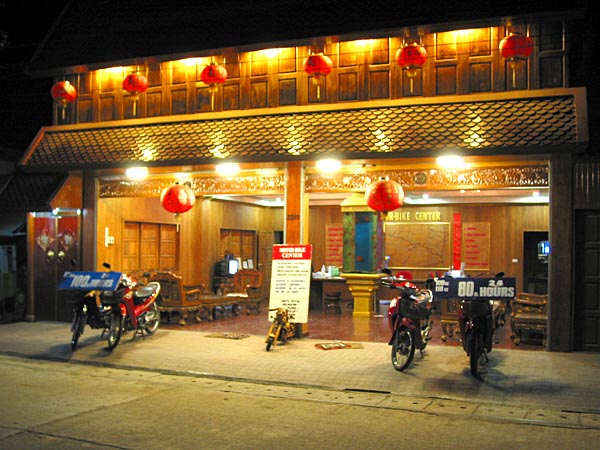
AYA motorcyle rental shop
With its incredibly audacious facade, complete with hardwood paneling and a lighted goldfish tank wrapped around one of the gold-leaf-covered principal pillars, and the largest supply of rental bikes, Aya looks like it means business. Unfortunately this seems in part because Aya is very good at misleading its customers about the price, whether or not insurance is included, what that insurance includes, and "repairs" needed on return. I have heard so many direct accounts of problems and had problems myself, so if you come to Pai I would highly recommend that you rent a motorbike elsewhere.
There are many farang restaurants in the Pai area. One with character was the Shark Bar, which was in town in 2003 and moved to a nearby village of Mae Khong in 2004. The Shark Bar was run by an Austrian gentleman named Marc who is very, very proud of his Schnitzel. The place has whacky decor, with old jazz LPs covering the walls, odd images of Austria and other places, and old fashioned beer signs. The menu was full of jokes and childish stick figure diagrams, but when I chuckled upon reading about Schnitzel and French Fries for sale in Thailand he assured me "Zees is a very fine dish, ya? Ven you order zis dish ve have two challenges, ya? You see we must do zee french fries crispy on zee outside and varm on zee inside just correct, and zee schniztel ve must also prepare zee correct vay. Order I sink you will like, ya?" With a speech like that I just had to order it. It was good, I guess, but I have a hard time getting excited over breaded pounded meat. "Not zo bad," he said, "for farang food in thailand, ya?" As I went more and more I found myself addicted to the incredibly welcoming atmosphere that Marc created, and eventually to the Schnitzel itself.
Marc used to be in marketing and in 2004 he managed to fill his bar many days even though it is a confusing 10-15 minute motorbike ride out of town. He advertised by placing little cups of free cigars in internet cafes and other locations all over town. The cigars were wrapped in maps and info about the Shark Bar. The new location was in the middle of a quiet garlic field next to a river. There was a small dam and you could swim in the pool or float around in a little rowboat. Marc's customers seemed to be mostly older German or French guys visiting Thailand with their hired consorts, or living here with Thai wives. One time when I arrived alone to get some lunch, Marc brought over some French and American "gentleman's" magazines to entertain me while I waited for my food. After living in the comparatively hippie-ish feel of downtown Pai for months, it was a refreshing change to go to such a politically incorrect place. On the other hand, the Shark Bar was also a favorite stop for many hippie types, local Thai women, and others.
Tragically, the Shark Bar closed in mid-2006 so that Marc could spend more time with his family (really!). But there is a small chance that in a few years it might open again.
An excellent farang-oriented restaurant that continues to move around different places in Pai is Amido's Pizza Garden:
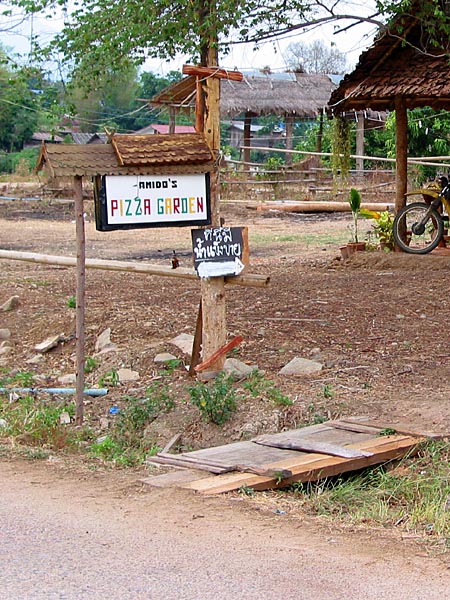
Amido's Pizza Garden
which was started by a charismatic Belgian-Algerian man who really knows how to make good dough and pizza, in any state of sobriety. It is difficult to break even on any kind of farang food in Thailand, and Amido charges 140-200 baht for a large personal pie, but his pizzas are good enough that people keep coming back.
Lots of farangs come to Pai to open their dream business, most often a restaurant, bar, or crafts shop (leather and silver seem to be especially popular). Most ventures like these never make it much past opening day anywhere in the world, but it's especially tricky in Thailand because of the added language and cultural barriers. A farang is forbidden by law from owning land or a controlling interest in any business in Thailand. For certain nationalities and situations there are exceptions, but they are poorly specified and the farang must walk on eggshells and avoid offending anyone to keep their rights. Most farangs must therefore bankroll their business but hand official control over to a Thai spouse, loved one, or friend, and this obviously leads to problems in many situations. Even when the partners are trustworthy, the farang hits other, hidden cultural barriers. Even obtaining building permits, or the right to sell goods in what is supposed to be a public space, suddenly become issues when the presumed-to-be-rich farang is involved. Here's one intrepid expat building his shop. You can see the anguish in his face :) We wish him luck in his ventures.
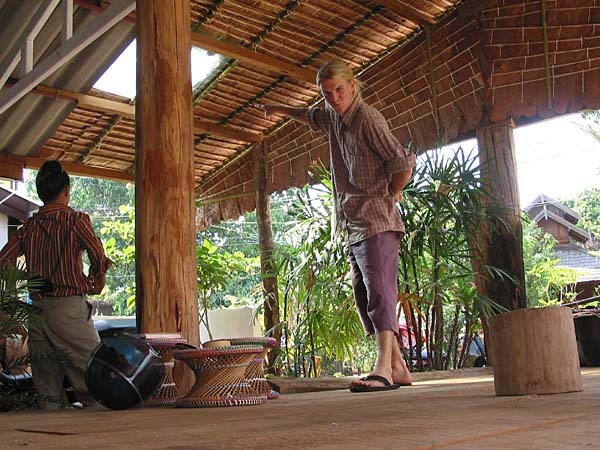
Farang Restaurant in Progress
Muslims
In downtown Pai, there are several Thai wats with their ringing bells, a Christian Church built by local ethnic minorities with gospel song every Sunday, and a mosque whose speakers fill the town with prayer several times a day. There are Muslims living all over the downtown area, walking around with their body-covering hijabs (though only some of the Muslim families follow the dress code that strictly) and smart topis/kufis/turbans, and they are very good at business. Some have been in Pai for almost two generations. Many came here from Chiang Mai because they saw an opportunity to do well for themselves and build a community. Some of them came from China via Burma. They have no ethnic or historical connection with the Muslims in the southern three provinces of Thailand, where there is so much unrest.This place, known simply as "the Muslim shop," is truly amazing:
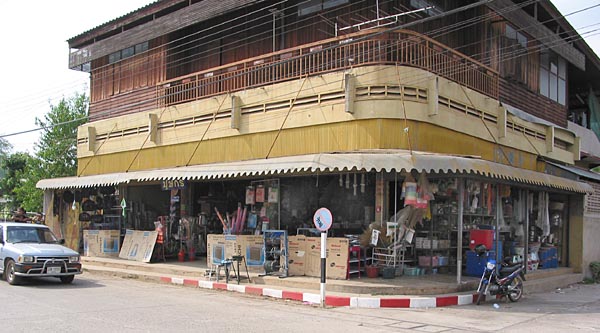
The Muslim shop
In this relatively small corner lot they have stuffed everything you could possibly imagine that you might want or need for your house. They have hardware, stoves, bedware, soap, plastic goods, fans, stereos, ant spray, mosquito nets, florescent fixtures, brooms, rugs, furniture and even hammocks. The prices quoted are pretty high and the cloaked ladies in charge, especially the older ones, bargain relentlessly, but they've got what you want!
Then there's the "Muslim bakery:"
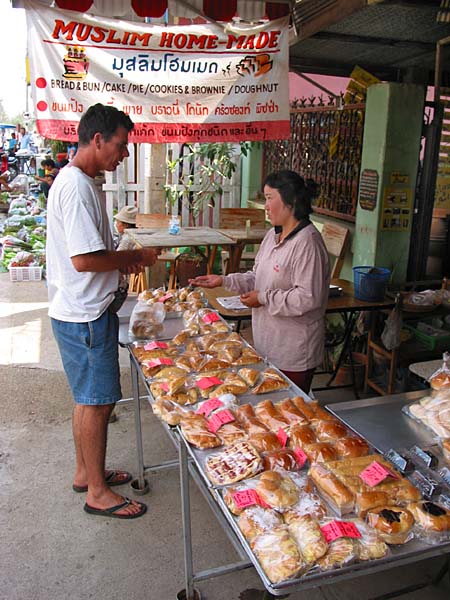
The Muslim Bakery
where the Muslims bake chocolate-filled croissants, apple strudel, and other confections every day. The Muslim bakery, like Aoy bakery, is a daily hangout for many local expats. You can sit and eat a pastry while you drink chai tea, a thick, somewhat sweet, milky tea which is very popular in Pai. The Muslim Bakery also offers a selection of odd organic items such as goat's milk from local farms, giving birth to the most famous and recommended beverage: goat milk chai. Around 2006, the bakery part split off and moved down the street to a shop called "Muslim Home-Made," but the old location retains the chai tea and its peanut gallery of crotchety, long-term expats.
Vehicles
Almost all vehicles on the road are motorbikes, and often you will see whole families on one bike, as in other places in Thailand. The next most common vehicle in this rural farming area is a pickup truck, and those who have one seem to automatically take on a public duty of transporting huge groups of villagers, too poor to afford any vehicle, to and from town. Beyond that you see few other vehicles, except rich Thai tourists arriving from Bangkok or Chiang Mai in their SUVs as part of the Horrific Bangkok Thai Swarm.Around August 2004, Pai also got its first two sets of traffic signals. Before that, the four-way intersections of Pai were unmarked, "gentleman's intersections" where everyone except for the yabba-tweaked teenage gangsters and the Red-Bull-powered huge cargo truck drivers would slow down and look before crossing. Now, we have two fully modern intersections complete with a digital countdown timer for the red light.
Most people don't know what to do with it. Some people still slow down and drive right through as if the signal were not there. The teenagers and truck drivers speed through as before. One time, a Thai man scowled at me as I crossed straight through an intersection at the green light, and he was turning right: he thought that the green light gave him permission to go any way he wanted. A few people stop an extra-long time and won't even turn left on a red light. Most people who end up at the front of the pack, facing a red light, just sort of look around in confusion and go when the oncoming lane of traffic goes.
Scenes in Vieng Neuea Village
From 2003-2008, I lived in a small village about 3km outside of Pai called Vieng Neuea. Most of Vieng Neuea looks like this:
Vieng Neuea
Kids, roosters, and dogs running around concrete streets. The deep gutters on the side of the road, covered in red grates, carry water from the local hills down to fields at lower elevations than the town itself. The locals, especially the kids, are always pulling up the grates and using the water for various tasks or rescuing chicks that have fallen through.
On the fence you can see two election signs. The local elections here happen in March and April and they proudly post the vote counts and tallied results (reaching two digits, and on rare occasions, three digits) on a big wooden sign in the center of town. The locals really seem to look forward to the elections. It seems like a warm, honest, down-home type of democracy where your vote really counts. The type of representative government that Americans can only dream about. Until you realize that one reason the locals are so excited is that campaigners flood to their doors with free "gifts" in exchange for their vote. It's not clear how many locals know or care about the candidates' positions on local issues. In many towns the locals looked forward to election day as a free binge at the local bar on the campaigners' tab, after which they would stumble off to the voting place to return the favor. This particular form of vote-buying became so prevalent that the Thai government decided to close all bars on all election days nationwide!
Vieng Neuea is kind of a middle to upper class place. The houses range from the simple wood types:
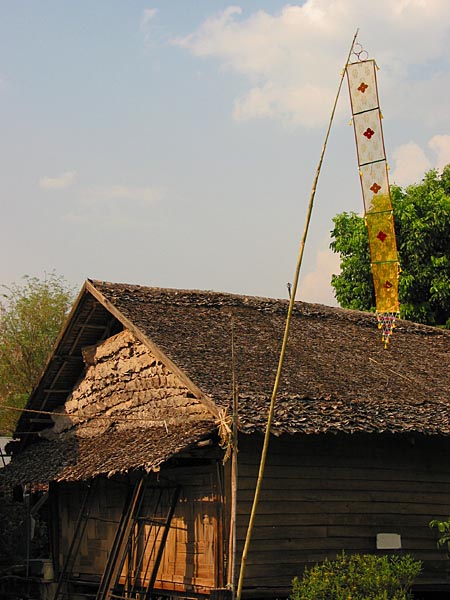
Simple house in Vieng Neuea
to concrete palaces like this one, owned by a big mucketymuck school teacher:
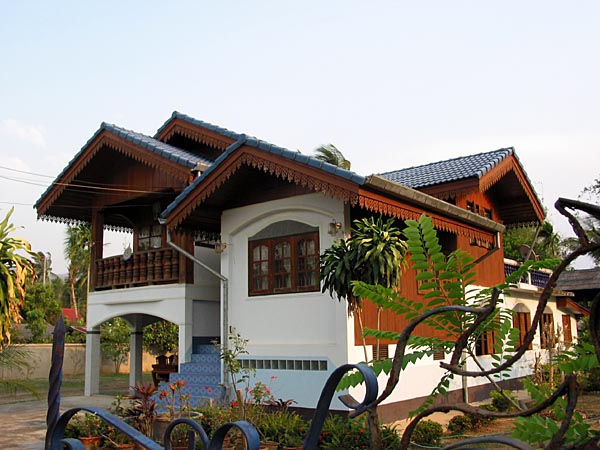
Big teacher's house in Vieng Neuea
All over town you can see these garlic/onion storage sheds:

Garlic storage shed in Vieng Neuea
During the January-February harvest, before the rainy season, the local farmers hire poor (often Burmese) workers by the hundreds to pick the vegetables and tie them in bundles of 20 or so plants. The workers then bundle the bundles together in giant 15 foot overflowing pickup truck loads, and drive the loads (all the while spewing forth garlic onto unsuspecting motorbike drivers) to these sheds. The vegetables hang in the sheds, safe from the rain and the flood. Dry vegetables are worth much more in the market and the storage facilities give the locals a way to spread their profit and risk over the next several months.
Novice Monk Initiation Ceremony
All over Thailand it is traditional for boys to become novice monks at least once during their life, for anywhere from a few weeks to a few years. April is a particularly popular time to do this because kids are just getting off school for summer vacation. In northern Thailand there are a lot of people of the Shan (Thai Yai) minority and they have a particularly beautiful ceremony. A family may spend upwards of 30,000 baht ($800) and a month of their time preparing for the huge event. Everything must go just right in order to assure good fortune for the family.During the 4-5 days leading up to the novice's entrance into the temple, the family and a few hundred of their well-dressed, closest friends parade the novices all around town in a day-long, noisy, happy celebration with clanging gongs, drums, and firecrackers. One such parade passed right by my house:

Novice Monk Initiation

Novice Monk Initiation
Every opportunity is taken to stop, dance around, drink, and be merry. Onlookers on the side of the road toss jasmine flower petals at the novices and join in.
You can get a rough idea of the celebration from these short movies, especially the first one where the novices themselves are gettin' down to the groove along with their carriers and the other Thais:
Novice monks and their family gettin' down.
Parade passing by.
Walking in parade.
The novices themselves are dressed up in extremely elaborate costumes with flower hats and face paint:
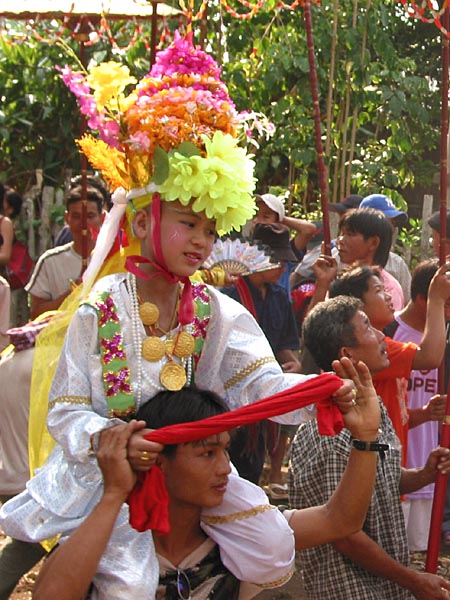
Novice Monk Initiation

Novice Monk Initiation
To the locals, the costumes make the novices look like little Kings, and indeed the novices are raised up above everyone else, on the shoulders of their fathers or close relatives, and others shade them with auspicious looking umbrellas.
It must be a truly amazing and overwhelming experience for the novice. Thais have such an intense system of social rank, titles, and deference. The kids have spent their entire lives at the very bottom of the social ladder, calling themselves "mouse" and rushing to get things for the convenience of their older siblings and parents. Now, all of a sudden, they are at the top of the world! Everyone is looking up to them and they are at the center of attention. One novice rushed up to me all excited after the final evening of the event and announced in English "I'm a monk!" It would be easy to conclude that they are the benefactors of this event. But, if you ask any of the Thais, they will say that the kids are becoming novices to honor their parents and assure good face for them now and good fortune (karma or however you like to analyze it) for the whole family in the future.
It's around 90-95 degrees during these parades and the novices are boiling hot in their costumes:
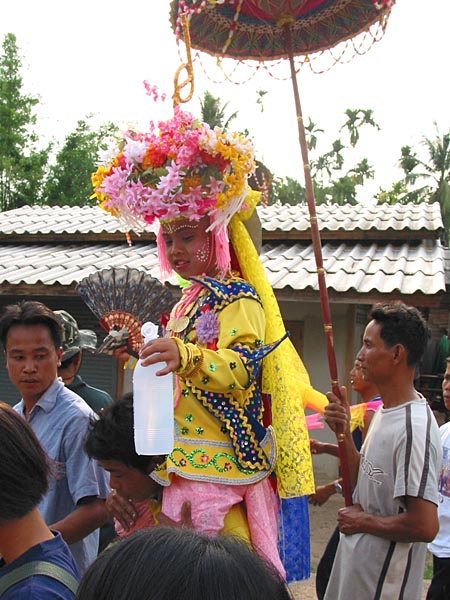
Novice Monk Initiation
Fortunately the novices get to return to the main party house and relax in the shade and the fan for a few hours before they go back out again:

Novice Monk Initiation: Hot Monk!
After the parades each day, there are huge, loud parties with Thai pop music, stages, lights, food vendors, and lots and lots of dancing. I saw 60-70 year old Thais dancing out in the streets until 2 or 3 in the morning, several nights in a row!
During the days of the celebrations there are various ceremonies, where the monks get their head shaven and receive their monks' robes.
At the end of the third day is the most important ceremony, because it's time to tam bun (make merit). The novices parade around one more time to the temple, but this time the procession is carrying rows and rows and rows of meticulously wrapped gifts, bowls, school supplies, utensils, and meter-wide money trees whose leaves are 20, 50, and 100 baht bills. It's like Alexander marching his phalanx of troops into new territories to intimidate his enemy, but instead of shields, swords, and catapults, they're carrying gloriously adorned donations! It seems like the longer and more elaborate the presentation, the more merit is made for the family. The family has spent the last weeks purchasing and arranging all the items into elaborate woven sheets and packages that hang from 3 meter bamboo poles, and from the side of brightly-colored 3-meter tall towers, carried on the shoulders of the paraders. Also, a few hours before the tam bun parade begins, the family brings empty money trees out in a pickup truck to every corner of the village, with loud gongs and drums announcing their presence, offering anyone in the village the opportunity to donate money (to tam bun themselves) and thus share in the merit resulting from this important ceremony. The procession circles the temple three times and then all enter to observe a ritual where the kids are initiated as novice monks. The novices then stay in the temple until they're ready to become normal humans again. The goods and cash, as far as I can tell, stay in the temple and are used for temple events and used to pay for maintenance and development of the temple.
In another Shan novice initiation I saw in a nearby village, they paraded the monks about 1km down the village's main street, and around the temple once, then one of the monks fainted from heat exhaustion (and a curse be on their family, I suppose)! They improvised by bringing the monks into the temple until the heat subsided then parading around the temple another two times at about sunset.
Music and Nightlife
When I first arrived in Pai in 2003, two farang women, who make a living playing guitar and fiddle at bars 3 nights a week in Chiang Mai, were visiting Pai. Like many guests, they decided it would be cool to put on a concert and within a few hours they had arranged to play at their guesthouse! They posted some signs around town, built a little stage with a bamboo raft, the guesthouse owner sold food and beer, and lots of people showed up. I think they split the proceeds with the owner. Another guy visiting from Chiang Mai is an expert at the Djembe, a kind of bongo-ish drum. He brought 10 drums with him which he had made himself, and after blowing people away with his performance (he played along with the two women at the guesthouse), he offered drum lessons and also sold his drums.Here is a song contributed by Pierce Vaughn. It was composed and recorded in 2009 in Pai by Pierce's brother and a friend. It's "Feeling Pai" by the Pai Rats:
These mostly unplanned performances layer on top of a set of more regular performances by artists who live in Pai, such as the Moon Village folks mentioned below or the amazing guitarist at Edible Jazz who played in 2003.
For 15+ years the requisite loud scene in town was the Bebop Cafe, where long-haired Thai musicians belt out blues, and other folks play rock and jazz, till the early hours. I didn't go there too much :) As of 2017, Bepop has been closed for a while but Pai has an increasing number of loud bars at various spots around town, though amazingly still not of the bar girl variety.
There's lots of bars to suit the typical binging backpacker traveller, offering everything from beer to hill tribe herbal whisky to a couple hits on a hookah.
Moon Village
On one night in 2003, there happened to be a lot of Japanese in town, and so a local cafe owner put on a whole show of Japanese music. I think he maybe distributed 20 flyers but about 70 people showed up. A jolly Japanese woman played simple but engaging traditional music on a 3-string banjo-like instrument. A group of Japanese hippies (something I never considered was even possible: their dreads, if unwound, would probably reach their thighs. I wonder if they would even be allowed back in their home country :) played a variety of music on the flute, mandolin, and this strange twangy soundboard thing called a kalimba (or karimba?). The players used their limited English to shamelessly plug their homemade CDs and make bad jokes. If their English was good it would have been crass, but instead it was charming and kept the audience engaged. One musician, a charismatic 3-year resident of Pai named Toron,
Toron (Source: Holly Mann)
explained that on his way back to Japan from a 10 year stay at a famous hippie utopia in India, he stopped off in Pai, and 3 years later, hasn't managed to leave. Young girls, the daughters of several of the musicians who've obviously spent their whole life "on the road," sat at the foot of the stage and watched their parents play. Some of the music was more like new age or "tribal" stuff, some was traditional. Later they started mixing in other farang musicians playing western flutes, and even a guy on didgeridoo (which, it seems, is a required instrument in Pai).
Toron created a place just outside town called Moon Village, a set of beautiful structures in the middle of a rice field where you can find an ever-changing cast of mostly Japanese artists, musicians, and other eccentric types. They built a huge hexagonal central hut:
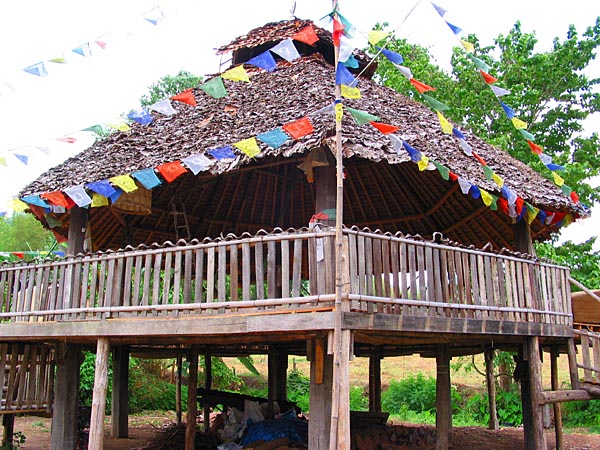
Moon Village central hut
And this stove and oven which they use every day:
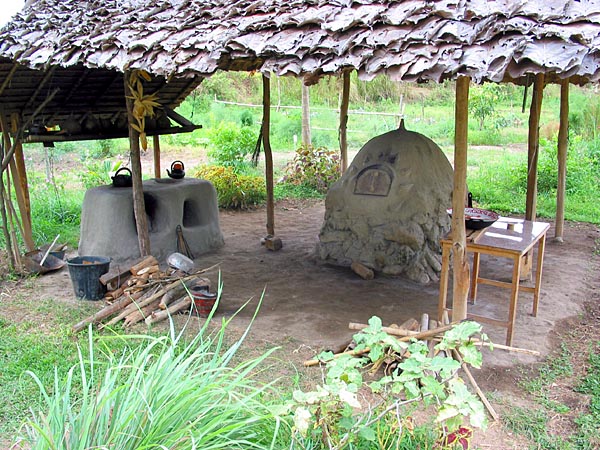
Moon Village ovens
It's always interesting talking to Toron because although his English is almost nonexistent, he has such a strong and positive spirit and complete patience for communication that he always eventually gets his point across (or some other point that's just as good!).
Toron previously helped organized many festivals in Japan. In mid-2004 he told me of his idea to hold a 7-week-long art/music festival in Pai on 07/07/2007. I find it amusing that anyone would try to organize anything in Pai 3 years in the future, but Toron has such an ability to inspire people that he might just pull it off. I took his flier and created a website for him, which you can find at:
(archive of soul-love-fusion.com)[2008 note: the festival long over, the site has now expired, and is archived locally for historical purposes!]
Check it out. And no, I have no idea what any of it means, not even the English. I just copied his flier. But after working with computer musicians and other computer artists in previous jobs/classes, and after a few years of attending Burning Man and checking out the people who go there, I have come to notice that this sort of odd non sequitur sometimes actually does bring together some very interesting folks who make music and art that even I can enjoy!
In 2008, thanks to encroaching development from downtown Pai and skyrocketing rents, Moon Village moved to a location further outside of town, along a dirt road that heads right off the main road between Vieng Neuea village and Tan Jet Ton village; the same road as Wat Praphuttabat but several kilometers further. The new location is beautiful and natural with water on all sides and very high potential for successful crops.
Map to New Moon Village2011 Update: Toron's 7/7/2007 festival was so fun that he has now decided to launch a new festival on 12/1/2012 (1 December 2012) for 108 days! It should be amazing:

Moon Village 12/1/2012 Festival
For all the information, see:
Moon Village 12/1/2012 Festival
Toron's Home Page
Map to New Moon Village
Follow the Bird (Bird's Eye View)
One of the coolest places in Pai does not appear on any tourist map. It's a little cafe hidden at the end of a dirt trail on a hill below Mae Yen temple overlooking Pai. It's just a simple, clumsy wooden and bamboo structure with hammocks and low tables, and it's also the house of the a Thai man and some farang ladies who run the place. Up until about 2006 they served a wide variety of teas and beers and also made crepes in the high season. As of 2006-7 it seemed to be a guesthouse rather than a restaurant, but anyway things are always changing there!
Follow the Bird panorama
Follow the bird is the place to go to catch the sunset, especially on the night after a rainstorm:

Sunset at Follow the Bird
In general it is a great place to relax and remind yourself that whatever is stressing you out can wait till tomorrow!

Sunset and Dream Catcher
Mae Yen Temple
There are several small temples in the Pai area. This one is located high up on the hill above Follow the Bird:
Mae Yen Temple

Mae Yen Temple
Mae Yen Waterfall
Pai has several waterfalls. Some of them (such as Mo Paeng or Phaem Bok waterfall) you can drive right up to. Mae Yen waterfall, on the other hand, is about a 5 hour hike out of town:
Mae Yen Waterfall

Mae Yen Waterfall
Perhaps as many as half of the people who set off for Mae Yen Waterfall never find it. This is because there is one tricky junction where you are walking on a well-worn, level path along the river, about 4 hours into the hike, and you have to spot another well-worn but hard-to-see path that climbs steeply, almost straight up the hill, about 160 degrees to your left and behind you. You cannot see the steep path until after you have passed it. If you take that steep path, you get to the waterfall in one hour, no problem. If you continue along the river trail (which is still well-worn at that point), in a few minutes it devolves into a horrific, rock-hopping, spiky-plant experience where you find yourself climbing slippery rocks that you're not sure you'll ever be able to descend. For the tiny percentage of people who actually slog it the whole way up to the waterfall, it takes an extra 2 or 3 hours!
So, if you reach bad terrain like that, turn around and look for the steep trail heading up the hill, which would now be on your right.
Bpang Dtong Karen Village
Jay, co-founder of the Yawning Fields, is a very interesting character. It seems to be some kind of soul searching that led him away from Bangkok university/city life out to the countryside. He built the Yawning Fields in search of a sustainable lifestyle that was quiet. After a year or so, he decided that not even Pai was quiet enough for him, so he found Mink to take care of the guesthouse and searched the countryside for the place he 'really' wants to be. He eventually found the tiny Karen hill tribe of Bpang Dtong, and he has now more or less adopted the village. The place has no electricity except for battery-powered flashlights and a few appliances which charge by government-provided solar panels during the day. He stays there as much as he can, up to 6 days a week. They've even built a hut for him, just the way he wants—a much, much more primitive hut than the other villagers have, right at the edge of the village where it is most quiet. He teaches English to the villagers and is currently trying to improve their low economic level by introducing tourism there. He has no wife or girlfriend but is a father figure for the village's 30 small children, who run to him when he pulls into town. Usually some of the kids stay with "Pii Jay" in his hut at night.He's clearly concerned about the effect foreigners and their money could have on the village's customs, but shows it in a strange an uneven way. He takes groups of foreigners to stay at the village and does not charge the foreigners. Instead, he has the foreigners purchase and bring certain foods that are useful to the village. But in 2003 he brought trinkets from the Chiang Mai tourist night bazaar to the village, telling the villagers (who currently do not make any clothes, bags, spoons, or other trinkets) that if they can figure out how to make those goods, they can sell them to the foreigners! In 2004 he abandoned this route and instead did all the work to package up and market something the village has made for a long time—natural, chemical-free, organic whole-grain rice. He printed 10,000 nice bags extolling the natural virtues and secured transport of the goods to markets in Chiang Mai and Bangkok, selling it for many times the price of regular rice. His goal is still to find a way to make the village self-sufficient and we wish him luck in this economic venture.
Jay seems to keep the kids happy by always bringing along some modern lure for them. If he's going to teach, he brings along a sweet green soymilk concentrate, and before each lesson the villagers cook up the dessert in a giant vat and distribute it to the kids, one bamboo cup at a time. After the kids' lesson, they generally get to watch a movie, which Jay plays from his portable VCD player on the village's battery-powered TV set. When I was there Jay had chosen Blade 2, which has got to be one of the most disgusting, senselessly violent kung-fu snap-their-necks-2-at-a-time cut-open-see-the-moving-guts gratuitous-vampire movie Hollywood ever made. Why he chooses films like this is beyond me; the kids of this village had likely never seen a movie, let alone a movie that makes Americans question the integrity of their own culture. With their eyes glued to the tube for 2 hours of horrors, the kids didn't quite know what to think, so they mostly laughed. Many of them were scared to even walk home that night and they had nightmares. When I first arrived I saw that all the boys, when they played outside, played at shooting kung fu fighting with each other. Another villager told me they never did this before Jay arrived and played shoot 'em up movies for the kids. I suggested to Jay that maybe this was doing more cultural damage than any number of farang visitors could ever do; he just said that he was careful to tell the kids that it was "just a movie; not real." I don't know, maybe a boy growing up in a Thai hill tribe regularly experiences things so horrible compared to my sheltered suburban upbringing that a few extra Hollywood trash movies can't hurt.
Jay often has the foreigners teach English too, either to the kids or the adults. When I showed up, since I could speak some Thai, he had me teach a very enthusiastic group of 6 or 7 adults. They all carried notebooks in which they diligently wrote every phrase and pronunciation they had learned, including some good ones from previous foreigners such as "I have a big hangover." Since I could write some Thai, Jay had me write sentences in English and in English with Thai letters for pronunciation, and attempt to give them explanations in Thai. I asked Jay what would be the most useful subject to teach, and not surprisingly we ended up doing "Would you like to go trekking?", "Would you like to visit a hill tribe?", "Would you like to visit a waterfall?", etc. It turns out that, after Jay's description of the outside world, these adult villagers were very excited about learning how to be trekking guides!
When I first met Jay at the Yawning Fields, he told me I could visit Bpang Dtong on motorbike in 40 minutes, so I included it in my "day trip" one day to the hot springs and canyon. I drove down the road on his map about 40 minutes, then 1 hour, then 2 hours, as it became clear to me that the entire "road" was going to be a steep up and down, narrow, treacherous dirt switchback which forded rivers and rickety bamboo bridges. I think maybe Jay chose this village because it will be the last one to see modernity; it is literally the last thing on the road and it is far from any public infrastructure. 3 hours after leaving, shaking and amazed I was still alive, I pulled into Bpang Dtong on my 100cc automatic bike and there was no way in hell I was going to try to get back the same day. So I ended up staying overnight and discovering all the stuff above. I couldn't help but wonder if Jay had understated the trip difficulty on purpose, but at any rate I came to peace with it after I had a chance to shower, cool off and calm down. It turns out that Jay, and (as usual) the 10-20 year old kids of the village actually can bike to and from Pai in 40 minutes, but if you're like me and have some sense of mortality, that is simply not possible.
This village was full of odd surprises. In addition to its modest Buddhist wat, it has a little Christian church too. Some of the villagers had been converted a while back, but everyone I asked clearly didn't want to talk about it. When I helped Jay return the TV to the school storeroom, I discovered that Bpang Dtong's tiny, mostly open-air school has a huge language lab, complete with 16 stations, speaker/microphone headsets, and all the gear! But there are no teachers (left?) who know how to operate it. Bpang Dtong also has two computers, but again nobody who knows how to use them. Jay told me this in such a matter-of-fact way; he seems to be unaware of, or indifferent to, the tragic waste of resources going on here. Perhaps, I guessed, the missionaries came to Bpang Dtong with generous gifts, but then got kicked out? The truth is likely to be even more scandalous, intertwined, and interesting :)
The Police of People—Really?
Before around 2001, the Pai police were a pretty much invisible and mysterious force who only interacted with foreign tourists when they launched the occasional motorbike helmet fine campaigns to pad their pockets.However, I am sad to report that starting in 2001 and growing much more serious since 2003-4, the whole atmosphere of Pai has darkened (and soured for many potential tourists, Thai and foreign alike) as nearly everyone in it has, in some way, become wary of the police here.
Those affected include both short-term tourists, who are seeing an increase in questionable drug searches, and long-term expats and local Thais, who are seeing other disturbing phenomena. This passage from the wiki page on Pai sums it up pretty well:
Controversy over Police ConductSo far there are no signs of this situation improving as we have already gone through several police chiefs during this period. However, I believe that the more people are aware of this situation (including both tourists and business owners), the less the police will be able to get away with.
Although it is a sleepy town in the mountains, Pai has over the past decade generated an unusual amount of controversy (even for Thailand) concerning the conduct of its local police, as well as the conduct of Thai drug enforcement police operating there. This is partially due to the proximity of Pai to drug routes from the Shan State in Burma, however given the post-2000 rise in incidents involving foreign tourists, it is evident that other factors are also at work. Some examples of this clear long-term trend in Pai include:
- On December 24th, 2001, the local Pai police arrested and jailed the owner of Bebop bar, with the rather dubious explanation that he was "letting people dance in a place of business not officially licensed as a 'disco'" (ref: Joe Cummings' December 2002 Chiang Mai CityLife article about Pai Police). After this event, both Bebob and Mountain Blue received additional discriminatory treatment in the form of illegal, or uneven, application of Thailand's closing-time laws. The so-called "dancing ban" by the Thai Police became a famous and well-known joke which business owners are still talking about in 2008.
- Also in 2001, and again in 2003, Pai district officials and police began enforcing several illegal measures ostensibly aimed at increasing "safety" for the local tourists, specifically "a 'recommendation' via illegal denial of permits whereby all guesthouses must have walls made from a solid material, such as wood, gypsum, compressed fibre or cement" (ref: Chiang Mai CityLife article on Pai permit denials) rather than the cheaper and more traditional bamboo favored by many guesthouse owners and low-budget backpackers. Most locals suspected other motives were involved, including both a desire to "weed out" low-budget tourists and to encourage higher-priced construction that would generate higher construction kickbacks. Several locals pointed out uneven enforcement of these laws for different businesses, depending on personal relationships with the police or district officials.
- The so-called "War on Drugs" launched in February 2003 by former (now deposed) Prime Minister Thaksin Shinawatra, in which "more than 2,000 people in Thailand were killed as the government effectively declared 'open season' on those accused of involvement in the drug trade" (ref: Human Rights Watch report on Thailand's 2003 "War on Drugs"), took a heavy toll on Pai district and downtown Pai in particular. Many locals whose family members were murdered without investigation now take an extremely skeptical view towards any police action here (ref: Personal interviews; those involved are not willing to go on record in any way, for obvious reasons.).
- In 2006, the Pai Police purchased a new mobile drug testing vehicle, and there have been numerous reported instances of the police entering bars and other establishments and randomly urine-testing foreign tourists. In many of these cases it is apparent that the searches were not performed legally. In Thailand, "when requesting urinalysis for drug identification purposes, at least one member of the Narcotics Suppression Police must be present. Regular Thai police do not have this right, nor do the Tourist Police. Second of all, there must be probable cause" (ref: Pai Post, July 2007 article on rights of foreign tourists by prominent Bangkok law professor Ajahn Kittiwat Ratanadilok Na Phuket). In most cases, apprehended suspects are detained in Mae Hong Son jail for a few days, then released with a "fine" typically on the order of 5,000-10,000 baht (ref: Personal interviews with subjects who prefer to remain anonymous).
- On January 5th 2008, Pai made national and international news when an off-duty police officer, Sgt-Major Uthai Dechawiwat, fatally shot Canadian tourist John Leo Del Pinto, and shot and wounded a second Canadian tourist Carly Reisig, fleeing the scene immediately after the event (ref: CTV (Canadian) report on double-shooting, ref: Andrew Drummond report for The Nation on double-shooting). Nearly all involved believe that both the policeman and suspects were drunk at the time. Official police reports differ widely from eye-witness reports and it is expected that the officer will be acquitted by the Thai Justice system.
In an extremely unusual development which highlights the deep integrity issues that exist with the Pai police, reporter Andrew Drummond published an editorial in The Nation where he expressed his regrets for publishing views from all sides of the story in his earlier Nation article because:"While the facts presented were true, they have been wrongly taken in a malicious way by many...What the journalist cannot convey sometimes is his opinion of whether the witnesses are telling the truth or show immediately what links these witnesses have to the police....I am very concerned at several aspects of this case:
- The police claiming that Reisig was pregnant and this had angered a jealous foreign boyfriend.
- The claims by the police shooter that he had been out of town before the shooting, when other witnesses were saying the officer was drinking heavily that night in Pai.
- The threats to prosecute Reisig for assault on police.
- The automatic bail for the police gunman.
- The fact that local police are investigating themselves.
- The claims that the gun had discharged three times accidentally."
(ref: Andrew Drummond's doubts about the way the shooting case was being handled)- In a January, 2008 editorial published in Chiang Mai CityLife (submitted in December, 2007), (ref: One Tourist's View of excessive police action) anonymous author "A Tourist" eerily anticipates the January, 2008 shooting in his/her strongly-worded objection to excessive police actions in Pai:
"I have noticed another significant change over the last year, which is the reason for writing this letter. The method of law enforcement in this small town needs to be seriously examined....I accept that changes are necessary. I also agree that noise pollution should be carefully monitored and controlled, as should drug abuse and any other illegal acts or unpleasant kinds of behaviour, but we ought not to be scared to leave our homes (or guesthouses)! ... One Saturday in particular remains in my memory, where several police officers decided to inspect a party at a bar in town. I believe that they were looking for drugs. I along with many other tourists was especially shocked to see that one officer was carrying a machine gun...This kind of behaviour is likely to scare tourists and leave very negative impressions on them with regards to Pai town as a holiday destination...The police are also actively confiscating mother vehicles, testing individuals at random for drugs and alcohol abuse, detaining owners of restaurants and bars for remaining open past the agreed time, and generally making a lot of noise in a relatively quiet town that did not appear to have many problems beforehand....The increased police presence is clearly visible and does not, in my opinion, make Pai town look like a place one would like to visit. There is also a general feeling of unrest here and I feel that it is quite obvious to the tourist travelling through. The police are unapproachable and menacing. This has a strong negative impact on the atmosphere here in Pai town. The previously friendly and welcoming town appears to have changed into a place where everyone is afraid to even walk down the street in case they are accused of doing something wrong. Should the police not be employed to protect civilians? Should they not be approachable in case I or someone else requires some help? They are certainly not even close to doing what a police force is meant to do."
The policeman mentioned in the text was in fact completely exonerated and as of 2009, he is back on his beat, in Pai, still carrying his gun, and still frequently spotted drunk out of his mind at local bars. His case was dropped due to "irregularities;" it's an interesting kind of justice when one's case can be dropped due to irregularites that are those of the justice system dropping the case. The slain Canadian's family still holds out hope for some kind of justice and we wish them the best of luck.
2010 Update: Adding the ultimate in insult to injury, on 18 September, 2010 the very same policeman, free and unfettered with his gun and his alcoholism, clubbed his 18-year-old Thai wife Manta to death with a piece of wood. Apparently this offense was so egregious that not even the Thai constabulary could cover it up. He pled guilty and was sentenced to 25 years in jail. It is extremely unclear how much, if any, of this sentence he will actually serve.
One can only feel one's stomach burn and churn at the deep and sad irony that the death of this innocent Thai woman could have been completely avoided if the Thai justice system had not turned a willful blind eye to the obvious perils of letting this man walk freely on the streets of Pai.
2017 Update: Unbelievably, Carly Reisig, the victim who survived, kept at her search for justice for almost ten years of fighting, flying to Thailand to go to court more than 9 times. In October 2017 she obtained a judgement in her favor in her case against the Thai police "for dereliction of duty plus several other charges." Given that This is Thailand, it it still far from certain if she will ever receive the monetary settlement, but it is an amazing show of courage and determination in a situation where her life is in as much danger pursuing this case as it was being around the killer cop in the first place.
Around 2007, police installed a series of at least five closed-circuit security cameras around town (this for a town with 2 signals and 5 streets total). No idea if anyone ever watched the pictures, or if the cameras were even connected, but it was just another Orwellian step away from the formerly casual and friendly atmosphere.
2012 Update: In February 2012, a Pai resident posted a quite positive review of the fair and excellent job done by the newly appointed head of the Pai police investigative unit in a robbery case. Let's hope that positive trend continues to spread to the rest of the Pai police.
The Pai police inhabit this imposing building. The sign says "Police Station: for the People" in Thai and then "The Police of People" in English. Um, yeah:

Pai police station
In 2008, thanks to an apparent in-rush of funding, the structure above was razed in favor of a gigantic concrete tower. Who rewarded them?
2017 Update: The police trends mentioned above have not abated, with continuing urine tests, bar raids, and pointless enforcement of marijuana. The only difference is that over the years, the majority of artistic, creative types who made Pai interesting (and who were, ironically, responsible for the popularity that gave rise to the Horrific Bangkok Thai Swarm), have left Pai, both because of the undeniable climate of fear created by the Police and becuse of rising prices.
"Development"
Pai is rapidly transforming from a quiet countryside town into a fully "developed" city. Sadly, in the process, it is losing much of what made it so attractive to visitors.During 2003-2006, nearly every new farang and Thai visitor I met would tell me that they got "stuck" in Pai for days or weeks longer than they expected, because it was such a natural, relaxing place.
Starting in 2006, and especially in 2008-2012 with the coming of the Horrific Bangkok Thai Swarm, visitors tell me how disappointed they are by the traffic, by the commercialism and fakeness of our new "walking street" market, which is essentially an exact copy of Chiang Mai's tourist-oriented Sunday Market, and by the ever-increasing difficuly of finding nice scenery, as more and more rice fields and old teak houses are torn down to make way for concrete guesthouses and shophouses. Nowadays, many visitors actually tell me that they are leaving sooner than expected because Pai wasn't anything like they had heard.
Quite a change in just a few years. What follow are some 2006 viewpoints on that.
You can get some additional 2008-2012 viewpoints in my special update about the Horrific Bangkok Thai Swarm.
Bangkok Post / Pai Post Article
Pai was featured in an English-language article called "Paying the Price of Development" by Suthon Sukphisit, published in the Bangkok Post on 21 October 2006, and re-published (without change, but with a new Thai translation) in the December 2006 Pai Post.While the author's heart is definitely in the right place, and while this article makes a number of good points and suggestions, there are a significant number of factual errors and oversimplifications which I think give a skewed view of the "development" problem and which could hinder our ability to find a workable solution.
I should note that while I have lived in Pai since December 2003, I do not own or run any local business here. I have no love for development (as should be clear from my journal), yet I still believe there is something amiss in the author's analysis.
Here is the complete article with some annotations to help set the record straight.
By Suthon Sukphisit
Thirty years ago, Pai in Mae Hong Son province was a little village made up of wooden houses with banana leaf or galvanised steel roofs.
Not a promising start. Banana leaves decay to nothing in a few months. The only people I know who made banana-leaf roofs were the formerly nomadic Mabri (or Mlabri) tribe of Nan and Phrae province! Local leaf roofs here are made from ตองตึง (dtong dteung, also called พลวง (pluang) or dipterocarpus tuberculatus), which looks almost identical to a teak leaf but nothing like a banana leaf.
This is a minor point, but it's one that a real Pai local would never get wrong. It calls out a theme that I see throughout this article: the author seems to be relying too heavily on secondary sources (including, possibly, my journal) and I'm not sure if he spent that much time actually visiting Pai himself.
Every once in a while a car would pass along the road, but it was used primarily by cattle and water buffalo and their owners, moving from one grassy meadow to another. The local people called the part of town that the road passed through the "lower town". There was also an "upper town", set on a hill not far from the lower town. The only thing separating them was the Pai River.
I'm not sure why the author chose to use these obscure names (bad translation? a futile hope of obscuring their location from land speculators?) but the "lower" and "upper" towns in question are Vieng Dtaai (เวียงใต้, downtown Pai) and Vieng Neuea (เวียงเหนือ), the supposedly unspoiled town where I have lived for more than 3 years.
It is true that Vieng Neuea is much older than Viang Dtaai. According to local historian Thomas Kasper (who also runs a restaurant in town: don't assume that all non-local business people are here to exploit and destroy the local culture!), Vieng Neuea was founded in 1251 AD by Shan immigrants from modern-day Burma, whereas Vieng Dtaai wasn't established until the late 1800s.
Throughout much of its history, Vieng Neuea consisted of a Shan "side" and a Lanna Thai "side," whose residents didn't get along. The wall actually separated the two halves of town. It is symbolic of a important economic split that exists today, a split which the author of this article ignores: nowadays in Vieng Neuea you will find established upper-middle-class families who will call themselves Thai or Thai Yai (ไทยใหญ่, indicating distant Shan heritage), and then you will find hundreds of extremely poor recent immigrants from the Shan State of Burma (refugees, really) who the locals refer to as Thai Nook (ไทยนอก, where Nook means "outside").
There are hundreds of thousands of Thai Nook in Thailand, many of them in Mae Hong Son province. The Thai Nook provide a cheap labor force for farming and construction. Some of them are here illegally, and some of them have local sponsors and limited papers from the Thai government that essentially make them indentured servants who cannot own land, vote, switch employers (except once a year, if they can find a new sponsor), or even leave Pai District!
It is the Thai Nook who will first feel the effects of "development" in Pai because they are the ones who are most sensitive to the prices of everything. Ironically, they are also the ones who farm our rice and garlic, and they are the ones who build our guesthouses and restaurants.
Many of the Thai and Thai Yai, on the other hand, are the business owners and landlords who have profited big-time on Pai's "development." It is completely inaccurate to say that all of Pai's new fortunes go to Chiang Mai or Bangkok Thais. More on this below.
Vieng Neuea is quieter than Viang Dtaai, but both places have temples and surrounding fields and orchards, and both places have commerce. In addition to the local Vieng Neuea market, which has existed for longer than Vieng Dtaai itself (and which, by the way, was converted into a concrete minimart in January 2007), there are at least 5 other housefront grocery stores and 2 small-scale noodle shops where locals eat, and the locals here make and sell beautiful traditional teak furniture using a combination of modern tools and traditional methods. For sure, Vieng Dtaai has a lot more commerce, but let's not kid ourselves into thinking that Vieng Neuea is some kind of residential paradise.
With so many attractive qualities—natural beauty, a history extending back to ancient times, and a diverse, colourful population—it isn't surprising that travellers passing through the community might fall under the spell of the local atmosphere and might want to get out of their cars and stay for a while.
As a result, over the past 20 years, a period in which Mae Hong Son has experienced a boom in tourism, visitors to the region, especially Westerners, have been showing up in Pai in growing numbers. Many found it even more impressive than Mae Hong Son because of the comparatively unspoiled natural environment.
The first group of Western tourists to begin arriving in Pai for extended visits were the backpackers. Some homes in the lower town were converted into inexpensive guesthouses to accommodate them.
Soon word about the town began to spread.
Its popularity expanded, with a constant stream of tourists pouring in year-round. Thai tourists began arriving, too, and the media discovered the town, with coverage in both domestic and foreign publications and television programmes. Articles appeared under headlines like, "Pai, an Earthly Paradise", "Sleep in Pai and See Heaven", "Heaven Really Does Exist—in Pai", and "If You Haven't Visited Pai, Your Life is Incomplete".
This is accurate. It's important to note that the tourist demographics are rapidly changing. Starting in the 2006 high season, until at least January 2007, I have seen a marked increase in the percentage of Thai tourists. My guess is that foreign tourists are being scared off by some combination of:
- Word of the increasing development and "uglification" of Pai,
- The draconian and unfriendly Thai visa law changes of 2006,
- Various unsettling events like the Tsunami of 2004, the Pai Floods of 2005, the coup of 2006, and the Bangkok bombings of 2007
There is another important fact here which the author doesn't mention. The different groups of tourists who come to Pai have very different tastes, and affect the culture, architecture, and environment of Pai in very different ways.
Generally speaking, the budget backpackers who have been coming to Pai since the 1970s like Pai the way it is. They are happy staying in bamboo or wood places. They happily eat the local food and like to interact with the locals. Perhaps the largest degree to which their presence twists the local economy is the increased availability of weed and banana pancakes. These tourists do not create a pressure for concrete mega-resorts, loud parties, or hard drugs like yabba or heroin.
A more recent tourist trend is young school-aged island-ravers from the US (spring-break), Isreal (post-military-service-walkabout), and other places. After the tsunami we saw a lot more of these folks, who like to party with loud music and will buy lots of beer and other substances at such events.
Finally, and most significantly for the environment, we have the recent wave of Thai tourists and high-end foreign tourists (which I expect to become an all-consuming torrent now that regular airplane service has begun). These consumers demand high-end wood or concrete rooms with bathroom inside and trigger the most environmentally-damaging construction.
While there are lots of Chiang Mai and Bangkok business owners here, there are still plenty of Pai locals who have gotten rich off the tourism industry as well. Don't forget that many of the businesses rent their land from locals. The Pai local who sold out, er, I mean, rented his teak shop out so that it could be destroyed and turned into the city-wide blight known as 7-11 rides around town every day with a huge smile on his face.
It is not productive to blame all the development on outsiders, because that implies that if you could just kick out all the outsiders, Pai would return to its pristine past. But money corrupts locals just as easily as it does Bangkok Thais.
Those who could neither play nor paint tried their luck at operating food shops which they decorated in eye-catching, trendy styles.
Most people, even the locals, seem to appreciate the eclectic local art and music (which often combines Western, Japanese, Thai, and other styles), as long as it doesn't get to the point of blasting from speakers until 2am (see below). The presence of non-local art and music does not seem to be one of Pai's "development" problems, as the author suggests later in his article.
Most Pai locals have, at some point, had a problem with tourists (mostly foreign) who walk around barefoot or bare-chested, who scream and yell rather than staying calm, or who kiss in public. To that end, Pai publishes a list of "Pai Ways" in the Pai Post, in a the biweekly events planner, on the walls of many guesthouses, at the hot springs, and at other locations. Most of the offenders are short-term tourists, not the expats or locals who bring the music or art.
Some of the shops built by both local and non-local owners are extremely beautiful teak or bamboo structures that use ancient building materials and techniques native to this area. Some are ugly concrete chinese-style shophouses as seen all over Thailand (and many of these blights were built by locals who have lived in Pai for generations). Some shops are horrible fluorescent day-glo monstrosities that, in my humble opinion, should be knocked down and moved to Bangkok. There is not a strong correlation between whether the shop owner is a local and whether their building follows local ancient tradition. It appears that the author is trying to suggest otherwise.
This statement is extremely confused, and it indicates that the author needs to spend more time actually seeing what happens in Pai: some tourists go on jungle tours to hill tribes on foot or by boat. They are not interested in the "risk" factor: they want to see remote hill tribes and their customs.
Some tourists rent off-road motorbikes to go on day trips tearing around the local hills, but these are hardly jungle tours. Very few tourists, perhaps none, do both at the same time. Tourists have enough sense to know not to tear up walking trails that villagers use to transport their goods to market.
I am really wondering if the author might have based this statement on a misunderstanding of the harrowing account of my motorbike trip to Bpang Tong village that appers in my own journal website.
Let me set the record straight: the journey was harrowing for me because I was an inexperienced motorbike driver. I did not go there to seek out "risky sport" and to this day I still haven't returned because, even though I now have years of experience and even though I'd like to meet the people there again, I still don't like the road. However, then and now, the local kids do this same trip every day, 3-on-a-bike, on much older and weaker motorbikes than I had, as part of their normal life needs to go to school and/or market.
As one local here likes to say, this sentence is complete bollocks.
This sentence is pure sensationalism, nothing more. The author should be ashamed. It is inaccurate in every possible respect, and strongly suggests that the author has not actually been to Pai.
First of all, as someone who has traveled in Thailand for 7 years and then settled down in Pai for 3 years, I can tell you with certainty that this place has the lowest amount of foreign-customer-oriented prostitution I have seen for any tourist town in Thailand. It is why I like Pai, and one of the main reasons why I chose to live here.
Chiang Mai and Bangkok are full of "girl bars" where scantily-clad females grab at foreign tourists on the sidewalk and drag them in. Many smaller, countryside towns I've visited in Isaan and northern Thailand have fairly obvious places (typically bars or karaoke joints) where some of the staff are clearly "available" to both Thais and foreigners for take-away. But, at least as of January 2007, Pai has no obvious places like this, and I consider this one of the most amazing hallmarks of the place. It is one of the things that I believe will change instantly with the debut of regular airplane flights, lowering the barrier to a new, annoying type of tourist who will seek out and pay for "extra services."
I have heard only unsubstantiated rumors of prostitution in Pai, nearly all involving local girls. Most of the rumors I have heard I know to be false: Pai is a small town and the local chatty vendors at the market like to make up stories to keep life interesting. In Pai, merely seeing a woman on the back of a guy's motorbike is enough to start a rumor that she is a prostitute. I've no idea where these prostitutes the author speaks of might have "flocked in" from or to.
Perhaps the author is confusing foreign-oriented prostitution with Thai-oriented prostitution. It is an unspoken but universally known fact that the farang-customer-oriented prostitution industry is dwarfed in size and age by the Thai-customer-oriented prostitution industry. Even in the smallest countryside towns in Thailand, local men (yes, even the local officials) can find "comfort" in well-hidden local hovels, where foreigners are not welcome. Pai is no exception to this.
Or, perhaps the author is confusing prostitution with relationships that aren't just short-term exchanges of sex for money. Years back, I had a Thai girlfriend and we used to travel around the country. We both personally experienced the stigma attached to any Thai-Western couple: Thais would see us and instantly assume that my girlfriend was a prostitute and that I was her customer. One old man in Bangkok even asked my girlfriend "how much did you get from him?", assuming I couldn't understand.
As my Thai co-author and I were doing research for our book Thailand Fever, which is about Thai-Western romantic relationships, we discovered that many Thai-Western couples experience the same stigma, and that that stigma still exists today. The author, or someone who the author used as a secondary source for his article, probably assumed that any woman seen with more than one man in Pai must be a prostitute. The author needs to use a larger grain of salt when listening to the incessant Pai rumor mill.
In actual fact, there are lots of Thais in relationships with foreigners here. This includes not ony Thai women but Thai men as well. Some of the Thais were born here, some are from nearby hill tribes, and some came from Chiang Mai and Bangkok to work. Many of them are long-term and/or married with children. Many own businesses together.
Some (but not many) of the Thais involved with foreigners here do seem to go through a lot of partners. Some of these Thais are desperately looking for a foreigner who they hope will help them break out of their current social class and provide comfortable living for their family. Some of these Thais have a modern view that sex does not need to be attached to marriage. Does that make these Thais immoral? Perhaps, according to the traditional views of older Thais in Pai. Does that make them prostitutes? No.
Again the author is over-simplifying.
There are still plenty of rice, garlic, onion, cabbage, orange and other crops made in Pai District and Bpang Ma Pha district on sale in the local markets, and the local restaurants do buy them and use them. However, for many fruits and vegetables, there is simply no way that local growers can produce them and make a profit, because they are competing with large growers in Chiang Mai who don't have to pay as much packing and transportation costs to get their goods to the largest markets. Those items have to be imported to Pai. This would be the case even if there were no "development" in Pai (either that, or the locals would have to do without them).
As far as construction materials, where does the author expect us to get them from? How exactly have "the people of Pai" missed out on the construction material business? As far as I know, nobody local has either the knowledge or desire to manufacture nails or tools, and other than bamboo, all possible building materials like teak have already been exhausted. It is illegal to cut teak, and those who do it illegally now have to hike days into the jungle just to find some usably large trees! People here are now almost universally buying old teak structures and re-using the wood, or else using eucalyptus tree poles (from Chiang Mai) as a replacement for teak poles. Isn't that a good thing?
Furthermore, the author is over-simplifying "the people of Pai." He makes it sound like everyone who was born in Pai is now cleaning toilets.
"The people of Pai" includes the Thai and Thai Yai landowners who clean up on ever-increasing rents from (local and non-local) business owners. "The people of Pai" includes the locals who now run booming food and construction supply import businesses, the hardware stores, and guesthouses. "The people of Pai" includes the local government, which is fat and happy on taxes and fees.
"The people of Pai" also includes many poorer folks who do work as janitors or unskilled laborers. Many of these workers are Thai Nook or hill tribe folks. Perhaps the authors' comments apply most directly to them.
The waiter and receptionist jobs, on the other hand, tend to go to the kids of upper-middle-class locals, or even more often, young folks from Chiang Mai and Bangkok, who come pre-equipped with the required minimal English skills.
This is a shame because it effectively blocks the poorer locals from learning English, which might give them serious new opportunities for work and money in the future. If someone out there wants to really help the locals, then come set up a stable, long-term, free or low-cost English school that doesn't exclude (or even caters to) these people.
One thing that "development" has brought to Pai that is probably net-positive is good internet service. Locals now have access to information, news, and market data that they did not before. But again the poor Thais have been locked out of this by their lack of money and English skills. So, in your language school, please offer free internet access too!
Another oversimplification that makes the locals look like angels, and seeks to place all the blame for noise on tourists.
It's definitely true that many tourist business owners have blasted horrific music, ranging from plucky, empty-headed modern Thai teeny-bopper pop tunes to techno trance rave music, to ridiculously late hours of the morning. Nobody likes them: not the locals and not even the tourists or expat residents. One particularly insensitive business, which tried to introduce a Ko-Phangan-style rave to the quiet Pai valley, ended up with a molotov cocktail in their bar a few days later!
But guess what: some of these businesses are owned by locals! They're chasing the money, just like the other business owners.
Aren't the police supposed to answer calls about noise? Where were they? Why do some parties get shut down after just a few minutes of noise but some go on all night? Perhaps the biggest problem isn't the noise. It's the willingness of police all around Thailand to ignore such transgressions, for a fee.
And this ridiculous noise phenomenon is not limited to tourist venues. About once every two months during the dry seasons, the locals in my untouched, pristine village of Vieng Neuea hold a temple festival. These festivals are not announced to tourists and at the peak there will typically be 200-800 Thais and maybe 10 tourists (you'll see the same ratio in temple festivals all around the valley—everywhere except Viang Dtaai).
At these festivals, the locals blast folk music and Isaan-style maw ram, often until 1 or 2 in the morning. At many festivals you will also have the "dancing girls," wearing very, very short skirts and dancing on makeshift stages for hours and hours.
Is this an effect of "development?" No. These are locals doing this to themselves. They are not doing this to attract foreigners or investment. For some reason, they like the cacophony (personally, I can't stand it) and they don't stand to earn any money from it.
This presents a simplistic, rosy picture of innocent locals being corrupted by non-local invaders, as if keeping the tourists and non-local investors out of Vieng Neuea would somehow keep it pure.
However, life is not so simple. Many of the locals are taking on these "evil outside ideas" by other paths that are not related to the tourist influx. Television is a big one, but there is also the bizarre occasional phenomenon of Pai Gangs, in which young, bored upper-middle-class boys with expensive motorbikes engage in petty and pointless gang warefare on the streets of Pai, and fight during the late-night hours after temple festivals, because they have nothing better to do. One of these contingents of wannabe gangsters comes from my own home town, the sweet, innocent Vieng Neuea.
Were these boys imitating the local tourists or long-haired musicians? Definitely not.
Is tourism money and development to blame for their behavior? It might have been a factor (or was it drug money from the yaabaa trade?), but aren't the kids' parents somehow accountable for how they raise their kids as well? Furthermore, didn't that money also benefit them by giving them access to education and leisure time?
Yay! Finally a sentence where I am in complete agreement with the author!
A flash flood from the Pai River drowned the lower town and did so much damage that the investors began looking for a more congenial place to put their money. Of course, the obvious choice was the upper town. Not only were land prices cheaper, but the view from the high ground was better.
Again, this really makes me wonder if the author has actually ever been to Pai.
Land speculation in Vieng Neuea began many years before the flood. Most of Vieng Neuea and Vieng Dtaai are on flat land that has no view. The two towns have approximately equal areas of land with a nice view (assuming you count the land on the nearest hill overlooking Vieng Dtaai as Vieng Dtaai; technically it is in neighboring dtambon Mae Yen). Furthermore, there was flood damage in both Vieng Dtaai and Vieng Neuea (for example, the high-end resorts Baan Krating and Sipsongpanna were both devastated, and they are in Vieng Neuea).
It is true that nowadays, investors are buying more land outside of Vieng Dtaai. But that is because all the land in town is now taken, or overpriced, not because of the flood!
Assistant Professor Duangjai Lothonwanit of the Faculty of Arts at Thammasat University, who has done research on tourism at Pai under the effect of globalisation, has come to the conclusion that all of the town's problems have arisen from investors crowding in to look for business opportunities.
I would very much like to read this study. If anyone has access to it, please let me know.
Now the land in Pai, especially scenic property on the mountain slopes or on the bank of the river, belongs exclusively to owners in Chiang Mai or Bangkok. The purchase of some of the land by celebrities gave the properties a high-class aura that stimulated the local real estate business further. Services offered by restaurants and accommodations had to be adjusted to the expectations of city-dwellers who expected good food and comfortable lodging with all the latest conveniences.
An important factor contributing to the problem was that the government took no steps to control the ratio of outsiders to locals...
The buy-and-sell process the author describes here is how real estate works in any capitalist country of the world. Like it or not, it is not illegal. You'd even have a hard time convincing anyone that it's unethical. Any solution to the "development" problem has to work within the real-world constraints of a capitalist economy.
The author claims the land "exclusively" belongs to outsiders now. This is incorrect. There are local landowners cashing in on the tourism trade, and buying and selling their way up the property ladder, as well.
If Vieng Neuea were to try to limit land ownership to locals, then we'd just end up with the same number of hideous guesthouses and businesses, all owned by locals and leased to Chiang Mai or Bangkok Thais. This would not solve our "development" problem. If you don't believe me, just look at the number of Pai businesses that are leased to foreigners, who for years have been restricted from owning land. Restricting ownership just increases the amount of money given to lawyers and government offices; it does not slow development.
In fact, during the period from 2002-2006, there was an awful lot of building-material-related regulation that came down from the Pai government. The problem was that the regulations were purposely vague and selectively enforced so that the government could weed out those they don't like and support their friends, in the process working more against conservation than for it.
For example, a previous Pai mayor declared that no future buildings could have leaf roofs. At certain points, it even seemed like all bamboo huts would be illegal, and only concrete buildings would be allowed.
The official reason was safety, but after a few years of selective enforcement it became clear that the real reason was graft and the desire to support high-end, high-dollar businesses at the detriment of small guesthouse operations. This banana-republic circus was exposed in a number of articles in Chiang Mai and Pai newspapers and magazines. It was an embarrassment for Pai and quietly faded away.
Then, later, came the "color wars." For a time, blue-colored roofs were illegal. Then, blue was okay but green was illegal. What is going on?
Any real solution to control development has to have some longevity, so developers have a chance of even knowing what is going on, and it has to have some teeth against those who misuse the regulatory power for graft. I have no idea how to accomplish that, but a good first step would be to make all building permits, complaints, and decisions a matter of public record which anyone can access free of charge, easily, and without prejudice.
Objections were raised to this plan, but district officials countered that it was all for the good of the local people: If someone needed urgent medical attention they could quickly fly to Chiang Mai for treatment. This argument was ridiculous, because local people were highly unlikely to be able to afford the fare for the 12-seater plane.
These were some of the facts that Asst Prof Duangjai learned had taken place at Pai.
Very interesting.
I believe that regular airplane flights will transform Pai in a massive and irrevocable way that will make the development to date seem trivial. I hope I'm wrong.
For the people of the lower town it is too late for anything to be done, but there may still be a way for the upper town to put the brakes on the kind of high-speed change that ruined the lower town, and it must be done by the town residents themselves.
They must construct armour to protect themselves. The first thing is to make sure that no service businesses are allowed to operate there. If absolutely necessary, guest houses might be allowed, but they would have to follow strict specifications as to size, architectural style, and distance from the road (taking into account the way the use of the road might change in the future). Refuse disposal, waste water and noise would also have to be closely monitored.
These guesthouses would have to render a "social tax", separate from the tax paid to the government, directly to the local community. This would take the form of supporting the maintenance of the road, keeping it clear and in proper condition, cutting down unwanted plants and weeds growing along the sidewalks, and placing rubbish bins along them at intervals.
They would also be asked to contribute money to support community activities.
The upper town community would have to see to it that any changes and extensions of buildings and residences there do not clash with the local architectural style. Building materials would also be restricted, with coloured tile roofs and metal fences banned.
All great ideas, and to varying extents they've been tried before in Vieng Dtaai. But the greed of developers (local and non-local alike) and government graft always got in the way of making the building regulations clear and consistently enforced. I don't see any reason why the same thing wouldn't happen in Vieng Neuea.
Perhaps if this relatively small community could get together and organize well enough so that anyone who tries to build a huge ugly illegal guesthouse gets publically embarrassed in front of the whole town, it might work. But that is not how things tend to work in Thai culture: the one breaking the law tends to be the mayor, policeman, or other village elder, and people will tend to defer to his higher social status by not confronting him.
For the record, there have been service businesses in Vieng Neuea for many years (more than five guesthouses and hotels), and one of them, Baan Krating, appears to have already rendered a "social tax" in terms of funding the post-flood shoring up of the major concrete bridge that leads to their resort (and to the rest of Vieng Neuea).
The author is writing exclusively with the honorable but ultimately academic goal of preserving local architecture, arts, and culture. The people of Vieng Neuea value this, but unlike the author, they also live in Vieng Neuea. They want a nicer house, a TV, a nice SUV, and other stuff too. They understand that opening a guesthouse or other tourist-oriented business can bring them these luxuries.
While some Vieng Neuea residents do look on Vieng Dtaai as a cultural toxic waste disaster area, and would support strong building regulation, others admire the "prosperity" of Vieng Dtaai and would wish to emulate it.
I wish I had a better answer, but the author's simple suggestion of "kick out the non-local invaders" won't work. The real enemy is not outsiders, it's greed. Locals have it just as much as Bangkok Thais or foreigners.
As mentioned above, the local Thais voluntarily inflicted Bangkok-style socially-conscious pop music and Isan-style maw ram on themselves (hmm, since when is socially-conscious a bad word)? It has nothing to do with Bangkok and Chiang Mai investors buying up land and starting businesses.
Put another way, if Pai were not a tourist haven, the kids would still be listening to the same music and dancing to the same annoying pop tunes at their temple festivals, just as kids do in completely tourist-free countryside towns of Isaan.
The changing tastes for music, art, and dance is a separate phenomonon from tourism construction and industry. I think the author is in safe territory when he talks about building regulation, but I think he's going out on a limb when he starts talking about regularing music, art, and dance. He is likely to alienate the locals, many of whom might object to more concrete guesthouses but who actually enjoy the din at their local temple festival. Regulating decibels of sound and hours of sound might work, but for sure the locals would make exceptions for the temple fairs.
Brimming with Banks
In December 2003 this was the only bank in town: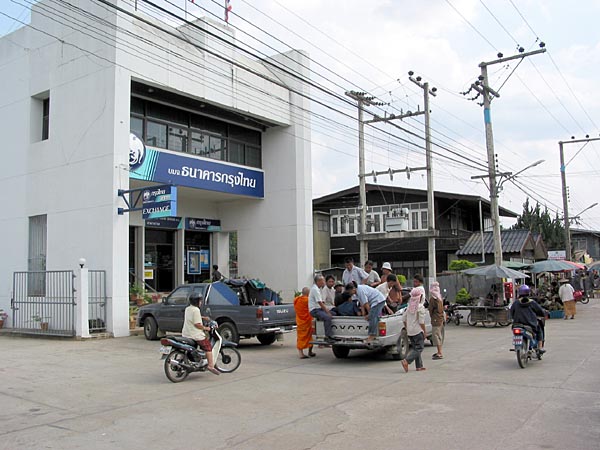
Pai's one bank...In 2003!
However, the great steamroller of progress brought us an ATM in July 2004, a second full Nakhon Luang Branch in December 2005, three more ATMs and a Krung Sri branch in mid-2006, and a second and third Krung Sri branch in late-2006 (are people really so lazy that they can't walk across town?). As of March 2010 I've completely lost count; it seems every week I see a truck bringing in another ATM to crowd Pai's increasingly Khao-San-Road-like downtown. Some banks have more than 4 ATMs around our tiny town.
For the most part, these giant banks were built without any respect for the local beauty, without even the slightest awareness of what makes Pai special and what makes people want to open bank accounts in Pai! Don't they realize that the viability of the loans they give out, and the number of customers who will come pay for their exchange and account services, directly depends on the continuing aesthetic appeal of Pai to tourists?
Bangkok Bank, one of the largest in Thailand, knocked down a beautiful old teakwood house to build a towering concrete fortress whose facade is completely covered with colored fluorescent panel lighting. I can understand the need for concrete for security, but why turn your structure into a gleaming nightmare straight out of downtown Bangkok? Couldn't they use a little teak somewhere?
A beautiful restaurant right next door provides an excellent contrast. Would you rather see more of this? :

Laan Taung Restaurant
Or more of this? :

Bangkok Bank
Pretty obvious choice; why couldn't the banks get it right?
Krung Sri Bank (aka Bank of Ayudhaya) built a lifeless, modern concrete structure for their bank, with 4-meter-wide gleaming yellow fluorescent panels covering every single inch of the bank's facade. In a token gesture to nature, really more of a taunt, they plastered over the large concrete pillars in front of their bank with a bark-like texture and painted them brown:
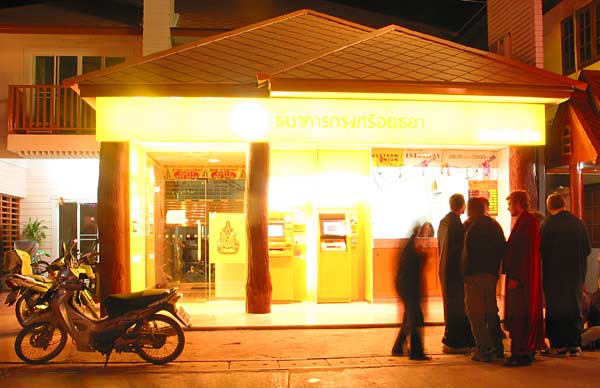
Krung Sri Bank—Ugly
Why?
2007 Update: In late 2007, we got yet another bank on a major corner, knocking down one of the last Shan-style teak houses to build what has got to be one of the ugliest banks in all of Thailand. It is On Sin, and it is a giant pink plastic monstrosity so hideous that it defies photography.
2009 Update: Kasikorn/Kbank/Thai Farmer bank opened up this branch in Pai, in an old teak building where an old lady sold shoes for 20 years until she was pushed out of Pai when her rent went from 7,000B a month to 20,000B a month:
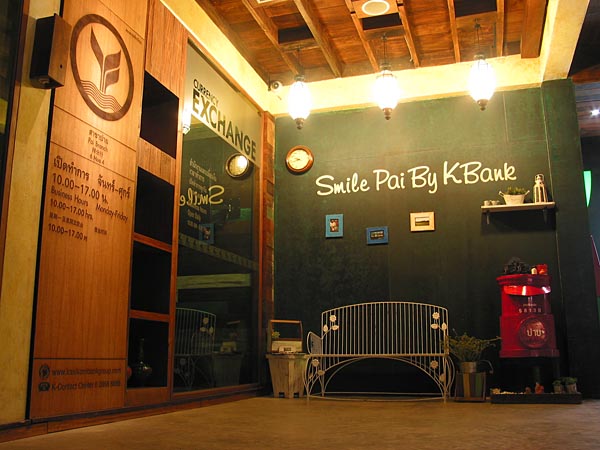
Smile Pai By K-Bank: Huh?
To its credit, this is the first ever bank in Pai to try and blend in with the original wood construction. So someone seems to have had a clue.
And they seem to have gotten an unbelievable amount of press off of it, because now every single Thai tourist feels irresistably compelled to photograph themself in front of the bank.
7-11
Nearly every town in Thailand, down to the smallest rural outpost, has a 7-11. But, until very recently, not Pai. Instead, you will find the "9-7 minimart" (across from #30 on the map above), a private knockoff complete with a slightly altered non-fluorescent copy of 7-11's logo and decor, but with more "laid back" hours that are much more appropriate for Pai. The 9-7's products and their selection is better than 7-11's, and the owner lady also bakes amazing breads. The shop is actually run by 4-5 beautiful pedigree Siamese cats who strut up and down the aisles, eventually roosting on their throne next to the cash register. All in all, it is a pleasant experience to shop there.Contrast this with the 7-11 that Pai got in August of 2004. A blindingly bright, plastic cookie-cutter 7-11 that's just like every other 7-11 in the country. They showed no attempt to blend in with the wooden look of Pai's main street. In fact, they even went out of their way to remove the wooden look, covering up an entire floor of beautiful old teak in the building they occupied with hideous green corrugated plastic:

Ugly 7-11

Ugly 7-11 Facade
To most of the foreigners who live in Pai, along with many Thais, the site of the 7-11 is both disheartening and depressing: it foretells of a coming "watering down" of Pai where Pai will lose all its uniqueness and become yet another butt-ugly Thai town with all concrete shop-apartments:
I don't think that Pai's 7-11 will ever close, but you might as well put your money somewhere where it will stay in the local economy rather than being siphoned off instantly to a giant corporate headquarters in Bangkok, and in turn a worldwide corporate headquarters in Japan.
To most of the Thais who have lived in Pai for generations, the 7-11 is a wonderful sign of "development" and "progress" and "we're a real city now." God, if there were only some way to make the locals understand what kind of utter malaise, dissatisfaction, and regret comes to a town when the chains move in and destroy local businesses! But it's so hard to express that to someone who has been saturated with flashy Bangkok-produced TV images of "modernity" their whole life.
For example, even though 7-11's products are generally inferior, less healthy, and more expensive than things you have been able to buy in other shops in Pai for decades, many Thais are drawn to 7-11 just because they are brainwashed with its chiq. A handful of particularly nasty items, such as "smok-y-bite" mini hot dogs and Western-style Icee smoothies (which are inferior to home-made Thai smoothies in every way: health, quality, taste, and variety), seem to draw hordes of Thai kids. Basically, the local people are too honest and too innocent and they have not yet developed any brain defense against the cynical, deceptive marketing strategies of a modern corporation like 7-11.
One middle-class Thai guy I talked to in 2010 thought how helpful it was that Pai had a 7-11 because it was open 24 hours, and this meant that the extremely poor people who lived in Pai had somewhere to go to buy food after earning their tiny wages from a full night of work in restaurants, bars, or guesthouses. I didn't have the heart to mention that those poor people are literally poisoning themselves in the process, and why can't they use their earnings from each night to buy better, cheaper food less than 24 hours later?
2006 Update: As if this wasn't enough, in December 2006, Pai got another 7-11 attached to a gas station at the edge of town. Sigh.
2009 Update: Adding insult to injury, Pai now has a third 7-11 just around the corner from the first one, literally a 20 second walk away.
2015 Update: Pai now has a total of five 7-11s. Outrageous for a town that has three streets.
2017 Update: The attack continues with a sixth 7-11 under construction.
2018-2019 Update: Now we have eight 7-11s, and Pai is even less blessed two have two new "Mini Lotus-Tesco" shops, the precursor to the same-named big box stores that utterly decimate local retail business.
Morning Market
At least for the moment, Pai is free from tuk tuks, auto taxis, KFC, Burger King, Lotus/Tesco/Carrefour superstores (though as of 2018 we have two Lotus-Tesco minimarts), and Swensen's Ice Cream. However there were rumors that the morning market in the center of town, a nice, old teak structure which closed late 2004 and sold to a private owner for an outrageous sum, would become a mini Lotus Tesco. That is somewhat unlikely, but if it were to happen, it would decimate all of the minimarts and also some of the prepared-food stalls in town. Hundreds of people who are directly responsible for Pai having the eclectic character it does would lose their jobs and livelihoods instantly, and probably be forced to move out of town.In 2006, they put up signs saying they were going to convert the former morning market space into a huge 2-story strip mall with condominiums in the back, complete with floor plans and a little cardboard mockup with little plastic trees. There were persistent rumors that Starbucks or McDonald's had rented the marquis slot in front. Fortunately, it appears that they failed to find enough takers and the space has again been boarded up with no indication as to its future.
In 2009, the rich owner knocked down the structure (presumably selling off the teak) and replaced it with a circus of ugly, clinical pipe-and-plastic canopies with drooping electrical wires, propped up on a wide airstrip of concrete:
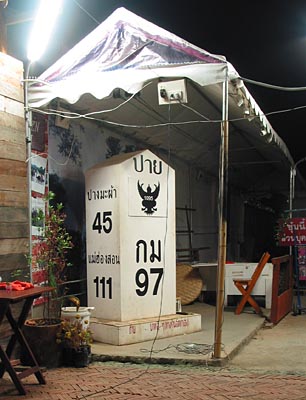
Mourning the Market
The owner is charging vendors such a King's Ransom to use the space (one vendor reportedly had to pay 7,000B per month for a 2 meter by 2 meter space, though the rents were apparently down to 3,000B per month by March 2009) that the entire compound has remained almost completely empty for the entire high season. A nice Pai-local lady who had been selling pork-on-a-stick from a rolling cart in front of (not on) the rich developer's property since at least 2003 got embroiled in a battle when the developer demanded that she pay him tribute—I mean rent—that exceeded what she made on pork in a whole month. This battle went all the way to the district mayor who, of course, after due deliberation, decided in the rich developer's favor. Now the lady has been pushed around the corner away from the populated area and is struggling to make ends meet.
The structure remained at less than half capacity until around June 2011, when it was again razed. It's not clear what will be installed next. As of May 2015 it is now a gated off, ugly concrete airfield eyesore with a "for sale" sign. As of 2017, no changes. Huh?
Top Charoen
Around November of 2005, the Thai optical mega-chain Top Charoen opened a franchise in Pai, right on the main bank/market street. Like 7-11, they displayed their corporate arrogance and lack of consideration by following their exact corporate-cookie-cutter store design, complete with a blinding fluorescent- and halogen-lit display, a huge, ugly lighted fluorescent sign, and not even one square inch of natural wood or, for that matter, any plant matter.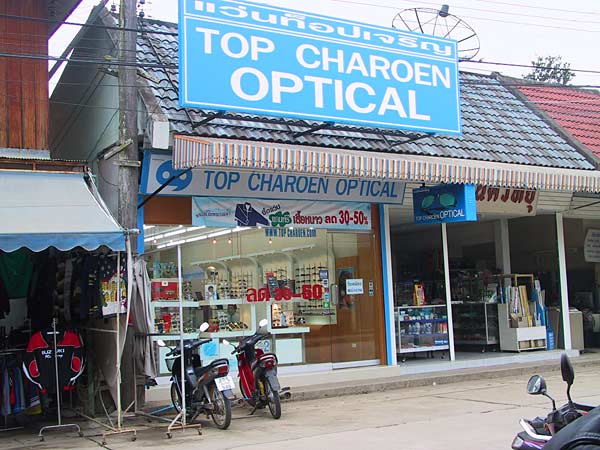
Top Charoen—Enough Already
As we watched the store being built, we noticed that every surface, every curve, and every corner of its modern look is just a veneer—painted micro-thin plywood sheets stapled to a rickety frame. The shop sticks out like some fat, hairy-bellied porpoise of a man who's just tried to run up on stage and join a kickline of beautiful lady dancers, flinging his flabby limbs about in an attempt to freeload off of their well-deserved fame, but in the process making the whole production into something crass, commercial, and valueless.
As my friends and I often drink goat milk chai across the street from Top Charoen in the afternoon, we are happy and able to report that the shop receives almost no business whatsoever. All the sunglasses and eyeglasses on display in the blaringly bright window cost 2000-5000 baht, which is an outrageous price for the locals who, unlike their bigger-city compatriots, have not yet all been brainwashed into thinking they need to sell their youngest daughters in order to purchase fashionable eyewear. Every day, the lonely, unlucky employee stands at the crystal-clear glass door, longing for hours in his sparkling white dress shirt and corporate-logo-matching electric blue tie that someone—anyone—will drop by to look.
The thing is, I imagine Top Charoen knows their Pai franchise will lose money for years, but that they will be the first to profit when Pai has finally "developed" into the sort of high-priced, fake movie-set, checklist-item rich-tourist destination that they are hoping it will become. For now, if you need eyeglasses or sunglasses, I recommend the older optical shop near Wat Luang instead. At least there's a possibility that some of your money might go to Pai (or even Northern Thai) people instead of a Bangkok mega-chain. July 2006 Update: still no customers. January 2007 Update: still no customers. January 2008 Update: still no customers. February 2009 Update: still no customers. March 2010 Update: Pai did indeed become the checklist-item destination they were hoping for, but still no customers. June 2011 Update: still no customers. February 2012: when do the profits start? May 2015: same old same old. September 2017: Despite opening a second shop in a nearby market, same empty place. February 2019: still empty.
Market Saturation? What's Market Saturation?
In January 2005, a group of local expats and Thais did a very thorough survey of businesses in Pai and found an astonishing 77 guesthouses and 41 restaurants. This survey included only the businesses which happened to be open on the day our surveyor visited, so the actual number was even more than that.As of June 2007, it is plainly obvious that there were now even more guesthouses and restaurants than there were back in 2005. The businesses spread out of downtown Pai like some kind of fungus, eating up beautiful rice fields and beautiful old teak Shan-style houses and leaving only concrete and hideous Chinese-style shophouses in their path.
From talking to many guesthouse owners, it is clear that most of these places do not fill up, even in the high season, so one has to wonder whether or not the owners understand the concept of market saturation. Some businesses here are owned by bored, rich Thais who don't actually seem to need (or particularly want?) customers, but the net effect is to dilute the market for all businesses and I wonder how anybody can make a profit.
The spread of guesthouses well beyond market saturation continued until May 2015, when it finally seems to be slowing down a little bit, probably because everyone can see all the bankrupt businesses with "FOR IMMEDIATE SALE" signs in front of them.
The New Town
Somebody clearly wants to "develop" Pai pretty badly. Next to town they have bulldozed a huge area, about half the size of the current town, and as of 2005 they were selling it off as commercial/residential space at real estate prices about double those of 2004, billing it as the "new town." It will be interesting to find out who owns the land now and ends up profiting big by this "development."As of 2006, they have begin paving a complete series of roads and intersections in this area, even though there are only 1 or 2 businesses who have built on it!
As of June 2007, there are a few more businesses, and even a few residences, and they are starting to erect large, extremely ugly Chinese-style concrete shophouses in another corner of the "new town."
Adding to the excitement is that nearly all the development in the "new town" is being done in an area which was completely inundated by the Pai floods of 2005. And it's not like this fact isn't obvious either: the whole area is covered with a fine sand that comes from the flood waters of the Huay Meuang Gawn stream (which is only about 20 meters away). Right across the river from all the new buildings (also about 20 meters away from the stream!) we still see the sagging remains of 5-6 concrete bungalows which were yanked off their foundation and tossed into the mud during the flood.
What kind of blinders do you have to put on to build your house, or your business, in this location?
March 2010 Update: There are a handful more houses in this area, and 4-5 more huge, amazingly ugly Chinese-style shophouses sitting completely empty in the area around the Wednesday Market. Doesn't seem like the New Town is happening, which is probably for the best.
It is amazing to me that any one person would intentionally, and of sole will, create a town and environment that is guaranteed to be so ugly, so hot (the large structures block the wind), and so destructive to everything that made Pai unique, both aesthetically and in terms of having small, property-owning business people. I figured that most of the time that kind of urban decay happens incrementally, with individual small shopowners making selfish and short-sighted decisions, but in this case it is a concerted and organized effort to turn Pai into the noisy, dusty, hot, loud, and unpleasant sprawl that constitutes most small towns of Thailand.
February 2012 Update: more of the theoretical roads are now paved, and about 6 more carbon-copy ugly long chinese-style shophouses have sprung up in this area, mostly empty, looking like a row of plastic Hotels on a Monopoly playing board. Why would anyone do this do their own town?
May 2015 update: there has been a massive uptick in construction of two-and three-story ugly, wind-blocking Chinese-style shophouses in this area. It is a truly sad sight to witness every time I pass by there. Only about a third of the units are rented and the businesses in there seem to be suffering. However one can presume that at a certain point, the rich developer will figure out a way to unfairly tip the economics in his favor (perhaps by bribing someone to move the bus station out to his inconveniently far edge of town) and the whole town will eventually be forced by these unfair economics to move over to this absolutely uninspired cookie-cutter area, killing what's left of the old town and guaranteeing that Pai comes to look like every other town in Thailand. The utter lack of humanity involved in making such business decisions is staggering.
The only glimmer of hope, and this is not ideal either, is that in a small corner of the New Town a group of trendy new Chiang Mai-/Bangkok-style high-end Western restaurants and boutique coffee shops has sprung up, giving at least a little color to an otherwise lifeless and soulless landscape.
September 2017 update: The construction of hideous and identical Chinese-style two-story row shophouses continues unabated, blocking out the sun and any possibility of a mountain view, and keeping in the heat and noise. A beautiful old 20-meter-tall bamboo structure housing a delicious and relaxing restaurant, run by a local Thai family for decades, was razed to build yet another identical shophouse. The restaurant owners have moved into one of those shophouses. Their new space is a noisy, echoey, fluourescent-blazed, unpleasant nightmare. Overall, occupancy in the New Town is still extremely low. I only see about 40 business out of hundreds of mostly empty slots. Those people I know who rented those spaces say that everything about the building construction is as cheap and shoddy as possible, with broken pipes, uneven floors, and every problem you can imagine.
The tycoon has also built his own large outdoor covered market, a larger clone of the Seng Tong market structure, and tried to lure vendors from Pai's already-totally-sufficient number of markets in the real town into the New Town—another crass, cynical act intended to accelerate the destruction of the real, beautiful Pai and eventually force all businesses to become his tenants in the cookie-cutter hideous existence of the New Town.
It's one thing when a town gentrifies or becomes spoiled because of a preponderance of thousands of tiny decisions made independently by different people for different reasons. That is a sad thing, since in the end everyone is disappointed, but one cannot say the result was anyone's intent. It's quite another thing if you are someone with an utterly disproportionate amount of resources and you purposely, intentionally commit those resources towards to the specific goal of destroying the very thing that makes Pai a unique place in the world—something plainly obvious to anyone who has been in Pai more than a few years, including the tycoon. What kind of person would do that?
Paimanheimin
As of September 2017, the part of the "New Town" with the trendy, high-end shops has expanded somewhat. There is now a modern-art abstract clock tower that chimes with annoying, digitially synthesized amplified noise, a curved sculptured grass patch, restaurants serving farang food that costs 10 times what a normal Thai meal costs, and an enormous spa building with modern, glass-walled live-work spaces in the back.The area has come to be known as Paimanheimin, a reference to the ultra-trendy Nimmanheimin road in Chiang Mai, which consists of endless street after street of grossly overpriced trendy mango and perl tea shops, rich, spoiled Thai girls taking selfies of themselves, and an army of plastic surgery clinics, skin whitening clinics, and aesthetic dental clinics ready to serve them.
Shiny Plastic
During 2003-2006, Pai was just taking its first steps towards becoming a standard ugly Thai city. In addition to the ugly, blinding plastic ATMs and banks mentioned above, another business in July 2004 installed an ugly "Money Exchange" sign straight out of Khao San road in Bangkok, and the muslims recently knocked down a nice wood building and put up a row of ugly concrete shops with plastic signs. It's sad that the locals (or at least the Bangkok Thais who own businesses in Pai!) do not realize or care that they are taking away the one unique thing that Pai has which attracts so many tourists. Many Thais see the concrete as a sign of progress, but the net effect will be fewer tourists for sure: why go to Pai when you can get the same experience in ugly "resort" towns just outside of Chiang Mai?Small positive update: around August 2005, the business with the butt-ugly, lighted money exchange sign replaced it with a nice teak sign.
March 2010 Update: By this point the modern, lit, multicolor neon signs have completely taken over. There is very little visual difference between downtown Pai and the Khao San Road of, say, 2000.
Pai Airport
Perhaps the clearest indicator of the true massiveness of the Pai metropolis up until 2004 was Pai Airport, right on the edge of town (just past #33 on the map above):
Pai Airport in 2004
Here's a November 2003 aerial shot of the same space-age facility, stolen from the Thai Flying Club:
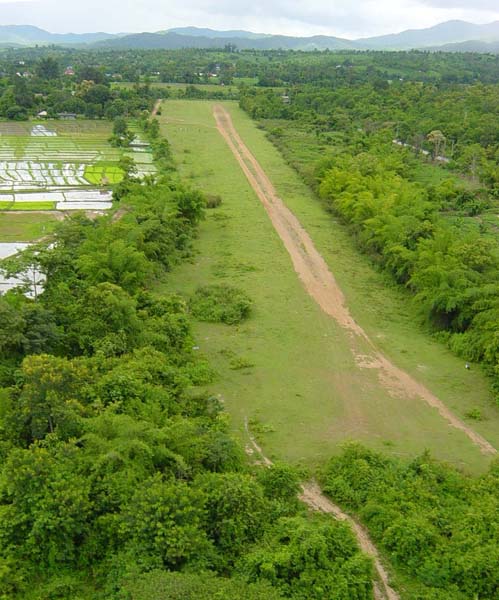
Pai Airport in 2003
In February 2005, everything started to change. Bulldozers came and widened, lengthened, and paved the runway. By July 2006, the whole facility was surrounded in a barbed wire fence (presumably to keep out the grazing cows):
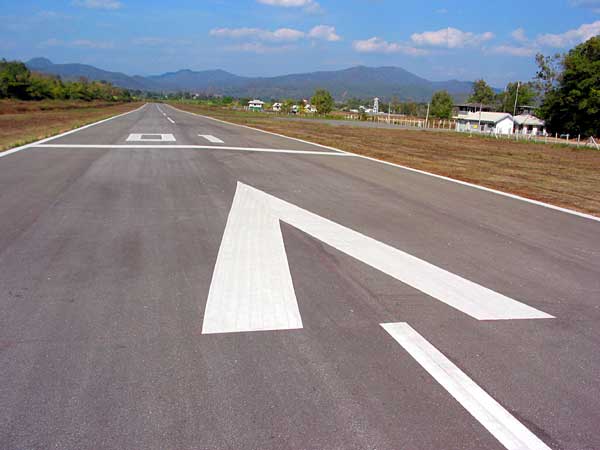
Pai Airport in 2007

Pai Airport in 2007
Rumors circulated ever more widely and wildly that Pai was just about to be invaded by a swarm of new airplanes from Chiang Mai, and perhaps even Bangkok. However, for a full year, we saw no regular airplanes. I knew only a few people who had ever seen an airplane anywhere on the runway, though every few weeks I could hear a small plane land or take off. For sure, every day, you could see farangs on the runway practicing riding their newly rented motorbikes, speed-crazed local teenagers drag racing, and fitness-crazed locals going for their daily jog. All this despite the oddly-scribbled Thai-language sign on the gate, which reads "outsiders please refrain from coming in to exercise."
But then, all that changed.
The small Thai carrier Nok Mini, also known as Siam General Aviation (SGA), began offering daily, 1500B one way, 14-seater, 20 minute flights from Chiang Mai to Pai and back again. Originally scheduled to start on 15 January 2007, as seen in this Pai Post article, the flights did not really begin until 1 Feb 2007 when there was one flight a day. Before December 2007, they went to two (weekday) or three (weekend) daily flights, so airplanes someetimes buzzed over my house four to six times a day. For the 2007-8 high season, they introduced a schedule with up to five flights per day on weekends. Insanity!
The airport counter in Pai (and Chiang Mai) suggested that tickets are also available through Nok Airlines:
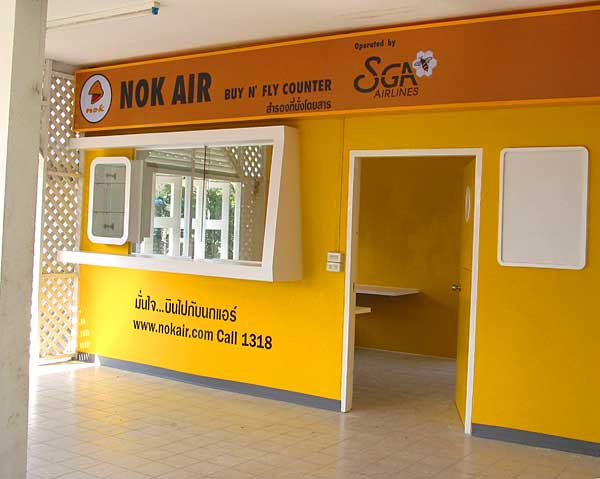
Pai Airport in 2007
Around March 2011, SGA decided that the route was no longer profitable, and stopped offering service.
2011 Update: As of June 2011, a new small carrier Kan Airlines is offering daily service between Pai and Chiang Mai. For more info, see the transport page.
I personally believe that the debut of regular flights will have a chilling and irrevocable effect that will transform the face of Pai more rapidly than we have ever seen, as I explain below. For all our sakes, I hope I am wrong.
Interestingly, during the long wait for actual airplane service, Belle Villa, the posh "have to have been there" place that markets so heavily to Bangkok Thais to come live in mediocre wooden houses way outside of town for 4000B/night ($100/night—outrageous) has now built another site called Bulunburi—right at the end of the runway. Brilliant.
2017 Update: Kan airlines experienced, er, airplane troubles and shut down in April 2107. Now a new airline Wisdom Airways claims they will start Pai-Chiang Mai services in December 2017, in addition to an ambitious plan to offer Bangkok-Pai service on the notorious 20-passenger de Havilland Canada DHC-6 Twin Otter, a plane that specializes in takeoffs and landings on extremely short runways. Wisdom Airways denies being the same airline as Kan even though at least ten pilots are the same.
2018-2019 Update: Wisdom did indeed operate for most of the 2018-2019 high season (seemingly one flight a day mostly), with one strange thing being that there was no Wisdom staff or even a Wisdom counter at Pai airport, so you just kind of magically had to know which travel agent in Pai can book tickets (May Travel, at the time of writing).
Special 2008-2012 Update: Pai Is Over

Pai is Over
This t-shirt, designed by a disgruntled Thai resident of Pai in 2009 (appropriating a very old, unrelated peace meme), perfectly captures the pummeling new reality that descended on Pai like a tsunami in December 2008 and returns each year with ever-increasing ferocity:
Run for the hills! The Bangkok Thai Tourists are here!
As smelly, loud, and culturally insensitive as a few hundred farang (non-asian foreign) backpacker tourists can be, it turns out that they are nothing compared with the annoyance level of a few tens of thousands of Bangkok tourists who now all, simultaneously, flood up from Bangkok during the two miniscule vacation periods that are available to most working Thais (the King's birthday around December 5th, and New Year's on December 31st), gridlocking Pai's four streets with their minivans and SUVs, and driving pretty much everyone (Thai and farang) insane with their often inconsiderate, all-night noisemaking, their often rude behavior towards local Thai guesthouse owners, and their mindless, lemming-like proclivity to slavishly follow the itinerary that was programmed into them by the trendy Bangkok magazines, movies and TV shows.
The t-shirt above is so clever and so appropriate because foreigners will read it to mean that Pai is "over and done with; finished," whereas the Thai tourist is most likely to interpret it as "O-WER," a Thai slang expression borrowed from English meaning "Over the top! Really great!" The genius of the design is that it is both at the same time.
Sadly, Pai has become the ultra-trendy hip-chiq must-do check-list item for nearly every Bangkok (and Chiang Mai) Thai, and the situation is only getting worse as more and more such tourists are coming, even (in 2010) through January and into February.
Pai already had a mysterious, exotic "mystique" amongst Bangkok Thais, partially due to exaggerated stories of drugs being everywhere. In 2005-2007, thanks to what seems to have been a concerted marketing effort by upscale Pai businesses and tour agencies around the country, the Bangkok Thais saw Pai appearing in movies, TV shows, and, wouldn't you know it, someone selling them a complete package tour to go "see" Pai. I emphasize "see" as in "spectate," not "participate" or "contribute in any way." Prior to 2007, many travelers (both Thai and farang) grabbed their guitar, their paintbrush, their notebook, their dance routine, their cookbook, or whatever, and headed up to Pai to participate in the scene. Now, there was a relatively cheap way that relatively uncreative upper-middle-class Bangkok Thais and their whole extended family could leave Bangkok to go gawk at the exotic animals in the zoo from an air-conditioned van over a 3-day weekend.
The Thai tourist hordes, and the big money that is crassly milked from them in mass, has re-shaped the face of Pai in a way that further degrades any kind of creative spark it once had and further alienates the kind of person (Thai or farang) who may want to come to Pai to actually contribute something creative.
When the hordes recede, especially on weekdays, most visitors walking around are still farang. But there are fewer farang tourists and overall tourists than you'd see, say, 2–3 years ago. There are fewer farangs of all ages and persuasions, not just fewer young hippie farangs. There are also fewer impromptu musical/artistic events than before, which is too bad, as that was one of the best parts of Pai. Fortunately there are still some events, often inspired by (atypical) Thai visitors and residents who have some creative spark and sense of independence.
At least for now, on non-holiday weekdays, and outside the December-February peak period, things are more calm. But I believe that until the Pai fad fades away, Pai will essentially become uninhabitable on December-January weekends for anyone except for the prototype 3-day Bangkok Thai tourist family for whom Pai is currently being economically optimized.
The Horrific Bangkok Thai Swarm (HBTS)
Farang Hippie Barely Noticed in Thai Tourist Horde.
Stop on Green, Go on Red in Gridlocked Traffic.
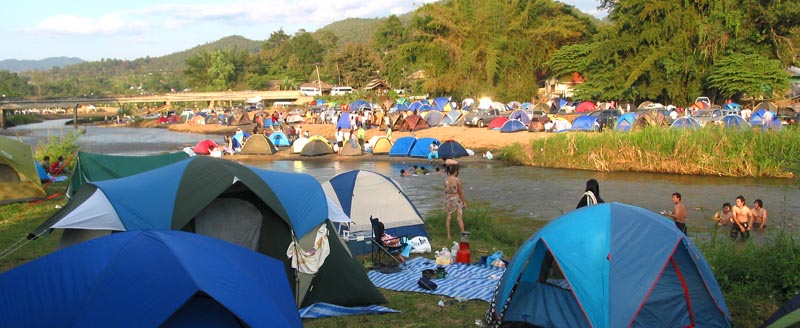
Way Too Many Tents, Way Too Close Together
After a year or two of seismic warnings, the King's Birthday holiday of Dec 2008 and New Year's 2008-9 brought Pai to a never-before-seen extreme: the Horrific Bangkok Thai Swarm (HBTS). Vastly excessive numbers of mostly Bangkok tourists flooded up to Pai, overloading its infrastructure. For example, on the afternoon of 31 Dec 2008, it took me around 1 hour to go about 1/2 kilometer on the "highway" leading into Pai from Mae Hong Son. Large banks of cars sat abandoned by the petrol station since fuel had run out. Our small night market "walking street" was packed shoulder-to-shoulder with camera-toting Thais, worse than I've ever seen the Chiang Mai Night Bazaar or Chiang Mai Sunday Market, and it was unclear how anyone could be having a good time. It was also crowded around this time in 2006 and 2007, but not this crowded.
Around 3 Jan 2009, the HBTS vanished as quickly as it had appeared. Smaller bursts of Bangkok Thai minivans returned on the January weekends, but nothing to compare with the HBTS. The reggae festival on 24 Jan 2009 gave us a little burst of younger tourists, but overall not that many (definitely not as many in town as last year's reggae festival). Makkha Bucha weekend on 9 Feb and Songkran in mid-April were the last Thai tourist bursts of the season.
In 2009-2010, the tsunami wave came in December again, however this time the hordes continued coming, weekend after weekend, through at least the middle of February. This time Pai didn't run out of petrol, and the Pai adminstration got a little better at vehicle traffic control, blocking off more streets to prevent some of the gridlock, but on many weekends it still took ages to cross town, and the "walking street" seemed as crowded as ever.
Some people believe there were fewer overall Thai tourists in the 2009-2010 wave and that the fad is fading. I really hope so, but I'm not sure: the improved traffic control could easily have made crowds look smaller. The 2010-2011 season also seemed to be a bit smaller, lending credence to the happy thought that the fad might be on the way out.
Amidst this tectonic shift from farang to Thai tourists, and amidst the generally decreasing numbers of farang tourists all over Thailand, the farang-oriented restaurants in Pai are suffering, but hanging on. There are a few farang-oriented businesses that closed during the 2009-2010 season, but this was for reasons unrelated to the amount of business they got. Other restaurants have adapted by adding or emphasizing Thai food on their menu.
As of March 2010, some sense of sanity returned to Pai and you could see that some of the artistic/musical types who'd been scared away were slowly returning.
In the 2010-2011 high season, I am happy to report that while there was definitely still a swarm, the numbers seem to finally be slipping down. The fad is still hot but it seems to finally be ebbing. I can only hope this trend continues in future years so that we can tear down all the new Disneyland-style guesthouses and/or use their air-conditioned concrete rooms for rice storage.
In the 2011-2012 high season, there were horrific crowds on maybe 4 or 5 weekends, but outside that the overall numbers definitely seemed lower than the previous year (despite dubious "statistics" being trumpeted by the district office). However a big reason for this is probably the terrible flooding in Bangkok in the last quarter of 2011, which left many Thais without extra money to travel and which scared foreigners away from Thailand. The number of tents was visibly and vastly lower than previous years too. That could mean fewer tourists, or more tourists who distributed to the many newly built guesthouses in Pai and surrounding towns.
During 2012-2017, the HBTS ebbed as the fad died out, but the Thais were replaced by another even larger crowd—the Chinese!
New Type of Thai Tourist
The vast majority of the HBTS are cookie-cutter lemming tourists who come in giant groups and all cycle through the 3–4 "famous" spots that they saw on TV or in the movies. Their minivans drop them off at the "WWII Japanese Bridge" (which, it turns out, is neither from World War II nor of Japanese construction), at "Coffee in Love," and then downtown at Pai's designated "walking street" area where they utterly pack the street and certain venues they saw on TV, but completely skip several nearby, superior venues because those venues are not "in the program." These tourists seem to have no opportunity, and perhaps no desire, to try something new. Their limited vacation time is packed with a pre-planned "program" that allows little time for independent exploration. Their entire focus is on going somewhere as a large group and having some pre-planned experience in that group. They spend so much time and effort considering the needs of others in their large traveling party ("greng jai") that there is simply no opportunity to strike out on their own and do something spontaneous (assuming they would even want to). Even the smaller, younger groups of 4–8 Thai tourists who arrive by bus or non-chartered minivan seem to stick to the places they read about in artsy Bangkok magazines.Farang tourists are famous for being slaves to the Lonely Planet, flooding only to to the guesthouses and spots mentioned in their guidebook. But that phenomenon is nothing compared to the HBTS. It's as if the guidebook only contained two restaurants and two spots to visit, and everyone went there.
The Thai tourists focus so much on group activities, in particular taking photographs of each other, that they rarely ever experience anything unique to the place where they are. You could have a 150-year-old White Elephant named Skippy balancing his left-rear leg on the tip of an ancient Shan stupa, but if you put a colorful sign saying "Pai Highway 1095 Coffee Place" in front of it, most of the tourists would be so busy taking pictures of themselves in front of the sign that they would not notice.
These tourists could just as easily have driven to Khao Yai, or Lopburi, or Lumpini Park in Bangkok for that matter, and had the same experience (while saving large amounts of time and petrol). All you would need to do is ship down some Mitthai(TM) Pai postcards, "Bpai-bpaai-maa" (R) T-shirts and Coffee-In-Love(TM) coffee for them to buy.
There are several beautiful drives along paved country roads within 5km of downtown Pai, but those roads remained almost totally empty while the Bangkok swarms clogged the 4 streets / 6 blocks that make up all of Downtown Pai. Wouldn't you expect that at least a few of them would just "go for a ride?" It didn't happen.
Another even more astounding example of this happened on Dec 30th, 2007, when I went down to Tha Pai hot springs around midnight to find every square inch of pavement, grass, and dirt completely covered with tents, SUVs, minivans, and huge Thai groups drinking, yelling, and playing guitar badly. With trepidation, I walked the extra 100 meters to the actual spring itself and was dumbfounded to find not a single person relaxing in the water! I went in the water and stayed there for almost three hours. By the time I left, I had not seen a single person come over and experience the wonderful hot spring waters—the sole thing that makes Pai Hot Springs unique.
Capitalism, Optimized
In some sense, these "factory-farmed" tourists are a businessperson's dream come true: just push the right buttons and money falls out of their pockets, into your hand. You can just keep pushing the button as long as you want and they'll never notice.It's no different than the vast groups spilling out of buses at Fisherman's Wharf or Pier 39 in San Francisco (completely fake places having no remaining connection whatsoever to San Francisco history or culture). It's capitalism, optimized. Too bad the business-minded folks decided to corral the tourists here in Pai rather than somewhere else (it really doesn't matter where you send them; they'll obey just the same).
Several restaurants in Pai started organizing 40–200-person pre-booked group-tour fixed-menu set dinners to feed hungry heads filing through in 10-minivan caravans, like some giant cattle control grid in a factory farm. The Yunnan restaurant in the Chinese Village (Santichon) switched to a fixed-menu format and sold 1,600 pork legs to pre-booked tour groups in a matter of days.
Lots of business here made bundles of cash over the New Year's periods. Capitalism is thriving; it's doing what it's designed to do. They can probably milk this cow for another few years before she goes dry and the tide of gullible, fad-driven Thai tourists turns against Pai and gets led to another field and then another milking barn.
Bad Behavior
If the only problem were the Thai tourist's lack of spontaneity or creativity, then the HBTS would probably be tolerable. But the reason why these Thai tourists drive the local business owners (especially guesthouse owners) and other guests so totally insane relates to another sociological oddity. As most visitors to Thailand will agree, the Thai people display incredible calmness, kindness and consideration when you meet them in their home situation. The average Thai puts the average Ugly American to shame. But some strange trigger goes off in the Thai brain when they group together and go on holiday. Suddenly all their "consideration" circuitry simply deactivates:- I know a lot of Thai guesthouse owners here, and I've never met one who hasn't complained of the tendency of Thai tourists to get out their guitar and their whisky and keep all the other guests awake throughout the night with drunken karaoke recitals, or in the case of younger groups, keep everyone awake with all-night, screaming pillow parties. When the owners get up the courage to confront the problem guests (and this requires a lot of courage in Thai culture), it often works only for a few minutes, then they are back to the same bad behavior. This occurs whether the guests are teeny-boppers or "adults." If anyone else confronts the problem guests, the guests simply say "we just want to have fun," as if that excuses ruining the vacation of all the other guests (Thai and farang). One theory is that perhaps since Thai people spend so much of their everyday life being incredibly considerate and deferential, all that pent-up, wild willfulness simply pours out uncontrollably when they go on vacation and are no longer under the social constraints of their home or workplace.
- Most Thai guesthouse owners have also commented that many Thai tourists treat them with great disrepect, demanding service, pillows, and extra sheets without using any of the polite words that are part of normal Thai speech, as if the tourists feel they are high and mighty and "entitled" to treat the guesthouse staff almost as slaves. The Thai guesthouse owners here have become used to farang backpacker tourists treating them as social equals; this seems to be the reason why many of the guesthouse owners chose to make a business in Pai. It seems to come down to a problem of expectations: the typical farang backpacker doesn't expect much from a budget guesthouse and so the guesthouse owners are happy to hear them say "Excuse me, would it be possible to get another blanket?," whereas the new wave of Thai tourists treat the guesthouse more like a high-end hotel and will just blurt out "Give me more sheets now!"
- Another report I have heard frequently is that many Thai groups leave the rooms in horrible condition, with sheets soiled with food and trash strewn about.
Now, for sure, there are badly-behaved farang tourists in Thailand who are loud and rude, or who litter. But, perhaps in part due to their quantity (typically, the Thai guests will check in 4-8 people to one room compared with farang guests who check in alone), the new wave of Thai tourists in Pai make the farang tourists look like angels, according to many guesthouse owners with whom I have spoken. During the high season, many guesthouse owners here make a concerted effort not to accept Thai group guests if they believe they can fill up their place with more considerate independent travelers (Thai or farang). "Sorry, we're full," they will tell the newly arrived group of 8 Thai tourists, even if the guesthouse owner has rooms available. In fact, these guesthouse owners sometimes do the same with certain age groups/nationalities of farang guests, but the size of the problem demographic is much larger in the Thai case. Other guesthouse owners have addressed this problem by adding a very high fee for extra people in a room beyond 1 or 2.
We can be thankful for one thing: if we take it for granted that Pai will be invaded by large Bangkok Thai hordes, thank goodness they do travel and stay in groups, often piling in 7–8 people into a room or tent meant for two. And thank goodness they do come up in minivans rather than everyone in a private car. I can't even imagine what it would be like if lemming California tourists could drive to Pai, one person per vehicle! I'd still rather have a smaller number of independent tourists of course, but if we have to have a horde, good thing they like staying op un and close together.
Pai Adapts
Pai businessfolk reacted to the sudden influx of Bangkok Thai tourists by adapting Pai itself to fit the preconceived model that the Bangkok Thais came with.Many houses and modest, cheap restaurants in beautiful old teak buildings were knocked down and replaced with modern-art concrete-and-day-glo foo-foo-shops that you might see in chiq Bangkok shopping malls.
Accommodation also adapted: it used to be easy to find 80-baht bamboo huts, and some even cheaper dorm rooms. Now, many (not all) of those huts have been razed in favor of 300–4000-baht wood or concrete bungalows, and those bamboo huts that remain went for 300–400 baht during the peak New Year's time. Many of the beautiful fields and vistas used to promote Pai have been torn up and replaced with seas of concrete guesthouse rooms.
Some of this construction predated the Bangkok Thai invasion. Some was already in progress as part of the general tourist-ificaton of Pai, as other parts of this page explains, and some started after the big flood in 2005). But most of it started after people saw how many Thai groups showed up in 2007–2008.
One simple way to recognize the changing demographic from farang tourists to Thai tourists is by looking at the names the guesthouse owners choose for the hundreds of new guesthouses springing up. Before, we saw names like "Viewpoint," "Yawning Fields," "Star," and "Riverside." Nowadays, Thai words are the norm, and nearly all guesthouse names consist of different combinations of the same Thai and Northern Thai words for "view," "Pai," "hill," "village," and especially "fog" (which is an exotic pull for the Thai tourists). One place literally translates as "Village Hill Hill View Pai Resort:" I guess they wanted to cover all their bases, some more than once.
These two guesthouses demonstrate that trend even more clearly: it's obvious that they never ran their name past any farangs, and it seems unlikely that they will be seeing any farang guests either:
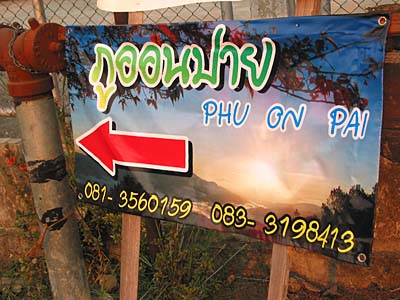
Phu on Pai Guesthouse

Odour Pai Guesthouse
Hmm, something smells...
Throwing the Baby Out
This shift in accommodation had the effect of pricing out a lot of the lowest-budget, long-term travellers (both Thai and farang). This is a shame because, in my experience, these longer-term, lower-budget folks tend to be the most fun and contribute the most to making Pai an interesting place, artistically, musically, and otherwise. This, of course, defeated the whole purpose for which the Bangkok Thais were coming up to Pai in the first place: by the time they arrived, there were few exotic species left to see.It's no small irony that many of the most fun features of high-end Pai accommodation, such as the open-roofed, flora-filled "jungle bathrooms" touted by the luxury establishments, came from these early artistic hippie types who settled in Pai and started small, low-budget bamboo guesthouse businesses.
What Is It With the Tents?
In the last few years, there has also been an explosion of tents for rent during the high season.
Way Too Many Tents, Way Too Close Together
I'm not sure if this is because a.) there's not enough rooms, b.) it's just another hare-brained Thai business gimmick, or more likely c.) the new swarm of visting Thais had a (completely false) preconception that the exotic tourists who were here before liked to sleep in tents. Anyway, some opportunistic landowners were renting tents for upwards of 400–500 baht to desperate midnight arrivals during the 2008-2009 New Year Deluge!
From Rustic Craft to Plastic Crap
In 2003, only about 60% of the buildings downtown were businesses, and most of those were small restaurants or guesthouses occupying the original teak structure. There was no nightly "walking street" and the much smaller set of street vendors were either locals selling food, the odd hippie selling leather goods, or hill tribe people selling their own handicrafts.By 2010, with rents skyrocketing far above what any local family can afford, nearly every downtown property has become a business. We are seeing less new construction using natural, local materials and more cookie-cutter fluorescent-plastic chains such as 7-11, and modern concrete designs straight from Bangkok or Berlin. There are several high-end concrete hotels with modern atriums, where rooms are 4000B+ in the high season. Most of the storefronts now sell fashion clothing, pre-made Pai trinkets and t-shirts, and of course tens of thousands of nearly identical postcards.
The "walking street" now consists almost entirely of crass, outsider capitalists: non-Pai-locals selling non-locally-made, sometimes generic, sometimes Pai-stamped tourist-trap goods which they picked simply because they knew that those items make profit at other tourist traps in Thailand. Do we really need inflatable plastic phalluses from China?

Plastic trinkets and Kilometer Markers
In this economy, creativity is punished and conformity is rewarded, and this is a 180 degree shift from the Pai of just a few years ago. Only the designs that match up with the nationwide branding of Pai (appearing in movies, magazines, etc.) will sell.
I've spoken with many vendors who are frustrated that the really cool designs they spent days or weeks coming up with don't sell because they don't meet the cookie-cutter tourist's expectation of what a Pai trinket has to be:
- It must have Pai written on it
- It must have at least one of these:
- Heart symbols and "In Love" (see below)
- A postbox (as seen in the Pai movies that showed in Bangkok)
- Highway 1095 street sign, with a reference to 762 curves or vomiting
- A kilometer marker with "Pai 0" or "Pai 1095"
- Red/Orange Pai Local Bus
- VW Bug or Microbus (not sure where this comes from)
- Vespa Motorbike (ditto)
- The phrase "bpai bpaai maa" ("I've been to Pai")

Same Old
Some disgruntled Pai residents came up with this postcard, which they wished they could give to the tourists instead of the standard designs:

Wishful Thinking
As it is in both languages, this postcard is useful for sending a message whether one is disgruntled with farang tourists, Thai tourists, or both.
Most of the t-shirts and trinkets are made in factories in Chiang Mai, Bangkok, or China, but in a few rare cases the demand gave rise to local cottage industries. Some old geezers in nearby Vieng Neua, who don't even speak the central Bangkok Thai dialect and have never been outside of Pai, now spend their entire day picking up scrap wood off the ground and cutting it into thousands of little kilometer markers, which they paint white and emblazon with the requisite "Pai 1095" for sale to the Thai tourists in the market. They are rightly confused: "Why do these people want to buy kilometer markers?" they ask, "There's one every kilometer!"
Money "In Love"
There have been several movies shot in Pai, but in the 2009-2010 season, a sickening new chick flick called Pai in Love came out that featured Pai as its centerpiece as part of a cynical branding and merchandising campaign.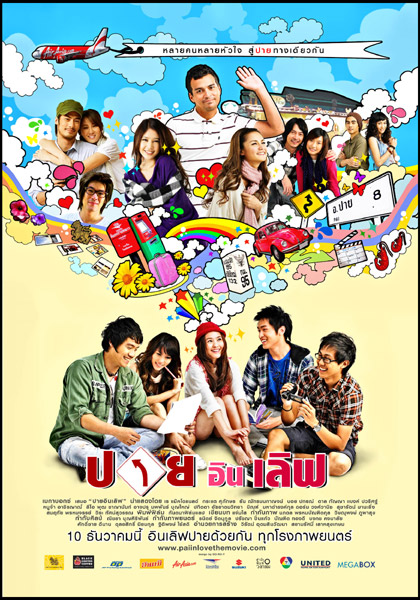
Pai In Love
Suddenly everything in the whole town was "in love." The restaurant "Coffee In Love" seemed to be at the epicenter; the place had already done enough marketing in Bangkok to obtain a monopoly on the tourists: every single Thai tourist absolutely had to stop there in their minivan (there were always at least 10-20 parked outside), drink the terrible coffee, and take their picture in front of the big sign. In 2010, Coffee in Love built a huge, walled outdoor space which played host to giant rock concerts of a scale never before seen in Pai. One was sponsored by the Chang Beer Corporation and was, of course, called "Chang in Love." The 500/800/1200B ticket prices pretty much guaranteed that nobody who was actually born in Pai (and none of the people who were kept awake night after night by the pounding generator-powered speakers that blasted out the whole valley, while everyone else suffered under Pai's frequent power failures) could possibly attend the concert, even if they wanted to.
Everything in town was "in love" too. The t-shirt vendors, who used to be few but who now make up the vast majority of vendors that you see in town, sprayed "love" all over their wares in order to increase the sales value. The little wooden kilometer markers, post boxes, and other plastic trinkets also felt the "love." In an attempt to expand their economic bonanza beyond December/January, business owners in Pai seriously hyped up Valentine's Day, holding mass weddings at the Japanese Bridge and Coffee in Love in 2009 and 2010 that broadcast back in Bangkok. Even the Pai post office got into the act: it still sells love Pai t-shirts to this day.
Pai-sturbation
The Bangkok Tourists' penchant for the sacred symbols of postboxes, buses, kilometer markers, "1095," "762," "Love Pai," etc. is not just limited to postcards and trinkets. They also feel an irresistable compulsion to photograph themselves in front of a postbox and/or kilometer marker, just like the movie stars they saw in the Bangkok magazines.There's a new bank in town which caters directly to this compulsion. To their credit, the bank used a large amount of teak and other wood in their external design—a first for Pai. But they were also sure to include a Disneyland-like photo opportunity spot, complete with a postbox, and (as I sat across the street drinking chai for hundreds of days out of the year) I could see that basically every Thai tourist passing by could not possibly walk any further unless they photographed each other there:

Smile Pai By K-Bank: Huh?
It's as if the tourists have become obsessed with these symbols and have just come to Pai to get a hold of, and perform rituals with, the symbols, not to actually see Pai.
It's almost like a form of masturbaton (Pai-sturbation?) where the tourists are compelled to rub themselves up against the symbols in order to satisfy some irresistable lust for self-validation.
The sad part is, for many of them, I believe their trip is ultimately an unfulfilling experience...
A Big Disappointment
Many Thais I spoke with on a 2009 trip to Bangkok were disappointed by Pai: not only did they find the accommodation and market wares similar to other tourist traps they had visited in Thailand, and the streets and highways congested even by Bangkok standards, but they didn't see anything edgy or exotic. Mai mii arai, you'd hear: "there's nothing here."They were also expecting to find some breathtaking scenery, waterfall, or canyon that's easy to photograph and then leave. Pai has some OK scenery, but that was never its main attraction. The laid-back atmosphere, odd people, and creative stuff going on are what kept people around for weeks, months, or years. But the Thai tourists have no time on their busy "program" to be laid-back, and the odd, creative people are so outnumbered on the big weekends as to be nearly invisible. It's no surprise they were disappointed.
Strangely though, the disappointment did not immediately translate into bad reviews and an end to the Pai fad. Apparently it takes at least a few years for folks who have gone to Pai (who were themselves following a fad and seeking validation in the act) to publically admit to their friends that it's not Pairadise after all.
Whose Market?
The hill tribe folks are still selling their goods in the night market, fortunately, but with the new "walking street" came new forms of taxation and immigration enforcement (and graft) that pushed some of the hill tribe vendors out into dark alleys where few tourists venture.In 2009-2010, the local government tried to reign in the takeover of Pai by non-local vendors by allocating a chunk of pavement in front of the district office that could only be used by local vendors, also playing host to presentations of local culture, dancing, videos of Pai events like the floods of 2005, etc. Unfortunately, the definition of "local" seemed to stretch to the breaking point, and also the area was outside the boundaries of the standard "program" assigned to the tourists by their package tour guides, so it never really took off.
The centrally located morning market, an old teak structure that was the public hub of town life for decades, got sold to a major, non-Pai-native guesthouse developer who (after a series of false starts threatening to build a strip mall with a Starbuck's or a Mini Lotus Tesco) knocked it down in 2009 and replaced it with a circus of ugly, clinical pipe-and-plastic canopies on a lake of concrete. In stark contrast to the neighborly, friendly business climate that Pai had before (particuarly in earlier years when most of the business owners had grown up with each other), the new owner viciously defended his turf with a dog-eat-dog business mentality, creating major problems for some nearby established vendors as explained in this section.
Tattoos Live On
Interestingly, the only business type from the Pai of 2003 that is still thriving is tattoo parlors: there are even more of these than before, and they tend to be some of the largest and most ostentatious structures too. This is probably explained by the fact that many (mostly foreign) customers spend hundreds or even thousands of dollars on one tattoo.Conclusion
Some people say that Pai's gentrification is good because it gets out the "riff-raff." But most of those people probably don't live in Pai. Overall, I would say that the inflated cost of living and increasingly dubious conduct of the police in Pai has filtered out most of the creative people who made Pai popular and interesting in the first place, and has had little effect on any actual "riff-raff" (most of whom are addicted to alcohol, not any substance that the police chase after, and most of whom are not hippies). The HBTS has brought great short-term prosperity to certain business owners and officials, and left a lot of tourists disappointed. It will be interesting to see how many years they can pull off this financial miracle.I am wondering what will happen with the vast amount of new guesthouses that were built in response to this fad. A few years from now, will local farmers be renting out aircon bungalows for 50 baht a month to store their rice?
2012-2015 Update: The Chinese Invasion
As if to outdo the Horrific Bangkok Thai Swarm, as the Pai fad started to ebb a tiny bit for domestic tourists starting around 2012-2013, a new demographic arrived.Lost in Thailand
Chiang Mai (and, although not easy to identify, also Pai) was featured in a cheesy, Chinese-made 2012 slapstick comedy blockbuster movie called Lost in Thailand. This was the first Chinese-made film to gross more than one billion RMB and it is the second-highest grossing movie ever in China (second only to Avatar), so tens of millions of Chinese saw it (they sold 30 million tickets within the first 21 days of release).Like Pai in Love, this movie inspired a swarm of new middle-class Chinese tourists to fly down to Thailand with their new iPhones and selfie sticks to visit all the checklist locations.
Chinese Tourists #1
Coupled with the worldwide economic slump and fears by Western tourists of the violent politics and military coup in Thailand, starting in 2012 Chinese became the #1 tourist demographic for all of Thailand. As of 2014, Chinese represented 18% of all tourist arrivals (4.6 million out of 24 million reported by Thailand's dubious Tourism Authority).A 2016 statistic indicates that Chinese tourism represented 26% of all Thai tourism revenue, about the same percentage as all of Europe combined, and almost double the percentage of ASEAN neighbor tourists.
As of 2015 we are seeing a massive shift of signage all over town. As late as 2010 you would see absolutely zero Chinese writing anywhere in town except for in the nearby Yunnan Chinese village and on maybe one or two banks. Now, nearly every non-permanent sign has some Chinese characters scrawled in handwriting and all new permanent signs are getting Chinese too. For the first time, we are even seeing street products and even a few real estate parcels advertised only in Chinese, not in Thai or English. The Chinese is a bizarre mishmash of simplified characters (if the sign was written by mainlanders or Singaporeans) and traditional characaters (if the sign was written by people who studied at the Taiwan-sponsored school in the Yunnan chinese village, or Hong Kong or Taiwan people). The villagers of the nearby Yunnan Chinese village (distant relatives of KMT soldiers who fled China before the communists took over) are finding lots of job opportunities as Chinese interpreters at guesthouses, rental agencies, and other businesses.
Fortunately in Pai we do not get the enormous flag-weilding bus tour groups which many Chinese tourists prefer to join; this is mostly because their huge buses cannot make it up the windy road to Pai!
In some ways, the new Chinese tourists behave just like the previous wave of Thai tourists who came along with the HBTS, zipping over for short trips due to their highly limited time off, and obsessing over 5 minute photo ops in front of Coffee in Love and a small list of other low-quality destinations hyped up on Chinese TV and the Chinese version of Facebook and Twitter, while disregarding the larger beauty of Pai, not ever exploring off the "program" even for a second, and not availing themselves of the music and other artistic opportunities here.
Many Chinese tourists also act in a bossy and disrespectful way to business owners in Pai in just the same way that I saw so many big-city Thai tourists do. It's interesting that this particular bad behavior crosses language and culture barriers. I guess in both cases, they have fought for their social status and want to flaunt it by acting this way towards "the help."
For certain sub-groups of Chinese, especially those from Guangdong and Hong Kong who speak Cantonese, we are seeing an effect nearly identical to what we saw in Pai with the Israeli tourists of years past: in both cases, due to a cultural difference, the average volume of speaking is much louder than what Thai people are used to, the manner of inflection and consonants are much harsher than Thai, and the distance at which one holds oneself from the other person when speaking is much shorter than Thai people like. As a result, Thai people nearly always interpret the emotion of what people of these groups say as angry or confrontational, even when they might just be saying "Where can I find some tasty food?" or "Where is the bathroom?" which doesn't make for smooth first impressions.
Anti-Chinese Backlash
We are seeing a massive backlash against the manners and customs of (mostly mainland) Chinese tourists in Thailand that reflects the same backlash seen world-wide as China's new middle class explodes all over the globe. Everything from spitting, eating loudly, being loud in groups at restaurants, and throwing trash all over the place, letting their kids pee and crap on the streetside, driving (and often crashing) their rental motorbikes on the wrong side of the road, stopping their vehicles in the middle of the road with no regard for anyone behind them, and generally being rude (from a Thai person's perspective).I spent 9 months total in mainland China (mostly Yunnan) in 2011-2013 and I can confirm that all of these behaviors are the norm in much of mainland China, and in many cases they are not only not stigmatized but in fact encouraged: Eating loudly and being loud at restaurants can be seen as a sign of enjoyment of the food that gives honor to the restaurant proprietor. Stopping in the middle of the road is totally normal as everyone does it all the time and the onus is on the other cars to move around the obstructing car, often by entering the lane of oncoming traffic and blocking them too. Most Chinese see nothing wrong with throwing trash all over restaurant floors, sidewalks, etc. and seem to presume that someone else will come and clean it up (which is what actually happens in restaurants and tourist destination sidewalks; I'm not sure about non-tourist towns in China).
Most of the Chinese tourists coming to Thailand have never been anywhere outside mainland China and are not even aware there might be a society with different rules. Yes, as many argue, all tourists have a responsibility to study and respect the culture where they are going, but one must at least acknowledge that the differences a mainland Chinese tourist faces between his/her own culture and Thai culture are much more stark than those faced by, say, an American or UK tourist.
The anti-Chinese backlash is highlighted by a number of extreme and well-publicised examples like videos of Chinese tourists getting angry and throwing hot coffee at airplane flight attendants, a photo of an alleged Chinese tourist taking a dump in the Chiang Mai moat, and the abbot of a famous Chiang Rai temple forbidding Chinese to enter for a day for what he says their big tour groups did to his bathroom. In 2015 Thailand's government plans to issue Chinese-language cultural guides to Chinese tourists at the ports of entry.
The backlash itself has definitely taken on a mob mentality: many of the "sightings" are distant or unclear camera shots that may or may not even be Chinese tourists, and it's questionable whether many of the behaviors (like washing feet in that particular sink at the national park on Phi Phi island) are at all unique to Chinese tourists (a few claim that everyone was washing their feet there because the bathroom is near beach/dirt and lacks floor-level faucets). But nobody ever considers that side, preferring to join in the bullying and blame the latest easy targets. Some in Thailand even suggested there should be segregated toilets for Chinese at tourist attractions!
But walking around Pai for the last few years, you cannot help but to see a striking difference between certain behaviors of the current batch of Chinese tourists compared with the Thais of the HBTS and even the Ugly Americans and Ugly Israelis in the calmer years before the HBTS hit.
For example, certain new behaviors like spitting and littering and dangerous/inconsiderate driving are undeniable in Pai, and in the case of driving the real danger to everyone is also undeniable.
Fear vs. Sanuk
I actually think the aspect of Chinese culture that creates the most friction with Thais here is at a more instinctive level and not specific behaviors like spitting and littering.To explain this will require a brief segue into Chinese vs. Thai culture in general, but then we will swing around and see what this might has to do with the backlash against Chinese tourists.
While my 9 months in mainland China was fascinating, I found China to be opposite of Thailand in one very important respect. Perhaps it is due to the still-recent legacy of the horrific Cultural Revolution, but I found that nearly everyone I meet in China lives with a deep, everday fear of their government, of strangers, and most of all, of simply falling behind in a cruel dog-eat-dog world that they are convinced cares not a whit about them. This basic culture of fear and pessimism drives their everyday decisions in a direction opposite to the average Thai person.
Thais are famous for 'sanuk' (fun) and it is what makes Thailand so attractive for tourists and expats alike. Part of 'sanuk' is to not worry too much about things that might give you a 'headache', like working super hard—to the point of pain—to score as high as possible on a test or beat out your business competitor by a few percent, or making some clever and ethically questionable move that will allow you to beat your competitor but threatens to spoil your good relations with your competitor and introduce conflict with them, or worrying about whether someone else who has come to offer you something may have ulterior motives that you need to be suspicous of. Thai people have faith that their families and even others in their local communities will come to help them if they fall behind and experience some hardship, and they are correspondingly willing to offer earnest and no-strings-attached help to others in their community who are experiencing hardship. This reciprocity of faith is what has allowed Thailand to survive as a society up until today (though now, as foreign influences that do not share the same faith and reciprocity are weaving themselves into the Thai economy—such as Western loan sharks who gave out huge loans to Thais and then expected timely repayment and thus caused the Thailand economic crash of 1997—things are starting to unravel and Thailand must face this ongoing threat by either adapting their culture or refusing the outside influences).
Part of this relaxed approach to risk in Thailand might come from the fact that Thailand is a tropical country, so you won't die if you fail to stockpile food for a harsh snowy winter, but there is something more to it than just the weather.
With the average mainland Chinese person, it seems to be the opposite. The culture of fear is reinforced on a daily basis for Chinese people, as they watch their countrymen and family members regularly get trodden on by mean, abusive sweatshop bosses and landlords with no means of redress of greivances (or even any means to express those greivances without being labeled a troublemaker or counter-revolutionary and possibly jailed), pushed out of business via unfair competition or sweeping government land grabs with little or no compensation, shaken down by corrupt mafia-like police who plague every market from big cities to small towns, and occasionally even disappeared by China's massive "security" apparatus. All of this happens to some extent in Thailand too, but the degree to which it happens is different by orders of magnitude. Thailand never had a Great Leap Forward and a Cultural Revolution, where millions of people starved to death and/or were sent to re-education camps, to make the threat real and existential in people's minds. For Thai people, corrupt bosses, landlords, competitors and police are the exception, not the norm as they are for mainland Chinese. Thais seem to have a basic faith that most people will do good (for some Thais this might come from their belief in karma and that those who do bad will get crushed by the wheel of karma in their next life). Most Chinese seem to have a basic faith that everyone is out to get them and the only thing they can trust is themselves, their own hard work, and maybe their immediate family.
Parents in China desperately try and force their children into as many hours of after-school tutoring as they can afford, not out of a joyous and excited love of education and hope for their kids' future, but rather out of a morbid fear of their kids falling behind and being mowed under by the unstoppable blades of China's economic machine, meaning not only would the kids suffer but the parents would not have anyone to take care of them when they are old. In Thailand there is no such "school ethic" and as a result the levels of academic achievement are much lower than in China, but on the other hand the levels of stress and suicide are also much lower. If you find a case of a high-achieving student in Thailand it is much more likely to be due to a student who really enjoys study, or who is doing it out of an earnest and joyous desire to lift himself (or more likely his parents or family) to a higher economic level. Again, same amount of schoolwork—same actions—but the underlying reason for doing it in the heart is the exact opposite: fear vs. joy.
It makes complete and total sense that an adult in mainland China today who personally experienced starvation and witnessed some of the worst atrocities humans are capable of during the Great Leap Forward and Cultural Revolution would be conditioned at an animal-visceral level to constantly be looking behind their back and constantly fight to raise their status in order to stay "safe." It makes sense that such a deep level of survival conditioning would continue to influence the behavior of a human being at an instinctual level, long after the actual underlying danger was gone, because such extreme fear trumps logic. If you starved me for several decades and then brought me back into a relatively prosperous society, I don't think I could ever resist the instinctive urge to stockpile food for the rest of my life, no matter how much you tried to explain it to me logically. And it makes sense that such a conditioned human being would try to pass on this fear and paranoia to their children and their society as a whole, out of an earnest belief that they are "protecting" everyone from the "danger" they experienced (even though that danger no longer exists to anywhere near the same extent).
The Chinese government's insane Big Brother presence, with video-camera equipped police vehicles everywhere you can see, positive ID required for everything from purchasing train tickets to staying at a guesthouse, not even the slightest pretense of internet privacy or internet freedom, and world-class propaganda on every media channel pushing obviously one-sided news about the infinite successes of the one-party system while preventing even the smallest bit of criticism or even acknowledgement that there might be a dark side to the filtration, only serves to reinforce the fear. Thailand has its own propaganda and limited surveillance but it is an infantile joke compared to that found in China.
While Chinese people have made staggering economic and technological achievements in the last few decades that rightly make them world leaders in logistics and macro-organization, they are stunningly retarded in the area of quality of life and they could learn a lot from the Thais (as could stressed-out Americans in Silicon Valley or Wall Street).
While I met many Chinese people in China who were nice to me, it is clear that even their thinking is deeply shaped by this fear, whether that is because they too were likely to echo irrational party-line points of view from time to time or because they would demonstrate fear-driven decision making processes for everyday problems that crop up. Interestingly, the younger in life they discovered the internet and learned how to break through the Great Firewall of China to see other views in the world, the more likely they were to feel a deep disappointment and hopelessness about the lost potential of their own society.
But most of the Chinese I met, and I think most Chinese who visit Pai, have lived their whole life entirely immersed in this environment of fear, with their exposure to outside culture limited to Game of Thrones, The Big Bang Theory, and a few censored, government-approved Hollywood movies. It would not even occur to them that there might be another way of living, or even that their environment was in any way particularly fearful—it's just "normal" and "everyone" lives that way. It would not even occur to them that there might be a society where you can safely take a break from the rat-race every now and then without falling behind and being steamrollered to death. It would not even occur to them that there's a place where you can let your kid pursue music or art (at a non-concert-pianist, non-national-academy-of-arts level, that is) instead of a career path sanctioned by the economy, and still have a chance of surviving to old age.
It would not even occur to them that there might be a place where the majority of street vendors, restaurant owners, and guesthouse owners were not actually trying to cheat them, because back in their home country, everyday experience indicates that most of them are. They expect as a matter of course that the first price they hear must be 10x the market rate, and every statement put forth in the price negotiation is an outright lie calculated to extract as much cash from the customer as possible, because that is how it is back home. It would not even occur to them that the vendor/owner's prority in life might be to have fun with the guests and make the vendor/owner's own life easy and fun, rather than to maximize profits to avoid falling behind other vendors/owners in a world that is entirely made of cutthroat competition and nothing else. It would not even occur to them that when the motorbike rental place asks if they have ever ridden a bike before, they might be able to truthfully answer "no" and then receive some helpful motorbike safety instruction from the rental place, rather than falsely answer "yes" out of a fear that the rental place would instantly judge them and refuse to rent to them. It would never even occur to them to just trust the chef to deliver their noodle soup or stir-fry to them in the chef's own signature style, possibly letting them discover a new taste they have never experienced before, rather than nitpicking every tiny aspect of the order to guard against what they see as the inevitable consequence that the chef will corner-cut and short-change them by delivering sub-standard food.
It would not even occur to them that they too could embrace this idea of implicit trust to yield a harvest of good feelings and positive results, because their whole life experience has taught them the soil is arid and only a fool would even attempt to plant.
I believe it is this fundamental difference in faith vs. fear that leads to most of the real conflicts between Chinese tourists and Thais. Sure, at first it might be something external like the driving or littering, but with a little bit of trust, people can get past their presuppositions and make a real connection with each other. But the Chinese tourist facing an ambiguous situation in Pai (often involving a language barrier) while interacting with a vendor, guesthouse owner, or restaurant owner is much more likely (than, say, a Thai tourist or a Western tourist) to fall back on their culturally ingrained instinct of fear and distrust and assume the worst intentions on the part of the Thai.
I can understand a little bit of Mandarin and a lot of Thai, and I cannot even count how many times I've witnessed basic interactions between Chinese and Thais go horribly wrong when the Thai vendor says something the Chinese did not understand and the Chinese guessed it was something much more sinister than in reality, assuming the Thai is trying to rip them off when often the opposite is true. As the interaction continues, it devolves into conflict, where neither party ends up getting what they want and where the Thais are left with an ever worse impression of Chinese people. This happens sometimes too with Western tourists, especially when a language barrier is involved, but the degree is much greater with the Chinese tourists.
I don't know how to solve this problem. Maybe it might help if Thais in Pai were more aware of the history of mainland China and the culture of fear that pervades China and so could be more sympathetic and patient when they observe a Chinese person who is filling in ambiguity with the most cynical intepretation.
None of this should be interpreted as finding fault with either the Thais or the Chinese. This is the kind of cross-cultural issue that challenges both group's fundamental assumptions about the "ground rules" of society and the best we can do is try to identify the points of unnecessary conflict and step in with some advice.
My House in Vieng Neuea Village
Search for Quiet
I arrived in Pai on December 21st, 2003 and lived in Pai in the Sky guesthouse while I conducted a seemingly endless search for a long-term rental house. I was looking for a place which is quiet and which also has a phone line so I can connect to the internet. It was fairly hard finding a place with a phone line, but surprisingly it was the "quiet" criterion that really drew out the search.It turns out that the Thais here have a completely, totally different etiquette about what constitutes being a "good neighbor." And it's not just me: this is the unanimous experience which shocks every farang who has sought housing here in Pai, no matter what country they come from. It works like this: If you wake up at 5am, there is absolutely no problem yelling with your housemates at full volume through your paper-thin bamboo walls, playing your stereo, going outside and vomiting or coughing up a lung, anything. Your neighbors will not yell at you. Your neighbors will not even bat an eye or show any sign of anger, if indeed they notice you at all. The Thais here either have the ability to block out any unwanted sound, including horrible broken stereo speakers blaring distorted, unintelligible noise at airplane-engine volume, or they have absolutely no custom that homeowners need to keep quiet in consideration of their neighbors. Either way, it is an aggravating experience for the farang who is used to having at least some leverage with their neighbors as concerns noise.
You would think that in the quiet Pai countryside, everything would be spread out and it wouldn't matter. Not so. The Thais here are sociable types and are afraid of being alone. They would never build a house that is far from family members or other people (some local Thais are actually afraid of such houses, saying they contain bad ghosts or spirits). Therefore it is almost impossible to find any place to live that doesn't have at least two Thai neighbors (the flood plain on which the first incarnation of the Yawning Field was built being a notable exception), and your neighbors always include at least one family member who has convinced the family to buy a stereo and/or karaoke system. In fact, when a family is rich enough to afford such noisemakers, it is a point of pride for them to play them as loud as possible (always, and I mean always turned up to distorted volume levels so that the music itself sounds horrible and the act is purely a show of ego, volume, and power) for the entire village to hear. The other villagers simply look on in wonder, never even considering the possibility that this might be classified as rude and inconsiderate.
To add to this, every village around Pai has an aging system of tree-mounted loudspeakers that look like something out of M*A*S*H. Since many local people cannot or do not want to buy radios or newspapers, this is the way they broadcast the local news. Most mornings around 7am, and most evenings around 6pm, the local village headman plays a little music and then talks to the village for a while, sometimes up to an hour. Because the speakers are so awful, I can't understand a word of it, and I think the locals have a hard time too, but it seems much of the chatter is about the harvest, how the water supply will be divided amongst fields, upcoming festivals, elections, village committee meeting schedules, and who donated how much at the local temple (including a complete list of those who donated 5 baht). In downtown Pai, you get the same public address speakers, plus chanting coming even earlier in the morning from the mosque and several wats, plus yet another soundtrack provided to you at no charge by the local high school.
The House
Finally, on January 26th, 2004, I found this palace:
My rental house in Vieng Neuea (Source: David Giacolone)
It's in a small, mostly Shan (Thai Yai) village called Vieng Neuea about 4km from the Pai city center. The house is at the end of a side street occupied by old school teachers and their ancient parents. The only sounds (other than the aforementioned public address loudspeakers) are tweeting birds, roosters (pretty much continuous throughout the day anywhere in the countryside) and, at first, the pounding sledgehammer of the workman I hired to replace my squat toilet with the sit variety!
The house is an old concrete and wood 1-story 2-bedroom 1-bathroom. The bedrooms and the large living room have creaky but comfortable wood floors. The bathroom has a hot shower via the usual electric water heater attached to the wall next to the shower. The kitchen is just a room with a bunch of tables and a gas stove. I bought some pipe and brought running water and drain into the kitchen so that I could wash my dishes without baring my body to the mosquitos outside. I also paid about $84 to have workmen build and install hinged mosquito screens over 16 of the house's many old wooden windows.
The house has free, electric-pumped well water for washing and cleaning, and a regular drive-by service operates in the village to exchange large and small bottles of drinking water. There is a yard varying between 10 and 20 feet around the house, and being completely clueless about all things garden-related, I just let it grow wild. Every once and a while, my landlords hire someone to clean out the yard so that it doesn't become a snake zoo. Here's a movie of the man they hired for 200B ($5.26) to clean out the yard for 5 hours. The movie shows you the true value of labor in Thailand compared with the price of time-saving machines. Just call him the human weed whacker:
The Human Weed Whacker.
Also, in my "garden" I apparently have bananas, mangos, mint, tomatoes, and lychees. Periodically my Thai friends show up and implore me to pick those fruits which have ripened as if it is the most important thing in their lives. It's amazing how strong the "picking instinct" is in folks here, even Bangkok Thais.
There is a small orchard of banana trees on one side of me, a disused barn on another, an old man on another, and 2 houses with Thai families and 1 farang renting a house across the street. This was a very quiet spot for a while, but unfortunately, one of my neighbors purchased stereo equipment using the money they got selling land to a Bangkok Thai, and they frequently use the stereo to ruin the surrounding neighborhood. My house does not have a view, but the street I am on leads in about 20 meters to a fish pond and a huge rice field:

Path to fields near my house in Vieng Neuea (Source: David Giacolone)
and farm workers pass by on foot and motorbike continuously, looking like a row of pokemons with their full-head ski masks with holes for the eyes (wouldn't want to get tan now—then they'd look unfashionable).
For info on the rent and cost of living in Pai, see this section.
2008 Update
The giant rice fields behind my house, which used to be at the edge of town, have been completely bought out by rich, arrogant condo developers from Chiang Mai who hauled in piles of teakwood to begin what became months and months of bulldozer digging and construction for a new resort. This noise, along with similar noise from a growing number of neighbors around my house, has finally been enough for me and I have moved further out into the boonies!Interestingly, right after I moved out, the rich condo developer was hit by a gigantic military raid, involving giant army trucks and helicopters, where the soldiers swooped right past the illegal teakwood in all of my neighbor's houses and seized the illegal teakwood belonging to the condo developer. Apparently, he did something to cause a local to lose face or failed to pay the protection money that is required when an outsider wants to do construction in a new location. The owners disappeared for a little while and they are back, with new (licensed?) wood, building their resort just like before.
If the full power of the Thai military can't stop condo developers, who can?
The House That Got Away
As a side note, here's a house I was looking at about 8km away from Pai: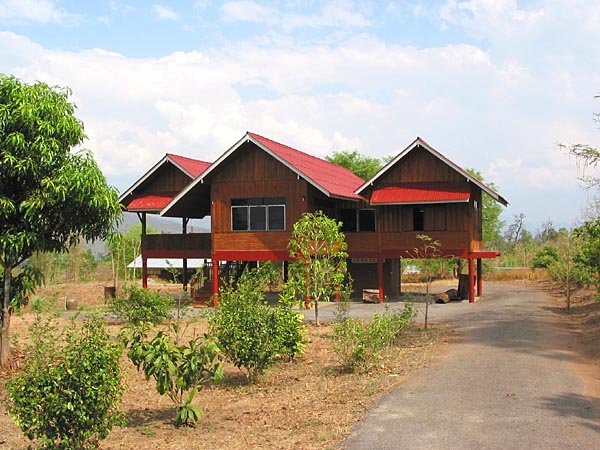
House that got away
This modern house had a stunning view and was located on a 23 rai (9 acre) property with only one neighbor and open fields for hundreds of meters in every direction. It was going for 4000B/month ($100/mo), had well water and public water, and even had a phone line!
Unfortunately, while I was looking to rent the property, some farang bought it for somewhere between 2 million ($52,600) and 5 million ($131,578) baht. This roughly matched the going price of 200,000 baht per rai ($13,300 per acre) at the time, which was up by at least 2x since the year before. Land speculation is wild right now in Pai. All the Thai families who have owned land here for decades are selling out to farangs and rich Bangkok land speculators. Guess the buyers are all counting on that airport to change everything...
Living in Pai
How Much Does It Cost?
If any of you were wondering how much it costs to live in the Thai countryside (prices and exchange rate as of October 2005: 2008 update below),Baht Dollars Item Per Month Per Month 2500B $ 62.50 Rent 2br+1bath+kitchen+living room house+well water 400B $ 10.00 A lot of electricity 600B $ 15.00 unlimited ADSL service 400B $ 10.00 lots of mobile phone calls 400B $ 10.00 Maid to clean house weekly 200B $ 5.00 Service to wash/dry/iron clothes every 2 days 100B $ 2.50 Lots of bottled drinking water 50B $ 1.25 Lots of gas for stove 4650B $126.25 Total
Baht Dollars Per Month Per Month 2500B $ 62.50 Rent 2br+1bath+kitchen+ living room house+well water 400B $ 10.00 A lot of electricity 600B $ 15.00 unlimited ADSL service 400B $ 10.00 lots of mobile phone calls 400B $ 10.00 Maid to clean house weekly 200B $ 5.00 Service to wash/dry/iron clothes every 2 days 100B $ 2.50 Lots of bottled drinking water 50B $ 1.25 Lots of gas for stove 4650B $126.25 TotalPlus about $400-$500 one-time purchase of stuff needed to stock the kitchen, big blankets for the bed, etc., most of which I should be able to sell at perhaps half off when/if I don't want it anymore.
Transportation costs: Baht Dollars Item Per Month Per Month 2500B $62.50 Honda Dream 125cc clutchless motorbike rental 350B $ 8.75 Motorbike fuel 2850B $71.25 Total
Transportation costs: Baht Dollars Per Month Per Month 2500B $62.50 Honda Dream 125cc clutchless motorbike rental 350B $ 8.75 Motorbike fuel 2850B $71.25 TotalThe most expensive way to eat is to drive to town and eat at restaurants every day. That costs about 100B/day ($2.50) or $75/mo.
Or you can buy enough rice for weeks for 170B, and buy fresh-picked vegetables and other cooking ingredients at the market for totals that rarely exceed 40B/day ($1.00/day), not including any farang staples like milk.
My mix of restaurant and home-cooked food costs about $50.00/month.
As a farang I have to pay approximately 1000B ($25.00) per month to renew my visa, and on certain of these occasions I will have to travel to a border with Burma, Cambodia, or Malaysia.
So for me that's about $292.50 a month in total ongoing expenses, plus mad money, money for fun trips around, and the occasional purchase of new housewares or computer supplies. Pretty good compared to the tiny shack I was renting out of someone's garage in the San Francisco area for $1000.00/mo (not to mention any other expenses)!
Almost everything I need I can buy in Pai somewhere. The 3 hour bus ride to the nearest big city, Chiang Mai, where they have every conceivable thing I might need to buy including computer hardware/software and farang-sized clothing, costs 68B ($1.70).
January 2008 Update
Well, thanks to Mr. Bush, you can multiply all the dollar figures above by 1.3 since the Baht has appreciated from 40 to 33 per dollar, and will likely continue to do so.Also, during this time, the rental market prices in my village have shot up about double even though the houses are the same. Prices of food supplies (Thai and farang) have also incresed about 150% in the last few years. I'm not sure exactly what has caused this overall cost of living increase, but nobody will deny it has occurred!
Electrical Power
Power, water, and telephone facilities here are still crude, even as of March 2010. Whenever there's the slightest bit of rain or wind, you will hear the Thais say "dap dap dit dit," referring to the fact that the power, apparently carried all the way from Chiang Mai or Mae Hong Son along fragile poles, goes off and on all day. Sometimes, when there is a rainstorm (only likely in April-November) the power is out for more than 24 hours. It's amazing how quickly and casually the business owners here can switch their operations to candle-power mode in mid sentence as if nothing special is happening. In most places outside the very center of the town, people have sealed wells with electric pumps, so no power means no water too. Outages provide an opportunity for socializing as you fill your buckets and/or shower in the nearest river or irrigation canal. Drinking water is provided by cheap services which drop by cooler jugs and trays of small sealed bottles on a "regular" basis, so fortunately it is not affected that much by power failures.According to a chart at the Pai power station, the months with the worst failure rate are April (with 1,410 minutes of failure in April 2005) and May (with an unbelievable 2,140 minutes of failure in May 2005). In 2006 they installed a trailer-sized diesel backup generator downtown but it only serves the hospital and some street lights.
Here, people take it for granted that whenever you purchase a desktop PC, you must always purchase a UPS too!
As of late 2006 we can see that they are laying newer, much sturdier power poles from Mae Dteng/Mai Malai (the nearest large freeway) all the way up to Pai. So perhaps things will be less fragile in a few years. March 2010 Update: yes, years. They have made lots of progress in four years, but there are still clearly large segments yet to be built, perhaps 10% of the total distance. They have started building the power substation in Pai though, which is a good sign.
As of approximately October 2010, the guy at the local Pai power station (which has been painted pink and light blue and branded with flowers and postboxes just like the trinkety junk shops in town) reports that power is now flowing down the new lines and that the power capacity of the supply to Pai has now increased 5 or 10 times (to approximately 10 megawatts). After that date, we did see a marked decrease in the number of power failures, particularly in the death-month of May where power is normally out half of the time. So, it seems like they did improve the power infrastructure. But you still need your UPS for sure.
2011-2012 Update: The power was remarkably better than previous years during the 2011-2012 winter high season, when the Horrific Bangkok Thai Swarm used to cause electrical demand to surge way past supply. We experienced some power outages during first rains, but nothing like before. The quality of the power itself (surges, dropouts, brownouts, etc.) is still abysmal in the whole valley so UPSes are still mandatory for desktop computer use.
Telephone and Internet
Voice telephone lines work fairly well here (thanks to their diesel power backup system!). In Pai it takes months to get a phone line of one's own, plus the obligatory bribe to the right municipal employee. To avoid the wait when I first arrived in 2003, I was renting (sharing) a phone line with the local school teacher's 90 year old father who lived next door. We strung a cable across the fence and through the window in typical Thai style. I couldn't receive calls because the teacher didn't want me to, and because grandpa will hear the phone ring and pick it up anyway.Internet is even more fragile than the power. Until the life-changing date of July 2005, Pai had no ADSL service and we all connected (...and reconnected, and reconnected) by 56kbps dialup modem over a noisy long-distance telephone number to Mae Hong Son. In town, people were lucky to get 48kbps. Out in the countryside I could only get 9kpbs (yes, 9kbps, 9600 baud, the same speed that modems in America used in 1975).
From July 2005 until 2008, we had internet service from TOT only, and for the first few years ADSL service required a telephone number, leading to bribes and huge delays. Fortunately a few years later TOT separated the ADSL system from the plain old telephone service. In 2008, CAT, Thailand's other major government telecom monopoly, opened service in downtown Pai and several outlying villages. CAT is about as slow and incompetent as TOT, but at least they brought new equipment with them, including new wiring, rather than using TOT's decades-old crispy telephone cables. The competition seems to have helped as speeds at that time improved greatly (reliability is still just about as bad though, showing it's more than just the wires). Nowadays the two companies are approximately equal in speed and reliability, and better than they both were in 2008, which I guess is a win for competition.
As of late 2014, Pai moved into the twentieth century with fiber optic service to the home from both TOT and CAT.
As in nearly all locations in Thailand, ADSL/fiber reliability is incredibly bad compared with Western countries, with almost hourly failures of different types (everything from outright signal cuts to unresponsive DNS servers to failing gateways that cannot route traffic to anywyere), typically lasting for minutes but sometimes lasting for hours or days. At the start of the rainy season in April or May, when all the brittle cracks baked into telephone cables during the hot season get exposed to water, the ADSL network grinds to a near-halt for many weeks. The most common long-term failures happen when trees fall and hillsides burn along the long, windy road from Chiang Mai where both TOT and CAT's main fiber trunks run.
The Thai phone/ADSL/fiber providers (mostly large government monopolies) have a bureacracy that is almost as staggering as their incompetence. Calls to the phone company are either ignored or met with "we are aware of the problem and will work on it as soon as possible" with no useful followup. From postings on thaivisa.com, it is clear that the problem is country-wide: either the network infrastructure of Thailand is woefully overloaded, the network admin staff has gotten in woefully over their head, or both. The only hope is to find some local hero Mr. Tuttle who is actually proud of his work and is able to make your stuff work, and reward him with admiration and perhaps fine whisky.
If you want to host an internet server or day trade, don't come to Pai. On the other hand, once you take a look at the rat's nest of 50-year old wiring that makes up the phone/ADSL system, you will realize what a miracle it is that any of it ever works, and you will slow down to Pai time where it all don't seem so bad.
Please note that when I refer to connection speeds below, I am giving actual download throughputs as measured by sites like speedtest.net to servers located in the USA (e.g. San Jose, CA). The megabit numbers published by the companies as part of their service plans are completely worthless and have no bearing on the actual throughput, and any supposedly measured statistics quoted by the companies are always to Thailand-based servers (which are essentially useless for expats, with the exception of YouTube movies that happen to be so popular with Thais that they are cached inside Thailand). The Internet gateways leading from Thailand to the rest of the world are major bottlenecks which change the financial equation for us.
As of May 2015, people in Pai town can now get as much as 9Mbps down from Western servers with 7-800 baht/month TOT or CAT ADSL service (perhaps 5Mbps during the day when usage is high). In the countryside outside Pai I can get around 6-7Mbps down (2-3Mbps during peak usage times) from CAT ADSL service and I am four kilometers away from the central office (about the limit of ADSL reach). That is compared with a peak download throughput to Thai servers of around 10Mbps.
Fiber service seems less sensitive to distance from the central office, with most folks in Pai valley able to get the same bandwidth. When I switch over to my 8-900 baht/month TOT fiber connection, which is normally able to sustain 17mbps to Thai servers, I find that the maximum bandwidth to Western servers is actually less: around 7Mbps or 4Mbps during peak hours if I am lucky. This is probably because CAT and TOT do not share international internet gateways and CAT has better peering than TOT for the servers I use. You may want to choose CAT as your fiber provider for that reason, but as of May 2015 they are significantly more expensive than TOT (1000-1100 baht/month) for the same nominal bandwidth.
In all cases, ADSL and fiber, upload speeds are 6-10x less than download.
Also, peering between Thailand and various Western networks is weird, to say the least. Repeated speedtests to a server in San Jose, CA may yeild four times the throughput to a server in Palo Alto, CA (these places are right next to each other physically). Then testing again an hour later you may see the opposite results.
All the speeds/prices above are for the basic consumer packages. You can pay up to 15,000 baht/month for business packages with higher bandwidths and features like dedicated IP, but be aware that the reliability is little or no better, and in many cases the bottleneck is not the local connection but rather the international gateways. So test before you spend that kind of money.
It should be noted that CAT usually goes down with the power, wheras TOT usually stays up (since they use the same diesel generators as the phone system); this could be a deciding factor for those with big UPSes, home generators, or solar systems.
Both TOT and CAT, as well as all the major mobile carriers like AIS, DTAC, True Move, etc. offer some kind of 3G service that you can use to get internet to your mobile phone, or all the way to your laptop/desktop via tethering through your phone or a 3G USB dongle. This type of service is not recommended because it is slower and even less reliable than ADSL/fiber at a higher price.
In 2011 TOT launched WiMax service in Pai. Like the earlier CDMA service and more recent 3G service, it gave you astronomical bandwidth when the service first came out, but as more and more people hear about the service and jump on the channel, it becomes saturated and bandwidth and reliability go to below the land-line levels. Also not recommended unless you are so far from land lines that the installation cost is prohibitive.
Finally for the truly isolated and desperate, Thailand still has some high-latency, low-reliability, high-cost satellite internet providers, but this is last-resort only.
September 2017 Update: Both TOT and CAT are actively pushing everyone to fiber service and trying to retire their ADSL networks (good riddance). Fiber speeds have improved, with both TOT and CAT consistently delivering 35Mbps down/10Mbps up to a Bangkok server. To a San Jose, CA, USA server we see 7Mbps down/6Mbps up (TOT) and 15Mbps down/9Mbps up (CAT), with a package of around 800B/month. Fiber reliability has improved but is still shaky, with occasional outages of days. I still subscribe to both CAT and TOT because at any given moment, chances are at least one of them is up. A third company 3BB has moved into Pai but only offers fiber service downtown.
Mobile 3G/4G service is also remarkably faster with 12Mbps down/8Mbps up in a village 2km outside town, much faster in town. Packages are still more pricey at around 300B for 2GB of data for 30 days (there are no unlimited plans and downloading lots of movies never makes sense), and reliability is definitely not good enough to cut the fiber and go mobile.
February 2019 Update: Fiber speeds have steadily increased and now I am seeing 60-100Mbps down and 30Mbps up to Bangkok servers on my TOT and CAT fiber lines, though still with occasional outages with much higher frequency than in the US (San Francisco area).
Town of Stories
Short-term travellers arrive in Pai to find a beautiful town which has some eccentric but interesting folks and places. They lie in hammocks, take a trek, visit the hot springs, and occasionally catch wind of some weird stories that simply add color to the place. The travellers go home and tell their stories to distant friends, and there's no long-term effect on anyone involved in the stories.If you live longer in Pai, people start to recognize you and include you in the scene of long-term expatriate foreigners living in the town. The short-term and long-term groups are kind of separate for many reasons, not the least of which is that it gets tiring to explain, many times a day, how it is you came to live in Pai and how you can live here for so long without running out of money, to people who will only be around for a few days. You will probably wean yourself from guesthouses and rent a house quickly for the same reason.
There are perhaps a few hundred farang living in the area long-term at any given time, and everyone knows or has heard of almost everyone else. As in Thai society itself, there is almost no concept of "personal matters:" no matter what you do, the community will know! This closeness actually scares some potential expat residents back to the relative anonymity of Chiang Mai or another big city.
As you start to hang out with the slowly changing community of expats and local Thais, amazing stories begin to reveal themselves slowly like a jigsaw puzzle, one piece at a time and each piece from a different person. You hear there was a monk from this temple who slept with that woman. Then you hear that she was a prostitute before. Someone else tells you that her boss who runs such and such guesthouse used to pay the police until one day he had a knockdown drag-out fight with that other guy, who, by the way, according to someone's friend, lied about a bunch of things he said in public the other time and stole money. It is very intoxicating. As you gaze in wonderment at the deep, twisted circumstances slowly revealing themselves, the allure of "getting a story" and passing on more rumors is irresistible. You feel you're being granted access to the "real Pai" and you determine to get to the bottom of it.
Eventually you find out, often too late, that most of the sensational stories and factoids turn out to be wrong, or at least adorned or "improved" by the unstoppable telephone-game of the rumor mill and the difficulties of translating whispers back and forth between English, Thai, Shan, Akha, Lisu, Lahu, German, and French. You may find that someone—perhaps yourself—has been affected by rumors that are untrue. Perhaps that person's business lost customers and they had to close down. Perhaps people simply ostracize him or her. One guy here even received some bad, false news about his fiancee from the rumor mill on the day before his wedding! So it is that you reach a third stage, where your awe over "the story" gets replaced by skepticism and where you learn to confirm any rumors that may affect you right at the source, and ignore all the others.
Groovies
In Pai, there's a quite visible presence of what is often categorized by "mainstream Americans" as "hippie culture:" yoga, reiki, cleansings (that means fasting plus enemas, by the way!), tarot cards, shiatsu, acupuncture, etc. Perhaps half of the expat residents here, and many of the local Thais, practice one or more of these techniques. Some expats and local Thais make a living "healing" others with these techniques, telling people's fortunes, or offering elaborate multi-day classes. I'd say maybe 1 out of every 20 shops in downtown Pai falls into this category. Pai is a place where folks are tolerant and respectful of others' beliefs, even if they don't believe themselves. People will say "I don't really understand/believe it myself but I've met a few people that say Reiki has helped them." Not once did I hear any long-term resident say "That's a pile of hippie crap" or "He's just cashing in on this new-age tot" in private or in public. Furthermore, most of the people who run the shops or otherwise practice the techniques do not solicit or preach them at all. In many cases you will be surprised to find that the gruff guy drinking at a local bar with the teenage motorbikers is also a yoga teacher or tattoo artist!However, some aspects of the Pai environment freak out some long-term visitors. There are so many people here who believe in these techniques and speak of them glowingly that you may come to feel you are amidst a clique of "groovies" (to steal a term from my friend back in the US). It is human nature to want to feel included in a community, and here there is a community of people who practice spiritual healing techniques, like to talk about fixing the environment, sustainable agriculture, etc., more or less free from intellectual counter-attacks or criticism by the "mainstream" folks with whom many of them grew up at home.
You might mention some lingering worry or ache you have and suddenly hear your otherwise down-to-earth friend say "Oh yes, I can feel the energy caught up at your purple chakra; some reiki therapy and an herbal compress will definitely get you balanced again," or "You've taken the first step to realizing the frailty of our human existence, which after all is just suffering. This is something the ancients have known since the beginning. As so-and-so said in the diamond sutra,...." You look around the room and nobody is smirking or questioning this odd statement at all. In fact, people are trying to be positive and supportive. You almost wish that someone in the room would acknowledge that this is the sort of statement you don't hear every day in the West. You might be turned off by the definitive tone of the statement, as if it's obvious that the philosophy behind it is true and effective. You may feel as if the philosophy is not open for debate or skepticism, or that by criticizing (and in particular by questioning the effectiveness of the associated "healing" techniques) you are somehow breaking an unwritten social law of the clique.
It doesn't help when you notice that many people sing, dance, or quote Indian philosophy who have never been to India. Or sing the praises of alternative cooking, farming, or house-building techniques they have only read about in books. Or that whenever there is a vipassana Buddhist meditation event or some similar event dealing with Asian culture or philosophy, very few Thais ever show up! You begin to get a sinking feeling in your stomach that something here isn't adding up, but nobody's willing to talk about it. It might be the same sort of feeling Dennis Hopper's character gets in Easy Rider when he visits the dreamy, seemingly utopian hippie commune in the Utah desert, but then realizes that the dream is fractured when he hears that more than half of the commune members ("city kids" all of them) died in the previous winter because they didn't really know the details of how to live off the land! With such an unease you begin to wonder whether the "healing" techniques even work for the groovies. Perhaps it is some sort of sham for money. Or perhaps the groovies have managed to convince each other that they're healing and making progress even though an outsider can see that there is none. Or, perhaps the groovies, outcasts in their home lives, have finally found a place where they belong and it gives them some small pleasure to make it clear that you are not part of the group.
These sorts of feelings and fears grow easily in someone who has begun to feel uncomfortable with the environment in Pai. It becomes very easy to group together everyone in the groovy category and begin to see patterns. Some people are drawn away from Pai, or avoid moving here, for this reason.
Personally it doesn't bother me. I don't mind going to a music event listening to a song full of hearsay mysticism as long as the music is beautiful or the musicians are fun, and that is most often the case here in Pai. Last week, I listened to a few hours of sitar and drum music overlaid with tribal chanting of the names of Ganesh, Shiva, and Brahma, but then the musicians weaved in the lyrics to "Happy Birthday" as a joke for their friend! One musician also used a Navajo flute he had ordered from the US and it sounded quite beautiful. The folks who live in Pai defy simple categorization as "groovies" because each of them has their own level of down-to-earthness, their own way of talking about their spiritual beliefs, and their own degree to which they take themselves seriously and are willing to laugh at themselves or discuss the weaknesses of their beliefs.
Pai Drugs: Fantasy and Reality
Pai is quite close to the Burmese border (Pai is the green star):
Pai in Thailand
and that means it is close to the drug lords of Burma (Myanmar) and endless opium poppy fields just across the border.
As near any border in Thailand, there are lots of immigration checkpoints where police and/or soldiers stop cars and the bus along the road, inspect cargo, and ask everyone "Burmese-looking" for their Thai identity card. Occasionally we see the number of soldiers at the nearby army base increase, and perhaps also flocks of helicopters overhead, and then we hear of another big drug smuggler arrested in Mae Hong Son province. So far this all goes on without seeming to affect tourism in any way.
Pai also used to be a soft drug user's mecca of northern Thailand. As recently as 2002-2003, it used to be normal to find bongs, hash, and other substances just lying on the tables of some of the guesthouses.
Though few Thais will admit it, this is one of the key ingredients contributing to the hype about Pai as the "exotic" place to visit, helping to bring on the Horrific Bangkok Thai Swarm. For years and years, the Bangkok Thais had been hearing stories that exotic hippie/artistic types, many of them farangs, were going to the frost-chilled, natural "Switzerland" paradise known as Pai. They didn't hear many details at all, but the "mystique" of Pai, and the degree to which word of Pai spread around Thailand, was greatly amplified by incessant and highly exaggerated rumors of how "everyone" smoked that "gan-jaa" stuff up there, whatever that was. Most of the Thai people who told me this were square types who most likely have never even seen "gan-jaa," let alone understand how it differs from, say, heroin or yaa baa (meth). For sure, there were lots of folks smoking weed here, but to follow the reputation Pai had amongst Bangkok Thais, you'd think they were teaching the kindergarteners to freebase heroin.
This was an embarrassment for Pai officials and the Pai police, and may explain some of their vast overreaction (more on that later).
This was also a huge embarrassment for the Thaksin administration and probably contributed to the fact that so many of the "unexplained disappearances" of his 2003 "War on Drugs" occurred in the Pai area (that, plus Pai's proximity to drug routes to Burma). Thaksin's "War on Drugs" turned out to be a much different affair than the American campaign. The Thai government published a blacklist of suspected drug criminals and made it a point (possibly even involving quotas and/or bonuses) for police throughout the country to track down and "apprehend" these men. When, after a year or so, it was found that large numbers (as many as 2000 in documented cases) of the blacklisted individuals had "disappeared" or met with sudden unexpected "accidents," there was an uproar from human rights groups around the world and vehement denials by the government.
I know of several Lisu hill tribe people who were in their house one day when a policeman or other drug enforcement agent barged into their house without a warrant, shot one of their relatives dead, and left. The family members killed might have been drug dealers, or they might not have been, but evidence was immaterial: they were on the list. There was never any investigation and there was certainly no path of appeal or redress of greivances for the remaining members of these Lisu families. For this reason, many of the hill tribes in Pai have a deep, now life-long mistrust of the police and their government in general, and this impacts many aspects of their daily lives even today. Imagine how you would deal with everyday public matters (property purchase, business registration, dispute resolution, etc) if your government had summarily executed your husband or father.
The "War on Drugs" also included numerous, frequent sweeps of guesthouses and bars in Pai in which many Thais and farangs were arrested and jailed. Between 2003-2008, the Pai Police continued to ratchet up their draconian and completely unnecessary fear tactics towards foreign visitors and locals alike, as explained above. Many of the victims, I mean suspects, were subjected to unlawful urine tests performed by unauthorized members of the police force. Most of them were released after police scared them with a few days in jail, and then collected a "fee" for release ranging from 5,000B - 20,000B, but some accused of equally minor infractions were held for extended periods without charges, which is also illegal according to Thai law.
The net effect of the frequent inspections and the looming threat of extrajudicial killing (whether it's real or not) is that the campaign has been almost 100% effective—but only in the sense that it has removed the appearance of drugs. As of March 2003, every single guesthouse in town had a large "No Drugs" sign and many proprietors made it a point to lecture each new guest. One sign at a restaurant reads "No Drugs: We go to jail together." Even today, people can still find ganja and other drugs, but they have to search a little and confine themselves to shadows.
A lot of locals and tourists smoked ganja, which is illegal, but is it even worth a minute of the police's time considering that we have bigger problems to deal with? You could argue that any demand for ganja harms the local community on the grounds that it encourages locals to smoke it too, and that may be valid, but if you spend just a few months in Pai, you will see that the demand for ganja comes just as much from other "respectable" demographics as it does from artistic hippie types: the argument that the hippies cause "the ganja problem" is a red herring. You could argue that people who are stoned on ganja all the time are unproductive, and that's probably true most of the time too (with some pretty amazing exceptions), but they also don't hurt people or rob people at knifepoint to get their next hit.
On the other hand, it is painfully clear that alcohol and yaa baa (meth) have had a profound effect on the local people, Thai, hill-tribe, and otherwise, especially local teenagers, leading to violence and even deaths. Some long-time Pai residents I've talked to say that in the early 2000s there was a period of high meth use and the corresponding thefts and violence have gone down since the "War on Drugs," so that seems like one good end (ignoring, for a moment, the means). But even until today we see evidence of yaa baa consumption in the form of the pathetic Pai Gangs who spoil the temple festivals. And the most common drug with the worst overall effect, alcohol, remains totally unregulated and unchecked and even resulted in the death of a Canadian tourist at the hand of a drunk policeman in 2008.
Anyone with a rational sense of proportion who spends a minute to decry ganja should also spend an hour decrying alcohol and hard drugs, as their effects on society are clearly much worse. Although the current legal penalties for soft and hard drugs do reflect their relative impacts on society, the astounding amount of time, effort, and money that the Pai police have wasted chasing down ganja offenders is utterly disproportionate. Those resources would be so much better spent chasing down offenders who might possibly do harm to others.
I have no personal interest in defending hippies or ganja or railing against alcohol (I am a short-haired non-religious professional computer programmer and I am probably the only person in Pai who does not smoke or drink anything), but I have a great personal interest in exposing and crushing sloppy logic that has direct effects on the quality of life in my town and my own personal liberties. You see, when Pai's reputation, and Pai government policy, is built with such flawed reasoning, the police and government feel the need to "fix" the situation in order to save face and satisfy the uninformed public that they are "taking care of the problem." They have to go after ganja simply because the crowd amongst whom they need to save face have heard about this "gan-jaa" thing, even though they have no idea how ganja differs from other substances that really cause problems. This leads them to waste time and money passing laws and doing enforcement in ways that do not improve society (including not only drug laws, but our increasingly irrational immigration laws), and arresting irrelevant, harmess people while ignoring harmful offenders.
Another unfortunate side effect of this process is that many of the long-term artistic types who were not priced out of Pai decided not to come back simply because of chilling reports of increased police brutality in Pai and disproportionate drug "enforcement" efforts. This kind of news poisons the atmosphere of Pai for these creative people, whether or not they plan to smoke anything.
Along with the Horrific Bangkok Thai Swarm, the outflux of Thai and farang creative types is another nail in the coffin for Pai's prospects of remaining "edgy" or "exotic."
Pai Gangs
One night in 2004, I saw a very ugly underside part of peaceful Pai that I'd never seen before. Apparently the neighboring town (a Kuo Min Dong Chinese village which usually keeps to itself) is full of extremely rich, bored teenagers, and sometimes they speed around the district on their expensive motorbikes, totally drunk and/or wired on yabba (concentrated, addictive methamphetamine pills), and engage in gang warfare in the streets of Pai. A rival gang apparently comes from my own village of Vieng Neuea. At about 10pm we saw 9 teenagers come and try to beat the crap out of 2 other teenagers right in the main late-night food market area with 6-7 shops still open and their owners staring incredulously. The teenagers were so wired that nearly every swing they took was a total miss; all they were interested in was a gorilla-like show of pure male ego, complete with invective in Thai and English. The bullies and the picked-on kids spent most of their time strutting about like cocks and walking around their opponent, afraid to actually engage. They also toppled each other's motorbikes, and in a show of complete stupidity, tried to damage each other's motorbikes by kicking them with their leather shoes or ramming them with the tire from their motorbike.It was an amazing demonstration of pure tragic youth aggression, probably enhanced by stimulant drugs. Many folks believe that these teenagers are rich because they are the ones who sell ganja to the farangs in Pai (peace and love forever man!) and probably (perhaps more significantly) because they sell harder stuff to other buyers.
Another theory is that the little brats are actually a bit older than teenagers, and have recently returned to their home town of Pai from colleges and universities where their somewhat rich parents proudly sent them. Without a strong financial need to work, they get bored and become gangsters rather than getting a job or starting businesses.
These miscreants have started showing up at the late-night hours of temple festivals and concerts all over the valley, where they can often be seen throwing bottles at each other and generally ruining the atmosphere. At a major yearly Pai festival in 2005, the police department drove their paddy wagon (jail car) into a very conspicuous, central location and labeled it with a huge Thai-language sign saying "gangster hotel."
Most of the long-term merchants told me they'd never seen anything like this, but I could tell they had because they were totally uninterested in calling the police. One new vendor did and the police showed up 20 minutes later, after the kids had scattered, not even stopping to ask questions. The kids continued to speed around town and I saw a pair of motorbikes hurl around a corner right in front of the cops—who did not pursue.
There are lots of other rumors about these teenagers, that they've ganged up on police before or that their parents are influential in the police or government, though it's hard to tell what the deal is. I wonder what will happen as the hundreds of happy pre-teens here grow up and enter their age group...
Pai Police
Surprisingly, it turns out that the Pai police have caused more problems for both tourists and locals than all the gangs put together. For more on this unfortunate situation, see this section.The Future of Pai
The following prediction was written in December 2007, with an update below.I believe Pai will undergo massive and rapid change (even more than now!) as soon as there is some easy way to get here.
There is a newer, slightly less curvy road under construction from Chiang Mai through Samoeng and Wat Chan that may be able to carry real aircon buses, but that is not yet finished.
More ominous is the airport. It was paved, striped, and fenced as of 11 October 2005, and as of 1 February 2007, regular flights have begun. As of December 2007, service has expanded from one to two (weekday) or three (weekend) flights per day.
I believe that regular airplane flights will transform Pai in the most significant and irrevocable way it has seen since the road to Pai was paved. Remember, the airplane changes a harrowing, vomit-inducing 3-4 hour bus ride from Chiang Mai into a 20-minute blink of an eye with beautiful views. It brings Pai within only 90 minutes of Bangkok. That's less time than it takes to board the tour bus from Bangkok to the floating market or the Bridge over the River Kwai.
Suddenly, guesthouse owners will see that there is a whole new type of tourist who is willing to pay 4000B or more per night, rather than the 80-250B a backpacker will pay. Even better, this type of tourist loves to advance-book overpriced package tours from Bangkok or their home country, including lodging, food, air transport, and tours, increasing the profit to embarrassing levels. To this kind of tourist, the 1500B airplane fare is insignificant. The "just two flights a day" we started with in late January 2007 will continue to swell past its current level into a deafening roar of "dream vacation hopper flights" from multiple carriers.
Guesthouse owners will be motivated to tear down their 40 natural-looking wood or bamboo huts to build 4 concrete, air-conditioned, view-blocking monstrosities and expect to make twice as much money. Restaurants will go upscale, and probably further and further away from local Thai cuisine, until the final death knell sounds with the arrival of baby arugula.
And lots and lots of businesses will do this. If there's one thing I've learned living full-time in Thailand for 3 years, it's that once a single Thai business succeeds at anything, all local business owners will swarm in and ferociously copy that idea, even it means hopelessly saturating the market so that none of them succeeds.
This probable outcome is sad for several reasons. First, the new aircon resort construction will further erode the beauty of Pai valley. Second, everything will become more expensive to the point that nearly all locals, including not only the thousands of Burmese immigrant workers who farm all our food and build all our buildings, but also many Thai families who have lived here for generations, will be forced to move further and further away from downtown Pai. Third, at the end of the process, all we will have will be a lot of empty hotel rooms and bankrupt Thais (it's great for the hardware store, though). Fourth, and perhaps worst of all for me, is the kind of tourist who tends to book those package tours...
In my experience of travelling Thailand for 7 years, I can say that high-end package tourists tend to be the most un-inspring and un-creative people on the planet. They do not play music, write, sing, or create anything and they share nothing with those in the places they visit. They arrive at a place with stiff preconceptions ("Where are the long-necked people?" "What kind of costume do the Karens wear?") and their goal is to consume something that matches those preconceptions. Their crass tour operators carefully route them from one artificial, profit-optimized, completely spiceless and tasteless Khan Toke dinner-dance to another. Rarely do they ever interact with real locals who are not somehow paying or receiving a commission. These folks spend thousands of dollars to see a place and somehow manage to completely miss it.
In fact, by the sheer dumb force of their cash, these tourists often end up twisting a place to meet their preconceptions. Just look at what has happened to "hill tribe treks" to "tribal villages" out of Chiang Mai (hint: there are no long-necked people anywhere near Pai, and the Karens in the Pai area haven't worn tribal costumes for decades except in rare private ceremonies. They are real-life human beings, not zoo animals for the government and tour operators to exploit, and they have chosen to integrate into Thai society in this way).
When something unexpected happens, like a power or vehicle failure, high-end package tourists bitch and whine rather than taking this ideal opportunity to observe real local culture at its most inventive and amazing. They curl in fear away from the delicious and rare local delicacies they see at the market—one of the freshest, most sensual treats of real local culture—in favor of the Continental Breakfasts and "safe" Thai food cooked by their Bangkok-run hotel. When restaurant or hotel service is not up to the standards they're used to from the Holiday Inn, they get rude and arrogantly superior with the staff, behaving in a way they never would with anyone at home.
Hippie backpackers may smell a little funny sometimes, but for the most part they treat the locals with respect, they fearlessly explore the food, art, and adventures of actual locals, and, as it should be clear from the rest of this website, they interact with the locals in wild and creative ways to make the place even more interesting for all. Package tourists and their cash have a chilling, almost anesthetizing, effect on this interaction because they quickly price out both the locals and the backpackers. This is the main reason I am sad about the future of Pai. It is ironic that many of the package tourists will be sold, in part, on the "whimsical and ecletic" nature of Pai. Too bad that, by the time they get here, it will be gone.
Why hasn't this happened yet? The current, dodgy transportation options to Pai are filtering most of those people out. But the airport will change of all that.
I hope I am wrong.
2010-2012 Update: Well, there's good news and there's bad news. The high-end farang tourist flood I predicted has not yet happened, and flights remain around 2 per day (5 in the high season). There are still rumors of a runway expansion that will allow larger airplanes from Bangkok to fly in, but that has not yet happened. Unfortunately, the alternate phenomenon we got instead was the Horrific Bangkok Thai Swarm, and you can read all about it in this section.
2015 update: situation is still pretty much the same as described above, despite the new Chinese invasion.
2017 update: ditto. We got an airplane reprieve because the local airline's plane, er, broke, but generally the air route has not yet taken off and we are still dealing with hordes of Chinese in the high season.
Pai Floods of 2005
In August and September 2005, there were massive floods along the Pai river, Khong river, and Mae Gawn stream (between Muu Baan Nam Huu and the Wednesday Market area of Pai) which caused more damage than has been seen in decades.I have created a special page with pictures and information about the floods, which you can find here.
Projects from Other Pai Citizens
The Thais and Westerners who live in Pai are a creative bunch, and some of them help make ends meet with a variety of internet projects ranging from tourism to yoga to tea! Here is a list of just some of the sites started by Pai citizens.| Outside Links | Here are some sites created by Pai citizens. These sites are not mine (not even the ones that are hosted on allaboutpai.com) and I do not take any credit or responsibility for stuff that appears on these sites! |
 | Website of Kwah Dao, a non-religious organization which I have personally seen actually help many members of the large Shan (Burmese) immigrant community in and around Pai. Over 15+ years in Pai, Kwah Dao people (both Thai and farang) have donated huge amounts of their own time to offer free medical care, education in topics ranging from health to academics, and scholarships that even brought a few stateless kids all the way through college. Kwah Dao even twice opened a school that welcomed immigrant kids despite enormous cultural barriers (the latest school is now closed but Kwah Dao continues to do tutoring and other useful outreach). This is the real deal, not the typical, fraudulent, all-overhead NGO that just absconds with money "for the children.". |
 | Art gallery and guesthouse called Baan Pittalew, nestled in a corner of Mae Hee village a few kilometers outside of Pai. Run by amazing artist Sa-ard Nilkong (nickname "Art", works here). Art also has cool monthly parties where there is music and fire dancing, and where I sometimes bring my MEZ video screen for people to play with. |
 | Featuring the amazing works of Sa-ard Nilkong. You can view the works, become a digital patron, and buy original paintings, postcards, and prints. |
 | A complete, beginner-level Thai Language course (book and CDs) written by a Pai local. Provides Thai script and transliteration for every word. Provides both normal and word-for-word translations of every Thai sentence, to help you learn Thai grammar. |
 | A little, long-standing community of mostly Japanese hippies in Pai. Long-time leader Toron organized several fun music/art/craziness festivals including a 7/7/2007 festival where Toron got married, and a later 12/12/2012 festival for 108 days. I also mentioned Toron in my intro to Pai. Now Toron has moved to Japan for his kids' education, but there are still Japanese living at Moon Village. Here is an old website that Toron and Shlomi Rafaeli created in 2004, and their slightly more modern facebook page. |
Here are some sites created by Pai citizens. These sites are not mine (not even the ones that are hosted on allaboutpai.com) and I do not take any credit or responsibility for stuff that appears on these sites!

Website of Kwah Dao, a non-religious organization which I have personally seen actually help many members of the large Shan (Burmese) immigrant community in and around Pai. Over 15+ years in Pai, Kwah Dao people (both Thai and farang) have donated huge amounts of their own time to offer free medical care, education in topics ranging from health to academics, and scholarships that even brought a few stateless kids all the way through college. Kwah Dao even twice opened a school that welcomed immigrant kids despite enormous cultural barriers (the latest school is now closed but Kwah Dao continues to do tutoring and other useful outreach). This is the real deal, not the typical, fraudulent, all-overhead NGO that just absconds with money "for the children.".

Art gallery and guesthouse called Baan Pittalew, nestled in a corner of Mae Hee village a few kilometers outside of Pai. Run by amazing artist Sa-ard Nilkong (nickname "Art", works here). Art also has cool monthly parties where there is music and fire dancing, and where I sometimes bring my MEZ video screen for people to play with.

Featuring the amazing works of Sa-ard Nilkong. You can view the works, become a digital patron, and buy original paintings, postcards, and prints.

A complete, beginner-level Thai Language course (book and CDs) written by a Pai local. Provides Thai script and transliteration for every word. Provides both normal and word-for-word translations of every Thai sentence, to help you learn Thai grammar.

A little, long-standing community of mostly Japanese hippies in Pai. Long-time leader Toron organized several fun music/art/craziness festivals including a 7/7/2007 festival where Toron got married, and a later 12/12/2012 festival for 108 days. I also mentioned Toron in my intro to Pai. Now Toron has moved to Japan for his kids' education, but there are still Japanese living at Moon Village. Here is an old website that Toron and Shlomi Rafaeli created in 2004, and their slightly more modern facebook page.
| Support This Site | If you have enjoyed this site, here are a few ways that you can help me get time to expand it further: |
 | Use your credit card or PayPal to donate in support of the site. |
 | Use this link to Amazon—you pay the same, I get 4%. |
 | Learn Thai with my Talking Thai-English-Thai Dictionary app: iOS, Android, Windows. |
 | Experience Thailand richly with my Talking Thai-English-Thai Phrasebook app. |
 | Visit China easily with my Talking Chinese-English-Chinese Phrasebook app. |
 | I co-authored this bilingual cultural guide to Thai-Western romantic relationships. |
| See Also | You'll probably also like these sites... |
 | Tasty morsels of information on Thai food, language, culture, and general silliness. |
 | Buzzword bingo, bill the borg, MEZ, lurker's guide to video, and Thai, oh my! |
 | Party? Meeting? Request a map, label it yourself, and easily fling it to your friends! |
 | Travel with my friend Nang, who is a great nature, birding, and cultural guide. |
 | My English-fluent Thai friend Jeed is a freelance illustrator who is available for hire. |
 | See, sponsor and purchase the amazing paintings of Sa-ard Nilkong. |
| Copyright | All text and images copyright 1999-2023 Chris Pirazzi unless otherwise indicated. |
If you have enjoyed this site, here are a few ways that you can help me get time to expand it further:
You'll probably also like these sites...